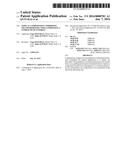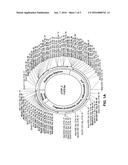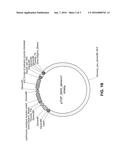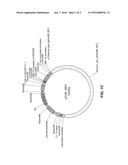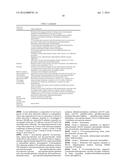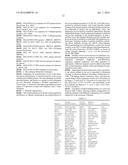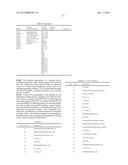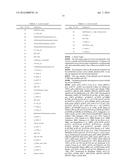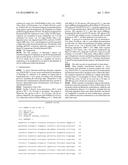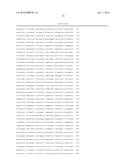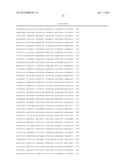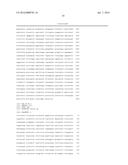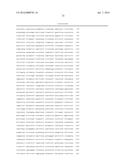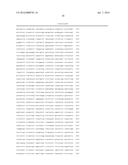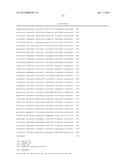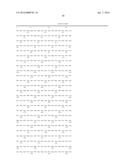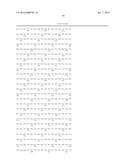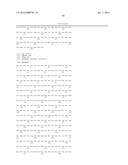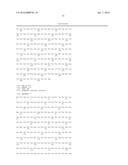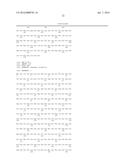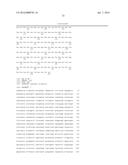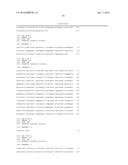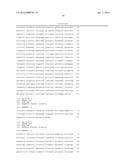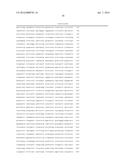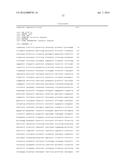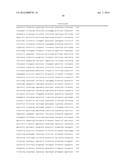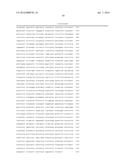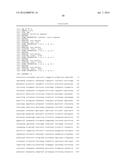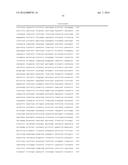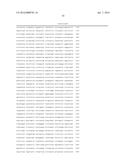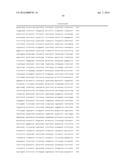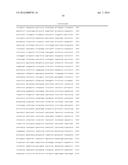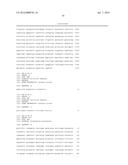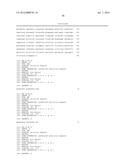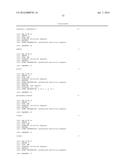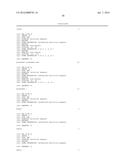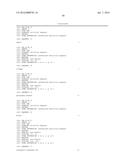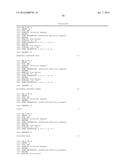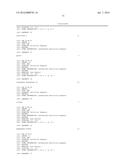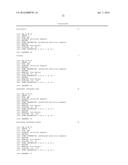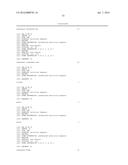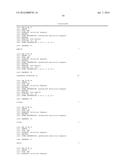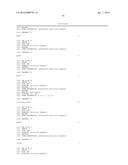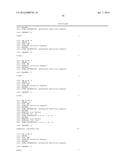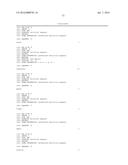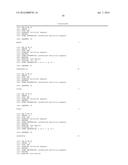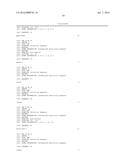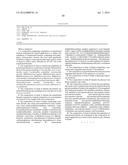Patent application title: TOPICAL COMPOSITION COMPRISING TRANSFORMED BACTERIA EXPRESSING A COMPOUND OF INTEREST
Inventors:
Noga Qvit-Raz (Menlo Park, CA, US)
Tahel Altman (Menlo Park, CA, US)
IPC8 Class: AA61K899FI
USPC Class:
424 60
Class name: Drug, bio-affecting and body treating compositions topical sun or radiation screening, or tanning preparations aromatic acid or derivative containing (e.g., aminobenzoic acid or methyl salicylate, etc.)
Publication date: 2016-01-07
Patent application number: 20160000701
Abstract:
Compositions comprised of a population of transformed bacteria formulated
for topical application to a subject are described. The population of
transformed bacteria are created from a non-pathogenic bacteria and
transformed to express a compound of interest for a therapeutic or a
cosmetic purpose. In one embodiment, the composition is for protection of
the skin from ultraviolet rays.Claims:
1. A composition comprising a population of transformed bacteria
formulated for topical application to a subject, the population of
transformed bacteria comprising non-pathogenic, Gram-positive bacteria
that have been genetically modified to express a mycosporine-like amino
acid at a level of about 0.1 mM to about 100 mM for 10.sup.2-10.sup.20
cfu of the transformed bacteria.
2. The composition of claim 1 wherein the population of transformed bacteria is created from a bacteria selected from those in the group consisting of Lactobacillus cesei, Lactobacillus reuteri, Lactobacillus acidophilus, Lactobacillus jensenii, Bifidobacterium lognum, Bifidobacterium reuteri, Bifidobacterium lactis, Bifidobacterium breve, Bifidobacterium animalis, Propionibacterium acidipropionici, Propionibacterium freudenreichii, Propionibacterium thoenii, aRG--Propionibacterium jensenii, Lactobacillus lactis, Lactobacillus rhamnosus, Lactococcus lactis, and Lactococcus plantarum.
3. The composition of claim 2 wherein the bacteria are selected from the group consisting of Lactobacillus lactis and Lactococcus lactis.
4. The composition of claim 1 wherein the transformed bacteria is present in a topical composition at a concentration of at least 0.1% by weight of the total composition.
5. The composition of claim 1 further comprising a titanium dioxide, zinc oxide, para-aminobenzoic acid, avobenzone, butyl methoxydibenzoylmethane, ensulizole, 2-phenylbenzimidazole-5-sulfonic acid, homosalate, homomethylsalicylat, meradimate, menthyl 2-minobenzoate, menthylanthranilate, octinoxate, menthyl 2-minobenzoate menthylanthranilate, octisalate, 2-ethylhexyl salicylate, octyl salicylate, octocrylene, 2-ethylhexyl-2-cyano-3,3 diphenylacrylate, oxybenzone, benzophenone-3,2-hydroxy-4-methoxybenzophenone, sulisobenzone, benzophenone-4, drometrizoletrisiloxane, mexoryl XL, enzacamene, 4-Methylbenzylidene camphor, padimate-O, octyl dimethyl PABA, σ-PABA, terephthalylidene dicamphor sulfonic acid, mexoryl SX, 3,3'-(1,4-phenylenedimethylidene)bis[7,7-dimethyl-2-oxobicylclo[2.2.1]hep- t-1-yl methanesulfonic acid), cinoxate, 2-ethoxyethyl 3-(4-methoxyphenyl) propenoate, diethanolamine-methoxycinnamate, dioxybenzone, benzophenone-8, (2-hydroxy-4-methoxyphenyl)-(2-hydroxyphenyl) methanone, triethanolamine salicylate, or trolamine salicylate.
6. The composition of claim 1 further comprising a sunscreen active ingredient that absorbs UVB radiation.
7. The composition of claim 6 wherein the sunscreen active ingredient that absorbs UVB radiation is octocrylene.
8. The composition of claim 1 further comprising a physical sun block.
9. The composition of claim 8 wherein the physical sun block comprises zinc oxide.
10. The composition of claim 1 wherein the mycosporine-like amino acid is selected from the group selected from the group consisting of Gadusol, deoxygadusol, 4-Deoxygadusol (S2), shinorine, porphyra-334, palythine, palythene, asterina-330, palythinol, mycosporine-glycine, mycosporine serinol, mycosporine-taurine, mycosporine-glycine-valine, mycosporine-2-glycine, mycosporine-glycine-glutamic acid, mycosporine-glutamic acid-glycine, mycosporine-methylamine-serine, mycosporine-methylamine-threonine, usujirene, dehydroxylusujirene, palythenic acid-337, palythenic acid-335, palythenic-serine, palythine-threonine, palythine-threonine-sulphate, palythenic-serine-sulphate, euhalothece, mycosporine-alanine (2-(e)-2,3-dihydroxipro-1-enylimino-mycosporine-alanine), and Scytonemin.
11. The composition of claim 1 wherein the population of transformed bacteria are formulated in the composition for topical application as a cream, lotion, emulsion, gel, ointment or liquid.
Description:
CROSS-REFERENCE TO RELATED APPLICATIONS
[0001] This application is a continuation of U.S. application Ser. No. 13/961,845, filed Aug. 7, 2013, which application claims the benefit of U.S. Provisional Application No. 61/680,620, filed Aug. 7, 2012, and of U.S. Provisional Application No. 61/836,594, filed Jun. 18, 2013, each of which is incorporated herein by reference in its entirety.
REFERENCE TO SEQUENCE LISTING, TABLE OR COMPUTER PROGRAM
[0002] A Sequence Listing was submitted electronically via EFS in parent application Ser. No. 13/961,845 in the form of a text file, created Dec. 23, 2013, and named "093242-0016-seqlist_ST25.txt" (88,802 bytes), and is resubmitted herewith.
TECHNICAL FIELD
[0003] The subject matter described herein relates to the field of dermatology, and more particularly, to compositions and methods of treatment that comprise transformed bacteria that express a molecule or compound for a topical therapeutic, cosmetic or dermatological purpose.
BACKGROUND
[0004] There are a spectrum of dermatological disorders and conditions that are commonly treated with a topically applied agent. In some treatments, the agent offers a therapeutic purpose, for example for treating or ameliorating psoriasis, eczema or dermatitis. In other treatments, the agent offers a cosmetic or protective effect, such as a skin lightening agent or depigmenting agent or a sun protective agent. Topical application of agents for cosmetics and medical purposes has certain limitations. For example, the applied agent can be swept off easily from the skin or the formulation in which the agent is applied can include chemicals that may interfere with the balance of the natural skin microbiota. Creams and ointments can be messy, greasy, cumbersome, and patients can only treat a limited number of lesions on a limited area, and only on certain anatomic sites. As a result, nearly 35% of prescriptions for topical preparations remained behind the pharmacy counter, the patient opting to not pick up the topical prescription. In contrast, prescriptions for systemic agents fared much better, with reports that only 14% went unredeemed (Storm, A. et al., J. Am. Acad. Dermatol., 59:27-33 (2008)).
[0005] There are also disadvantages with topical treatments in terms of the patient understanding of how often and how much to apply. In the case of sunscreens, as just one example, people typically apply sunscreens less than half as thickly as and less often than recommended, thus compromising their protection substantially (Stern, R. S., N Engl J. Med, 350:1526-1534 (2004)).
[0006] There remains a need for more effective topical treatment compositions, for medical, cosmetic and preventative purposes. By way of example, the need for more effective UV protection is recognized around the world, as it is the main cause for the increasing incidence of skin cancers and photoaging. By way of another example, topical treatment of psoriasis and eczema, and other skin disorders, with an effective, long-term therapy is needed.
[0007] Healthy human epidermis is colonized by thousands of bacterial species, including bacterial members from mainly five orders harboring about 60% of the total skin microbiome in all people. A healthy human epidermis is colonized with trillions of bacterial cells, creating, on average, approximately 108 bacteria per square centimeter. The skin microflora has evolved into commensal relationship with the host, as they exploit the unique attributes of the skin and keep the skin ecosystem in a healthy balance (Grice A. E., Science, 324: 1190-1192 (2009). A therapy that uses skin bacteria for different dermatological needs would be able to maintain the natural ecosystem of the skin, and also enhance those natural skin bacteria to address specific dermatological needs.
[0008] The use of probiotic micro-organisms for improving the skin's immune function under stress conditions, leading to immune suppression, specifically for normalizing the skin's immune activity and reducing the tendency to develop hyper-reactions under such conditions is described in the art, for example in EP Patent No. 1322318. Cosmetic use of probiotic microorganisms as an active agent useful for treating and/or preventing impairing radiance of the skin complexion has also been described (US2012/0301452). Use of solely probiotics, is one approach for topical skin treatments, yet there remains a need for a longer term and/or more potent approach.
[0009] Transformed bacteria are being used intensively in modern biotechnology for the production of recombinant proteins and various molecules for food, pharmaceutical, and biocatalysis applications. Bacteria able to produce and secrete proteins encoded by heterologous genes are used extensively for the industrial production of pharmaceutical proteins such as human and animal growth hormones, insulin, interferons, cytokines etc. Organisms other than E. coli thus far used or proposed for industrial production include cultured mammalian and insect cells, yeasts and fungi, and various bacteria species, including a number of Bacillus spp. Among the bacteria already widely used for industrial purposes are the lactic acid bacteria, which are employed as starter cultures for fermented foodstuffs, and as flavor enhancers, and preservatives. These properties depend on the ability of these organisms to produce certain enzymes, lactic acid and harmless antimicrobial polypeptides, such as nisin (see, for example. U.S. Pat. No. 6,221,648).
[0010] The foregoing examples of the related art and limitations related therewith are intended to be illustrative and not exclusive. Other limitations of the related art will become apparent to those of skill in the art upon a reading of the specification and a study of the drawings.
BRIEF DESCRIPTION OF THE DRAWINGS
[0011] FIGS. 1A-1C are maps of exemplary plasmids or vectors for transforming a bacterium for expression of a compound of interest. Sequences corresponding to the restriction enzyme recognition sites indicated on the map of FIG. 1A are provided below in Table 1 with their respective SEQ ID NOs.
BRIEF SUMMARY
[0012] The following aspects and embodiments thereof described and illustrated below are meant to be exemplary and illustrative, not limiting in scope.
[0013] In one aspect, a composition comprising a population of transformed bacteria formulated for topical application to a subject is provided, where the population of transformed bacteria is created from a non-pathogenic bacteria transformed to express a compound of interest.
[0014] In one embodiment, the population of non-pathogenic bacteria comprises a bacteria that occurs naturally on the human skin; that is, the bacteria in the population are from the human skin microbiome. In another embodiment, the population of non-pathogenic bacteria is a population of live bacteria that express the compound of interest, and in one embodiment, that chronically express the compound of interest. In another embodiment, the population of non-pathogenic bacteria is a population of attenuated bacteria or killed (dead) bacteria, intact or fragments thereof, where the bacteria prior to attenuation or killing expressed the compound of interest.
[0015] In one embodiment, the compound of interest is one that can absorb or reflect ultraviolet light. In another embodiment, the compound can absorb or reflect ultraviolet A (320-400 nm), ultraviolet B (315-280 nm), or both.
[0016] In yet another embodiment, the compound of interest expressed by the transformed bacteria is selected from the group consisting of: mycosporine, gadusols, oxo-mycosporines, imino-mycosporines and mycosporine-like amino acids (MAAs), scytonemin, melanines, UV-screening/observing amino acids-like molecules, flavonoids, betalanines, UV-screening/observing pigments (e.g. carotenoids/cartenoproteins, xanthopylls and porphyrin-based/heme-porphyrin based), UV-screening/observing co-factors (e.g. tetrahydrobiopterin), phenylpropanoids, polyphenol (e.g. tannins), pycnogenol, tyrosinases (and its substrates and products), alpha hydroxy acids (AHAs), polysaccharides (e.g. glycosaminoglycans, (GAGs) or mucopolysaccharides), skin related cofactors, vitamin E, polymers, and additional skin related natural compounds, such as: collagen, keratin, elastin, linoleic acid, laminin, tretinoin, tazarotene, sargaquinoic acid, sargachromenol, fucoxanthin, retinoid, anti-inflammatory cytokines (as Il-2), cortisone, tacrolimus, ciclosporin, resveratrol, gallocatechol, gallocatechin, epigallocatechin gallate, retinoid, vitamin A, vitamin A derivatives, beta-carotene, vitamin D, vitamin A derivatives, moisture compounds; cortisone, tacrolimus and ciclosporin, DNA repair enzymes; photolyase, endonuclease and glycosylase.
[0017] In yet another embodiment, the population of transformed bacteria is formulated into the composition to provide at least about 102 bacteria per cm2, or at least about 103, 104, 105, or 106 bacteria per cm2.
[0018] In another embodiment, the composition comprises a second population of transformed bacteria formulated for topical application to a subject, wherein the second population of transformed bacteria is either or both (i) created from a non-pathogenic bacteria that is different from the first population of transformed bacteria in the composition or (ii) transformed to express a compound of interest that is different from the first compound of interest expressed by the first population of transformed bacteria in the composition. In other embodiments, the composition comprises at least one population of transformed bacteria, at least two populations of transformed bacteria, or two or more populations of transformed bacteria.
[0019] In one embodiment, the second population of non-pathogenic bacteria is from the human skin microbiome. In another embodiment, the second population of non-pathogenic bacteria is a population of live bacteria that express the compound of interest, and in one embodiment, chronically express the compound of interest. In another embodiment, the second population of non-pathogenic bacteria is a population of attenuated bacteria or killed (dead) bacteria, intact or fragments thereof, where the bacteria prior to attenuation or killing expressed the compound of interest.
[0020] In still another embodiment, the compound of interest is one for treating psoriasis. Exemplary compounds include, but are not limited to, a compound selected from the group consisting of retinoid, vitamin A, beta-carotene, vitamin D, anti-inflammatory cytokines.
[0021] In one embodiment, the compound of interest is an anti-oxidant.
[0022] In yet another embodiment, the compound is selected from the group consisting of resveratrol, vitamin E, vitamin C, -epigallocatechin-3-gallate, and retinyl palmitate (retinoids), lutein, tamarind, flavonoids, pycnogenol, lycopene.
[0023] In another embodiment, the compound of interest provides a cosmetic effect. For example, the compound may be selected from the group consisting of coenzyme Q10, tyrosinases, collagen, laminin, ceramids, linoleic acid, tretinoin, tazarotene and collagen. In still another embodiment, the cosmetic effect is anti-aging.
[0024] In still another embodiment, the compound of interest is one that treats eczema. Exemplary compounds of interest include a compound is selected from the group consisting of cortisone, tacrolimus and ciclosporin.
[0025] In other embodiments, the composition comprising the population of transformed bacterial is formulated for topical application to the face. In another embodiment, the composition is formulation for topical application to the skin, excluding mucosal surfaces of the human body.
[0026] In another embodiment, the population of transformed bacteria is created from a population of non-pathogenic bacteria resident on the skin in humans. That is, the population of non-pathogenic bacteria comprise a bacteria typically resident on skin in healthy, non-diseased human beings.
[0027] The population of transformed bacteria is created, in some embodiments, from nonpathogenic bacterial members selected from those in the group consisting of Actinomycetales, Anaerococcus, Bacillales, Bifidobacterium, Enhydrobacter, Finegoldia, Carnobacterium, Coryneobacterium, Lactobacillus, Lactococcus, Leunconostoc, Macrooccus, Micrococcineae, Oenococcus, Pediococcus, Peptoniphilus, Propionibacterium, Salinicoccus, Sphingomonas, Strepococcus, Tetragenoccus, and Weissella.
[0028] In other embodiments, the transformed bacteria in the population of transformed bacterial are not Propionibacterium acnes, a pathogenic strain of Coryneobacterium, S. aureus, or S. epidermidis.
[0029] In still another embodiment, the population of transformed bacteria is created from a bacteria selected from those in the group consisting of Lactobacillus casei, Lactobacillus reuteri, Lactobacillus acidophilus, Lactobacillus jensenii, Bifidobacterium lognum, Bifidobacterium reuteri, Bifidobacterium lactis, Bifidobacterium breve, Bifidobacterium animalis, Propionibacterium acidipropionici, Propionibacterium freudenreichii, Propionibacterium thoenii, and Propionibacterium jensenii.
[0030] In yet another embodiment, the population of transformed bacteria is created from a bacteria selected from those in a phylum selected from the group consisting of gamma-proteobacteria, alpha-proteobacteria, and bacteriodetes.
[0031] The topical composition that comprises the population of transformed bacteria can be, in various embodiments, a cream, lotion, emulsion, gel, ointment, liquid or spray. In one embodiment, the topical composition is formulated to provide at least about 102 bacteria per cm2.
[0032] In another aspect, a method of treatment is provided, wherein a composition as described herein is topically applied to the skin of a subject, preferably a human subject, for disease preventative, or for a therapeutic or cosmetic purpose. In embodiment, topically applying excludes topically applying to a mucosal surface (nasal, vaginal, rectal, oral surfaces) of a human body.
[0033] In addition to the exemplary aspects and embodiments described above, further aspects and embodiments will become apparent by reference to the drawings and by study of the following descriptions.
[0034] Additional embodiments of the present methods and compositions, and the like, will be apparent from the following description, drawings, examples, and claims. As can be appreciated from the foregoing and following description, each and every feature described herein, and each and every combination of two or more of such features, is included within the scope of the present disclosure provided that the features included in such a combination are not mutually inconsistent. In addition, any feature or combination of features may be specifically excluded from any embodiment of the present invention. Additional aspects and advantages of the present invention are set forth in the following description and claims, particularly when considered in conjunction with the accompanying examples and drawings.
DETAILED DESCRIPTION
I. Definitions
[0035] Various aspects now will be described more fully hereinafter. Such aspects may, however, be embodied in many different forms and should not be construed as limited to the embodiments set forth herein; rather, these embodiments are provided so that this disclosure will be thorough and complete, and will fully convey its scope to those skilled in the art.
[0036] Where a range of values is provided, it is intended that each intervening value between the upper and lower limit of that range and any other stated or intervening value in that stated range is encompassed within the disclosure. For example, if a range of 1 μm to 8 μm is stated, it is intended that 2 μm, 3 μm, 4 μm, 5 μm, 6 μm, and 7 μm are also explicitly disclosed, as well as the range of values greater than or equal to 1 μm and the range of values less than or equal to 8 μm.
[0037] As used in this specification, the singular forms "a," "an," and "the" include plural referents unless the context clearly dictates otherwise. Thus, for example, reference to an "excipient" includes a single excipient as well as two or more of the same or different excipients.
[0038] "Amphiphilic" refers to a molecule combining hydrophilic and lipophilic (hydrophobic) properties.
[0039] "Diluents" may be included in the formulations to dissolve, disperse or otherwise incorporate another component in the formulation. Examples of diluents include, but are not limited to, water, buffered aqueous solutions, organic hydrophilic diluents, such as monovalent alcohols, and low molecular weight glycols and polyols (e.g. propylene glycol, polypropylene glycol, glycerol, butylene glycol).
[0040] A "gel" is a colloid in which the dispersed phase has combined with the continuous phase to produce a semisolid material, such as jelly.
[0041] "Hydrophilic" as used herein refers to substances that have strongly polar groups that readily interact with water.
[0042] "Hydrophobic" as used herein refers to substances that lack an affinity for water; tending to repel and not absorb water as well as not dissolve in or mix with water.
[0043] "Lipid soluble" as used herein refers to substances that have a solubility of greater than or equal to 5 g/100 mL in a hydrophobic liquid, such as castor oil.
[0044] "Lipophilic" refers to compounds having an affinity for lipids. Examples of lipophilic substances include but are not limited to naturally occurring and synthetic oils, fats, fatty acids, lecithins, triglycerides and combinations thereof.
[0045] An "oil" is a composition containing at least 95% wt of a lipophilic substance.
[0046] "Skin" intends to denote all of the epidermis of an individual, in particular a human being, and in some embodiments to intend, where specified, particular regions of the skin, such as the face, neck, arms, legs, abdomen, hands, back, buttocks, or feet.
[0047] "Water soluble" as used herein refers to substances that have a solubility of greater than or equal to 5 g/100 mL water.
II. Topical Composition
[0048] The composition described herein is comprised of a population of transformed bacteria formulated for topical application to a subject. Described in section A below are exemplary non-pathogenic bacteria suitable for creating the population of transformed bacteria. In section B, compounds of interest to be expressed by the population of transformed bacteria are described, and in section C techniques for creating the transformed bacterial population are set forth. In section D, topical compositions comprising the population of transformed bacteria are disclosed.
[0049] A. Exemplary Bacteria
[0050] The population of bacteria in the compositions described herein and for use in the described methods is created from a non-pathogenic bacterium that has been genetically modified to express, produce and/or secrete a compound of interest. In this section, exemplary non-pathogenic bacteria are described. In one embodiment, the bacteria in the population are non-pathogenic and non-invasive microorganisms, and can be in certain embodiments a gram-positive food grade bacterial strain. In another embodiment, the populations of transformed bacteria are prepared from a bacterium that occurs naturally in the skin microbiome.
[0051] Human skin is populated with microorganisms that reside on the skin, referred to as the skin microbiome. The bacterial microorganisms resident on the skin (in a healthy (non-diseased) human) are usually non-pathogenic and commensal (not harmful to the host) and/or mutualistic (offer a benefit). The bacteria commonly resident on the human skin are set forth in below, and are indicated by phylogenetic levels, described with their phylogenetic lineage, down to the genus level (Grice, E. A. et al., Science, 324(5931):11904192 (2009); Costello, E. K., et al. Science, 326(5960):1694-1697 (2009), Grice E. A. and J. A. Segre, Nature Reviews Microbiology, 9:244-253 (2011)).
[0052] The bacteria forming the population of bacteria in the composition, and that are transformed to express one or more compounds of interest, can be a collection of the same bacteria or a mixture of different bacteria, at different phylogenetic levels. In one embodiment, the populations of bacteria for transformation are a group of individuals of one bacterial species in an area that is separate from other groups of bacteria, apart from rare migration events. In practice, the size and nature of the area (e.g., size and location of area on skin, such as chin, forehead) is defined, often arbitrarily, for a desired purpose. In another embodiment, the bacteria for transformation to prepare the composition are a community of bacteria, intending a collection of populations of different bacteria species that occur together in space and time. In one embodiment, the community of bacteria includes all species (that is, across all trophic levels and/or phylogenetic levels), or, alternatively, includes all trophically similar species (for example, all the plants in a rainforest). In another embodiment, the bacteria for transformation to prepare the composition are a metapopulation, intending a group of populations that are perceived to exist as a series of local populations that are linked by migration between them. In another embodiment, the bacteria for transformation to prepare the composition are a metacommunity, intending an assemblage of trophically similar individuals and species, each of which is perceived to exist as a series of local communities, linked by the dispersal of potentially interacting species (Green, J. L. et al., Science, 320(5879):1039-43 (2008)).
[0053] Bacteria resident on the skin of healthy humans include bacterial species typically resident on the face of humans, such as Actinobacteria, including bacterial in the genus corynebacterium and in the genus propionibacterium. In other embodiments, bacteria resident on the skin of healthy human subjects include bacterial species typically resident on skin other than the face, including for example bacteria in the genus bacteroidetes and proteobacteria. Other bacteria in the skin microbiome include those listed herein below.
[0054] In one embodiment, the bacteria are from the genus Propionibacterium, including but not limited to, Propionibacterium acidifaciens, Propionibacterium acidipropionici, Propionibacterium acidipropionici strain 4900, Propionibacterium acnes, Propionibacterium australiense, Propionibacterium avidum, Propionibacterium cyclohexanicum, Propionibacterium freudenreichii subsp. Freudenreichii, P. freudenreichii ssp. freudenreichii strain 20271, Propionibacterium freudenreichii subsp. Shermanii, P. freudenreichii ssp. shermanii strain 4902, P. freudenreichii ssp. shermanii strain 4902, Propionibacterium granulosum, Propionibacterium innocuum, jensenii, P. jensenii strain 20278, Propionibacterium lymphophilum, Propionibacterium microaerophilum, Propionibacterium propionicum, Propionibacterium thoenii, and P. thoenii strain 20277.
[0055] In another embodiment, the bacteria are a population of bacteria classified as "generally regarded as safe" (GRAS) in the Propionibacterium genus, including but not limited to Propionibacterium acidipropionici, Propionibacterium freudenreichii subsp. Freudenreichii, Propionibacterium freudenreichii subsp. shermanii, Propionibacterium jensenii, and Propionibacterium thoenii. In one embodiment, the bacteria is not Propionibacterium acnes.
[0056] In one embodiment, the bacteria are from the genus Corynebacterium, including but not limited to, C. accolens, C. afermentan, C. amycolatum, C. argentoratense, C. aquaticum, C. auris, C. bovis, C. diphtheria, C. equi (now Rhodococcus equi), C. flavescens, C. glucuronolyticum, C. glutamicum, C. granulosum, C. haemolyticum, C. halofytica, C. jeikeium (group JK), C. macginleyi, C. matruchotii, C. minutissimum, C. parvum (Propionibacterium acnes), C. propinquum, C. pseudodiphtheriticum (C. hofmannii), C. pseudotuberculosis, (C. ovis), C. pyogenes, C. urealyticum (group D2), C. renale, C. spec, C. striatum, C. tenuis, C. ulcerans, C. urealyticum, and C. xerosis. Bacterial with lipophilic and nonlipophilic groups are contemplated, and the nonlipophilic bacteria may include fermentative corynebacteria and nonfermentative corynebacteria.
[0057] In another embodiment, the bacteria are a population of bacteria classified as "generally regarded as safe" (GRAS) in the Corynebacterium genus, including but not limited to Corynebacterium ammoniagenes, Corynebacterium casei, Corynebacterium flavescens, and Corynebacterium variabile.
[0058] In one embodiment, the bacteria is not C. diphtheria C. amicolatum, C. striatum, C. jeikeium, C. urealyticum, and C. xerosis, C. pseudotuberculosis, C. tenuis, C. striatum, or C. minutissimum, as these may be pathogenic.
[0059] In one embodiment, the bacteria are from the suborder Micrococcineae, including but not limited to the GRAS bacteria species Arthrobacter arilaitensis, Arthrobacter bergerei, Arthrobacter globiformis, Arthrobacter nicotianae, Kocuria rhizophila, Kocuria varians, Micrococcus luteus, Micrococcus Iylae, Microbacterium gubbeenense, Brevibacterium aurantiacum, Brevibacterium casei, Brevibacterium linens, Brachybacterium alimentarium, and Brachybacterium tyrofermentans.
[0060] In one embodiment, the bacteria are from the order Actinomycetales, including but not limited to the GRAS bacteria species Streptomyces griseus subsp. Griseus. In one embodiment, the bacteria Streptomyces griseus will not express tyrosinase.
[0061] In another embodiment, the bacteria are from the genus Staphylococcus, including but not limited to, Staphylococcus agnetis, S. arlettae, S. auricularis, S. capitis, S. caprae, S. camosus, Staphylococcus caseolyticus, S. chromogenes, S. cohnii, S. condiment, S. delphini, S. devriesei, S. equorum, S. felis, S. fleurettii, S. gallinarum, S. haemolyticus, S. hominis, S. hyicus, S. intermedius, S. kloosii, S. leei, S. lentus, S. lugdunensis, S. lutrae, S. massiliensis, S. microti, S. muscae, S. nepalensis, S. pasteuri, S. pettenkoferi, S. piscifermentans, S. pseudintermedius, S. pseudolugdunensis, S. pulvereri, S. rostra, S. saccharolyticus, S. saprophyticus, S. schleiferi, S. sciuri, S. simiae, S. simulans, S. stepanovicii, S. succinus, S. vitulinus, S. wameri, and S. xylosus.
[0062] In another embodiment, the bacteria are a population of bacteria classified as "generally regarded as safe" (GRAS) in the order of Staphylococcus, including but not limited to, Staphylococcus camosus subsp. Camosus, Staphylococcus camosus subsp. Utilis, Staphylococcus cohnii, Staphylococcus condimenti, Staphylococcus equorum subsp. Equorum, Staphylococcus equorum subsp. Linens, Staphylococcus fleurettii, Staphylococcus piscifermentans, Staphylococcus saprophyticus, Staphylococrus sduri subsp. Sduri, Staphylococcus succinus subsp succinus, Staphylococcus succinus subsp. Casei, Staphylococcus vitulinus, Staphylococcus wameri, and Staphylococrus xylosus.
[0063] In one embodiment, the bacteria is not S. aureus or S. epidermidis.
[0064] In another embodiment, the bacteria are from the genus Streptococcus, including but not limited to, Streptococcus acidominimus, Streptococcus adjacens, Streptococcus agalactiae, Streptococcus alactolyticus, Streptococcus anginosus, Streptococcus australis, Streptococcus bovis, Streptococcus caballi, Streptococcus canis, Streptococcus caprinus, Streptococcus castoreus, Streptococcus cecorum, Streptococcus constellatus, Streptococcus constellatus subsp. Constellatus, Streptococcus constellatus subsp. Pharyngis, Streptococcus cremoris, Streptococcus criceti, Streptococcus cristatus, Streptococcus danieliae, Streptococcus defectives, Streptococcus dentapri, Streptococcus dentirousetti, Streptococcus didelphic, Streptococcus difficilis, Streptococcus durans, Streptococcus dysgalactiae, Streptococcus dysgalactiae subsp. Dysgalactiae, Streptococcus dysgalactiae subsp. Equisimilis, Streptococcus entericus, Streptococcus equi, Streptococcus equi subsp. Equi, Streptococcus equi subsp. Ruminatorum, Streptococcus equi subsp. Zooepidemicus, Streptococcus equines, Streptococcus faecalis, Streptococcus faecium, Streptococcus ferus, Streptococcus gallinaceus, Streptococcus gallolyticus, Streptococcus gallolyticus subsp. Gallolyticus, Streptococcus gallolyticus subsp. Macedonicus, Streptococcus gallolyticus subsp. Pasteurianus, Streptococcus garvieae, Streptococcus gordonii, Streptococcus halichoeri, Streptococcus hansenii, Streptococcus henryi, Streptococcus hyointestinalis, Streptococcus hyovaginalis, Streptococcus ictaluri, Streptococcus infantarius, Streptococcus infantarius subsp. Coli, Streptococcus infantarius subsp. Infantarius, Streptococcus infantis, Streptococcus iniae, Streptococcus intermedius, Streptococcus intestinalis, Streptococcus lactarius, Streptococcus lactis, Streptococcus lactis subsp. Cremoris, Streptococcus lactis subsp. Diacetilactis, Streptococcus lactis subsp. Lactis, Streptococcus lutetiensis, Streptococcus macacae, Streptococcus macedonicus, Streptococcus marimammalium, Streptococcus massiliensis, Streptococcus merionis, Streptococcus minor, Streptococcus mitis, Streptococcus morbillorum, Streptococcus mutans, Streptococcus oligofermentans, Streptococcus oxalis, Streptococcus orisratti, Streptococcus ovis, Streptococcus parasanguinis, Streptococcus parauberis, Streptococcus parvulus, Streptococcus pasteurianus, Streptococcus peroris, Streptococcus phocae, Streptococcus plantarum, Streptococcus pleomorphus, Streptococcus pluranimalium, Streptococcus plurextorum, Streptococcus pneumonia, Streptococcus porci, Streptococcus porcinus, Streptococcus porcorum, Streptococcus pseudopneumoniae, Streptococcus pseudoporcinus, Streptococcus pyogenes, Streptococcus raffinolactis, Streptococcus ratti, Streptococcus rupicaprae, Streptococcus saccharolyticus, Streptococcus salivarius, Streptococcus salivarius subsp. Salivarius, Streptococcus salivarius subsp. Thermophilus, Streptococcus sanguinis, Streptococcus shiloi, Streptococcus sinensis, Streptococcus sobrinus, Streptococcus suis, Streptococcus thermophilus, Streptococcus thoraltensis, Streptococcus tigurinus, Streptococcus troglodytae, Streptococcus troglodytidis, Streptococcus uberis, Streptococcus urinalis, Streptococcus vestibularis, and Streptococcus waius.
[0065] In another embodiment, the bacteria are a population of bacteria classified as "generally regarded as safe" (GRAS) in the genus Streptococcus, including but not limited to, Streptococcus thermophilus strain Th4, Streptococcus gallolyticus subsp. Macedonicus, Streptococcus salivarius subsp. Salivarius, and Streptococcus salivarius subsp. Thermophilus.
[0066] In another embodiment, the bacteria are from the genus Lactobacillus, including but not limited to, Lactococcus garvieae, Lactococcus lactis, Lactococcus lactis subsp. cremoris, Lactococcus lactis subsp. hordniae, Lactococcus lactis, Lactococcus lactis subsp. Lactis, Lactococcus piscium, Lactococcus plantarum, Lactococcus raffinolactis, Lactobacillus acetotolerans, Lactobacillus acidophilus, Lactobacillus agilis, Lactobacillus algidus, Lactobacillus alimentarius, Lactobacillus amylolyticus, Lactobacillus amylophilus, Lactobacillus amylovorus, Lactobacillus animalis, Lactobacillus aviarius, Lactobacillus aviarius subsp. araffinosus, Lactobacillus aviarius subsp. aviarius, Lactobacillus bavaricus, Lactobacillus bifermentans, Lactobacillus brevis, Lactobacillus buchneri, Lactobacillus bulgaricus, Lactobacillus camis, Lactobacillus casei, Lactobacillus casei subsp. alactosus, Lactobacillus casei subsp. casei, Lactobacillus casei subsp. pseudoplantarum, Lactobacillus casei subsp. rhamnosus, Lactobacillus casei subsp. tolerans, Lactobacillus catenaformis, Lactobacillus cellobiosus, Lactobacillus collinoides, Lactobacillus confusus, Lactobacillus coryniformis, Lactobacillus coryniformis subsp. coryniformis, Lactobacillus coryniformis subsp. torquens, Lactobacillus crispatus, Lactobacillus curvatus, Lactobacillus curvatus subsp. curvatus, Lactobacillus curvatus subsp. melibiosus, Lactobacillus delbrueckii, Lactobacillus delbrueckii subsp. bulgaricus, Lactobacillus delbrueckii subsp. delbrueckii, Lactobacillus delbrueckii subsp. lactis, Lactobacillus divergens, Lactobacillus farciminis, Lactobacillus fermentum, Lactobacillus formicalis, Lactobacillus fructivorans, Lactobacillus fructosus, Lactobacillus gallinarum, Lactobacillus gasseri, Lactobacillus graminis, Lactobacillus halotolerans, Lactobacillus hamsteri, Lactobacillus helveticus, Lactobacillus heterohiochii, Lactobacillus hilgardii, Lactobacillus homohiochii, Lactobacillus iners, Lactobacillus intestinalis, Lactobacillus jensenii, Lactobacillus johnsonii, Lactobacillus kandleri, Lactobacillus kefiri, Lactobacillus kefuranofaciens, Lactobacillus kefirgranum, Lactobacillus kunkeei, Lactobacillus lactis, Lactobacillus leichmannii, Lactobacillus lindneri, Lactobacillus malefermentans, Lactobacillus mali, Lactobacillus maltaromicus, Lactobacillus manihotivorans, Lactobacillus minor, Lactobacillus minutus, Lactobacillus mucosae, Lactobacillus murinus, Lactobacillus nagelii, Lactobacillus oris, Lactobacillus panis, Lactobacillus parabuchneri, Lactobacillus paracasei, Lactobacillus paracasei subsp. paracasei, Lactobacillus paracasei subsp. tolerans, Lactobacillus parakefiri, Lactobacillus paralimentarius, Lactobacillus paraplantarum, Lactobacillus pentosus, Lactobacillus perolens, Lactobacillus piscicola, Lactobacillus plantarum, Lactobacillus pontis, Lactobacillus reuteri, Lactobacillus rhamnosus, Lactobacillus rhamnosus strain 55a, Lactobacillus rimae, Lactobacillus rogosae, Lactobacillus ruminis, Lactobacillus sakei, Lactobacillus sakei subsp. camosus, Lactobacillus sakei subsp. sakei, Lactobacillus salivarius, Lactobacillus salivarius subsp. salicinius, Lactobacillus salivarius subsp. salivarius, Lactobacillus sanfranciscensis, Lactobacillus sharpeae, Lactobacillus suebicus, Lactobacillus trichodes, Lactobacillus uli, Lactobacillus vaccinostercus, Lactobacillus vaginalis, Lactobacillus viridescens, Lactobacillus vitulinus, Lactobacillus xylosus, Lactobacillus yamanashiensis, Lactobacillus yamanashiensis subsp. mali, Lactobacillus yamanashiensis subsp. Yamanashiensis and Lactobacillus zeae.
[0067] In another embodiment, the bacteria are a population of bacteria classified as "generally regarded as safe" (GRAS) in the genus Lactobacillus, including but not limited to, Lactobacillus acidophilus strain NP 28, Lactobacillus acidophilus strain NP51, Lactobacillus subsp. lactis strain NP7, Lactobacillus reuteri strain NCIMB 30242, Lactobacillus casei strain Shirota, Lactobacillus reuteri strain DSM 17938, Lactobacillus reuteri strain NCIMB 30242, Lactobacillus acidophilus NCFM, Lactobacillus rhamnosus strain HN001, Lactobacillus rhamnosus strain HN001 produced in a milk-based medium, Lactobacillus reuteri strain DSM 17938, Lactobacillus casei subsp. rhamnosus strain GG, Lactobacillus acidophilus, Lactobacillus lactis, Lactobacillus acetotolerans, Lactobacillus acidifarinae, Lactobacillus acidipisds, Lactobacillus acidophilus, Lactobacillus alimenmrius, Lactobacillus amylolyticus, Lactobacillus amylovorus, Lactobacillus brevis, Lactobacillus buchneri, Lactobacillus cacaonum, Lactobacillus casei subsp. Casei, Lactobacillus collinoides, Lactobacillus composti, Lactobacillus coryniformis subsp. Coryniformis, Lactobacillus crispatus, Lactobacillus crustorum, Lactobacillus curvatus subps. Curvatus, Lactobacillus delbrueckii subsp. Bulgaricus, Lactobacillus delbrueckii subsp. Delbrueckii, Lactobacillus delbrueckii subsp. Lactis, Lactobacillus dextrinicus, Lactobacillus diolivorans, Lactobacillus fabifermentans, Lactobacillus farciminis, Lactobacillus fermentum, Lactobacillus fructivorans, Lactobacillus frumenti, Lactobacillus gasseri, Lactobacillus ghanensis, Lactobacillus hammesii, Lactobacillus harbinensis, Lactobacillus helveticus, Lactobacillus hilgardii, Lactobacillus homohiochii, Lactobacillus hordei, Lactobacillus jensenii, Lactobacillus johnsonii, Lactobacillus kefiri, Lactobacillus kefiranofadens subsp. Kefiranofaciens, Lactobacillus kefiranofadens subsp. Kefirgranum, Lactobacillus kimchii, Lactobacillus kisonensis, Lactobacillus mali, Lactobacillus manihotivorans, Lactobacillus mindensis, Lactobacillus mucosae, Lactobacillus nagelii, Lactobacillus namurensis, Lactobacillus nantensis, Lactobacillus nodensis, Lactobacillus oeni, Lactobacillus otakiensis, Lactobacillus panis, Lactobacillus parabrevis, Lactobacillus parabuchneri, Lactobacillus paracasei subsp. Paracasei, Lactobacillus parakefiri, Lactobacillus paralimentarius, Lactobacillus paraplantarum, Lactobacillus pentosus, Lactobacillus perolens, Lactobacillus plantarum subsp. Plantarum, Lactobacillus pobuzihii, Lactobacillus ponds, Lactobacillus rapi, Lactobacillus reuteri, Lactobacillus rhamnosus, Lactobacillus rossiae, Lactobacillus sakei subsp carnosus, Lactobacillus sakei subsp. Sakei, Lactobacillus sali varius subsp. Salivarius, Lactobacillus sanfranciscensis, Lactobacillus satsumensis, Lactobacillus secaliphilus, Lactobacillus senmaizukei, Lactobacillus siliginis, Lactobacillus spicheri, Lactobacillus suebicus, Lactobacillus sunkii, Lactobacillus tucceti, Lactobacillus vacdnosterrus, Lactobacillus versmoldensis, and Lactobacillus yamanashiensis.
[0068] In another embodiment, the bacteria are from the genus Lactococcus, including but not limited to, Lactococcus Schleifer, Lactococcus chungangensis, Lactococcus fujiensis, Lactococcus garvieae, Lactococcus lactis, Lactococcus lactis subsp. Cremoris, Lactococcus lactis subsp. Hordniae, Lactococcus lactis subsp. Lactis, Lactococcus lactis subsp. Tructae, Lactococcus piscium, Lactococcus plantarum, and Lactococcus raffinolacti.
[0069] In another embodiment, the bacteria are a population of bacteria classified as "generally regarded as safe" (GRAS) in the genus Lactococcus, including but not limited to, Lactococcus lactis subsp. Cremoris, Lactococcus lactis subsp. lactis, and Lactococcus raffinolactis.
[0070] In another embodiment, the bacteria are from the genus Enterococcus, including but not limited to, the GRAS bacteria species Enterococcus durans, Enterococcus faecalis, and Enterococcus faecium.
[0071] In another embodiment, the bacteria are from the genus Tetragenococcus, including but not limited to, Tetragenococcus halophilus and Tetragenococcus koreensis.
[0072] In another embodiment, the bacteria are from the genus Weissella, including but not limited to, the GRAS bacteria species Weissella koreensis, Weissella paramesenteroides, Weissella thailandensis, Weissella confusa, Weissella beninensis, Weissella cibaria, Weissella fabaria, Weissella ghanensis, and Weissella hellenica.
[0073] In another embodiment, the bacteria are from the genus Leuconostoc, including but not limited to, the GRAS bacteria species Leuconostoc carnosum, Leuconostoc citreum, Leuconostoc fallax, Leuconostoc holzapfelii, Leuconostoc inhae, Leuconostoc kimchii, Leuconostoc lactis, Leuconostoc mesenteroides subsp. Cremoris, Leuconostoc mesenteroides subsp. Dextranicum, Leuconostoc mesenteroides subsp. Mesenteroides, Leuconostoc palmae, and Leuconostoc pseudomesenteroides.
[0074] In another embodiment, the bacteria are from the genus Oenococcus, including but not limited to, Oenococcus oeni.
[0075] In another embodiment, the bacteria are from the genus Salinicoccus, including but not limited to, Salinicoccus Ventosa, Salinicoccus albus, Salinicoccus alkaliphilus, Salinicoccus carnicancri, Salinicoccus halodurans, Salinicoccus hispanicus, Salinicoccus iranensis, Salinicoccus jeotgali, Salinicoccus kunmingensis, Salinicoccus luteus, Salinicoccus qingdaonensis, Salinicoccus roseus, Salinicoccus salsiraiae, Salinicoccus sesuvii, and Salinicoccus siamensis.
[0076] In another embodiment, the bacteria are from the genus of Macrococcus, including but not limited to, Macrococcus caseolyticus.
[0077] In another embodiment, the bacteria are from the order Bacillales, including but not limited to, the GRAS bacteria species Bacillus amyloliquefaciens, Bacillus coagulans, and Bacillus subbtilis.
[0078] In another embodiment, the bacteria in the population are not Finegoldia magna.
[0079] In another embodiment, the bacteria are from the genus of Anaerococcus, including but not limited to, the species Anaerococcus hydrogenalis, Anaerococcus lactolyticus, Anaerococcus murdochii, Anaerococcus octavius, Anaerococcus prevotii, Anaerococcus tetradius, and Anaerococcus vaginalis.
[0080] In another embodiment, the bacteria are from the genus of Peptoniphilus, including but not limited to, the species Peptoniphilus asaccharolyticus, Peptoniphilus coxii, Peptoniphilus duerdenii, Peptoniphilus gorbachii, Peptoniphilus harei, Peptoniphilus indolicus, Peptoniphilus ivorii, Peptoniphilus koenoeneniae, Peptoniphilus lacrimalis, Peptoniphilus methioninivorax, Peptoniphilus olsenii, and Peptoniphilus tyrrelliae.
[0081] In another embodiment, the bacteria are from the genus of Enhydrobacter, including but not limited to, the species Enhydrobacter aerosaccus.
[0082] In another embodiment, the bacteria are from the genus of Sphingomonas, including but not limited to, the species Sphingomonas abaci, Sphingomonas adhaesiva, Sphingomonas aerolata, Sphingomonas aestuarii, Sphingomonas alaskensis, Sphingomonas alpine, Sphingomonas aquatilis, Sphingomonas aromaticivorans, Sphingomonas asaccharolytica, Sphingomonas astaxanthinifaciens, Sphingomonas aurantiaca, Sphingomonas azotifigens, Sphingomonas capsulate, Sphingomonas changbaiensis, Sphingomonas chlorophenolica, Sphingomonas chungbukensis, Sphingomonas cloacae, Sphingomonas cynarae, Sphingomonas desiccabilis, Sphingomonas dokdonensis, Sphingomonas echinoides, Sphingomonas endophytica, Sphingomonas faeni, Sphingomonas fennica, Sphingomonas formosensis, Sphingomonas ginsengisoli, Sphingomonas ginsenosidimutans, Sphingomonas glacialis, Sphingomonas haloaromaticamans, Sphingomonas hankookensis, Sphingomonas herbicidovorans, Sphingomonas histidinilytica, Sphingomonas indica, Sphingomonas insulae, Sphingomonas japonica, Sphingomonas jaspsi, Sphingomonas jejuensis, Sphingomonas jinjuensis, Sphingomonas kaistensis, Sphingomonas koreensis, Sphingomonas laterariae, Sphingomonas leidyi, Sphingomonas macrogolitabida, Sphingomonas macrogoltabidus, Sphingomonas mali, Sphingomonas melonis, Sphingomonas molluscorum, Sphingomonas mucosissima, Sphingomonas natatoria, Sphingomonas oligophenolica, Sphingomonas oryziterrae, Sphingomonas panni, Sphingomonas parapaucimobilis, Sphingomonas paucimobilis, Sphingomonas phyllosphaerae, Sphingomonas pituitosa, Sphingomonas polyaromaticivorans, Sphingomonas pruni, Sphingomonas pseudosanguinis, Sphingomonas rosa, Sphingomonas roseiflava, Sphingomonas rubra, Sphingomonas sanguinis, Sphingomonas sanxanigenens, Sphingomonas sediminicola, Sphingomonas soli, Sphingomonas starnbergensis, Sphingomonas stygia, Sphingomonas subarctica, Sphingomonas suberifaciens, Sphingomonas subterranean, Sphingomonas taejonensis, Sphingomonas terrae, Sphingomonas trueperi, Sphingomonas ursincola, Sphingomonas wittichii, Sphingomonas xenophaga, Sphingomonas xinjiangensis, Sphingomonas yabuuchiae, Sphingomonas yanoikuyae, and Sphingomonas yunnanensis.
[0083] In another embodiment, the bacteria are GRAS species in the gamma-proteobacteria phylum, such as Halomonas elongata, Hafnia alvei, excluding Hafnia alvei.
[0084] In another embodiment, the bacteria are from the genus of Alpha-proteobacteria phylum, including but not limited to, the GRAS species Acetobacter aceti subsp. Aceti, Acetobacter fabarum, Acetobacter lovaniensis, Acetobacter malorum, Acetobacter orientalis, Acetobacter pasteurianus subsp. Pasteurianus, Acetobacter pomorum, Acetobacter syzygii, Acetobacter tropicalis Gluconacetobacter azotocaptans, Gluconacetobacter diazotrophicus, Gluconacetobacter entanii, Gluconacetobacter europaeus, Gluconacetobacter hansenii, Gluconacetobacter johannae, Gluconacetobacter oboediens, Gluconobacter oxydans, and Gluconacetobacter xylinus.
[0085] In another embodiment, the bacteria are Zymomonas mobilis subsp. Mobilis.
[0086] In another embodiment, the bacteria are from the Bacteriodetes phylum, including but not limited to, Bacteroides xylanisolvens strain DSM 23964.
[0087] In another embodiment, the bacteria are from the genus of Bifidobacterium, including but not limited to, Bifidobacterium adolescentis, Bifidobacterium adolescentis ATCC 15703, Bifidobacterium adolescentis L2-32, Bifidobacterium angulatum, Bifidobacterium, angulatum DSM 20098=JCM 7096, Bifidobacterium animalis, Bifidobacterium animalis subsp. Animalis, Bifidobacterium animalis subsp. animalis ATCC 25527, Bifidobacterium animalis subsp. Lactis, Bifidobacterium animalis subsp. lactis AD011, Bifidobacterium animalis subsp. lactis ATCC 27673, Bifidobacterium animalis subsp. lactis B420, Bifidobacterium animalis subsp. lactis BB-12, Bifidobacterium animalis subsp. lactis Bi-07, Bifidobacterium animalis subsp. lactis B1-04, Bifidobacterium animalis subsp. lactis BLC1, Bifidobacterium animalis subsp. lactis BS 01, Bifidobacterium animalis subsp. lactis CNCM 1-2494, Bifidobacterium animalis subsp. lactis DSM 10140, Bifidobacterium animalis subsp. lactis HN019, Bifidobacterium animalis subsp. lactis V9, Bifidobacterium asteroids, Bifidobacterium asteroides PRL2011, Bifidobacterium biavatii, Bifidobacterium bifidum, Bifidobacterium bifidum ATCC 29521=JCM 1255, Bifidobacterium bifidum BGN4, Bifidobacterium bifidum CECT 7366, Bifidobacterium bifidum DSM 20215, Bifidobacterium bifidum IPLA 20015, Bifidobacterium bifidum JCM 1254, Bifidobacterium bifidum LMG 13195, Bifidobacterium bifidum NCIMB 41171, Bifidobacterium bifidum PRL2010, Bifidobacterium bifidum S17, Bifidobacterium bombi, Bifidobacterium boum, Bifidobacterium breve, Bifidobacterium breve ACS-071-V-Sch8b, Bifidobacterium breve CECT 7263, Bifidobacterium breve DPC 6330, Bifidobacterium breve DSM 20213=JCM 1192, Bifidobacterium breve EX336960VC18, Bifidobacterium breve EX336960VC19, Bifidobacterium breve EX336960VC21, Bifidobacterium breve EX533959VC21, Bifidobacterium breve HPH0326, Bifidobacterium breve JCP7499, Bifidobacterium breve S27, Bifidobacterium breve UCC2003, Bifidobacterium callitrichos, Bifidobacterium catenulatum, Bifidobacterium catenulatum DSM 16992=JCM 1194, Bifidobacterium choerinum, Bifidobacterium choerinum DSM 20434, Bifidobacterium coagulans, Bifidobacterium indicum, Bifidobacterium kashiwanohense, Bifidobacterium kashiwanohense JCM 15439, Bifidobacterium longum, Bifidobacterium longum 3--1--37 DFAAB, Bifidobacterium longum AGR2137, Bifidobacterium longum BORI, Bifidobacterium longum D2957, Bifidobacterium longum DJO10A, Bifidobacterium longum NCC2705, Bifidobacterium longum subsp. Infantis, Bifidobacterium longum subsp. infantis 157F, Bifidobacterium longum subsp. infantis ATCC 15697=JCM 1222, Bifidobacterium longum subsp. infantis CCUG 52486, Bifidobacterium longum subsp. Longum, Bifidobacterium longum subsp. longum 1-6B, Bifidobacterium longum subsp. longum 2-2B, Bifidobacterium longum subsp. longum 35B, Bifidobacterium longum subsp. longum 44B, Bifidobacterium longum subsp. longum ATCC 55813, Bifidobacterium longum subsp. longum BBMN68, Bifidobacterium longum subsp. longum CECT 7347, Bifidobacterium longum subsp. longum CMCC P0001, Bifidobacterium longum subsp. longum F8, Bifidobacterium longum subsp. longum JCM 1217, Bifidobacterium longum subsp. longum JDM301, Bifidobacterium longum subsp. longum KACC 91563, Bifidobacterium longum subsp. Suis, Bifidobacterium magnum, Bifidobacterium magnum DSM 20222, Bifidobacterium coryneforme, Bifidobacterium crudilactis, Bifidobacterium cuniculi, Bifidobacterium dentium, Bifidobacterium dentium ATCC 27678, Bifidobacterium dentium ATCC 27679, Bifidobacterium dentium Bd1, Bifidobacterium dentium JCM 1195, Bifidobacterium dentium JCVIHMP022, Bifidobacterium gallicum, Bifidobacterium gallicum DSM 20093, Bifidobacterium gallinarum, Bifidobacterium simiae, Bifidobacterium stellenboschense, Bifidobacterium stercoris, Bifidobacterium subtile, Bifidobacterium subtile DSM 20096, Bifidobacterium merycicum, Bifidobacterium minimum, Bifidobacterium minimum DSM 20102, Bifidobacterium mongoliense, Bifidobacterium pseudocatenulatum, Bifidobacterium pseudocatenulatum D2CA, Bifidobacterium pseudocatenulatum DSM 20438=JCM 1200, Bifidobacterium pseudolongum, Bifidobacterium pseudolongum AGR2145, Bifidobacterium pseudolongum subsp. Globosum, Bifidobacterium pseudolongum subsp. Pseudolongum, Bifidobacterium psychraerophilum, Bifidobacterium pullorum, Bifidobacterium pullorum ATCC 49618, Bifidobacterium reuteri, Bifidobacterium ruminantium, Bifidobacterium saeculare, Bifidobacterium saguini, Bifidobacterium scardovii, Bifidobacterium scardovii JCM 12489, Bifidobacterium thermacidophilum, Bifidobacterium thermacidophilum subsp. Porcinum, Bifidobacterium thermacidophilum subsp. Thermacidophilum, Bifidobacterium thermophilum, Bifidobacterium thermophilum RBL67, Bifidobacterium tsurumiense, Bifidobacterium tsurumiense DSM 17777, Bifidobacterium sp. Bifidobacterium breve M-16V, Bifidobacterium animalis subsp. lactis strains HN019, Bi-07, B1-04 and B420, Bifidobacterium animalis subsp. lactis strain Bf-6, Bifidobacterium longum strain BB536, and Bifidobacterium lactis strain Bb12.
[0088] In another embodiment, the bacteria are from the genus of Carnobacterium, including but not limited to, Carnobacterium alterfunditum, Carnobacterium divergens, Carnobacterium funditum, Carnobacterium gallinarum, Carnobacterium inhibens, Carnobacterium jeotgali, Carnobacterium maltaromaticum, Carnobacterium maltaromaticum 38b, Carnobacterium maltaromaticum ATCC 35586, Carnobacterium maltaromaticum LMA28, Carnobacterium mobile, Carnobacterium pleistocenium, Carnobacterium viridians, Carnobacterium sp., Carnobacterium sp. `eilaticum 021211`, Carnobacterium sp. 11-1, Carnobacterium sp. 12266/2009, Carnobacterium sp. 13-3, Carnobacterium sp. 17-4, Carnobacterium sp. 22-6, Carnobacterium sp. 2673, Carnobacterium sp. 27L, Carnobacterium sp. 35L, Carnobacterium sp. 37-3-1, Carnobacterium sp. 38ANAV, Carnobacterium sp. 40L, Carnobacterium sp. 7196, Carnobacterium sp. A, Carnobacterium sp. A2S10L14, Carnobacterium sp. A4, Carnobacterium sp. A726, Carnobacterium sp. aG53, Carnobacterium sp. ARCTIC-P2, Carnobacterium sp. ARCTIC-P26, Carnobacterium sp. ARCTIC-P35, Carnobacterium sp. AT12, Carnobacterium sp. AT7, Carnobacterium sp. B, Carnobacterium sp. B5, Carnobacterium sp. BA-81, Carnobacterium sp. BBDP54, Carnobacterium sp. BBDP71, Carnobacterium sp. BM-8, Carnobacterium sp. BM-81, Carnobacterium sp. C-13, Carnobacterium sp. c58, Carnobacterium sp. cG53, Carnobacterium sp. CM1, Carnobacterium sp. D35, Carnobacterium sp. D4, Carnobacterium sp. D5, Carnobacterium sp. EK-153, Carnobacterium sp. ES-11, Carnobacterium sp. FBT1-19, Carnobacterium sp. FBT1-22, Carnobacterium sp. FBT3-14, Carnobacterium sp. FBT3-9, Carnobacterium sp. FBT4-1, Carnobacterium sp. FBT4-18, Carnobacterium sp. G1516J1L, Carnobacterium sp. G4a-1, Carnobacterium sp. G5a-1, Carnobacterium sp. GCM1, Carnobacterium sp. H126a, Carnobacterium sp. Hg4-03, Carnobacterium sp. I-Bh20-14, Carnobacterium sp. I-Bh4-26, Carnobacterium sp. KA-2, Carnobacterium sp. KA-8, Carnobacterium sp. KH1, Carnobacterium sp. KOPRI80142, Carnobacterium sp. KOPRI80153, Carnobacterium sp. KOPRI80155, Carnobacterium sp. L02-6127, Carnobacterium sp. LIV10, Carnobacterium sp. LMG 26642, Carnobacterium sp. LV62:W1, Carnobacterium sp. LV66, Carnobacterium sp. M7-C10, Carnobacterium sp. MARL15, Carnobacterium sp. MKJ37, Carnobacterium sp. NFU35-25, Carnobacterium sp. NJ-46, Carnobacterium sp. R-36982, Carnobacterium sp. RI234, Carnobacterium sp. S171, Carnobacterium sp. S181, Carnobacterium sp. Sd5t18, Carnobacterium sp. Sd5t5, Carnobacterium sp. Sd6t1, Carnobacterium sp. Sd6t15, Carnobacterium sp. Sd6t17, Carnobacterium sp. Sd6t18, Carnobacterium sp. SR2-31-1, Carnobacterium sp. St2, Carnobacterium sp. T301, Carnobacterium sp. UI49, Carnobacterium sp. UPAA77, Carnobacterium sp. UST050418-652, Carnobacterium sp. WFPIS001, Carnobacterium sp. WN1359, Carnobacterium sp. WN1370, Carnobacterium sp. WN1371, Carnobacterium sp. WN1372, Carnobacterium sp. WN1373, Carnobacterium sp. WN1374, Carnobacterium sp. Y6, Carnobacterium divergens, Carnobacterium maltaromaticum, Carnobacterium piscicola, Carnobacterium maltaromaticum strain CB1 (viable and heat-treated), and Carnobacterium maltaromaticum strain CB1.
[0089] In another embodiment, the bacteria are from the genus of Pediococcus, including but not limited to, Pediococcus acidilactici, Pediococcus acidilactici 7--4, Pediococcus acidilactici D3, Pediococcus acidilactici DSM 20284, Pediococcus acidilactici MA18/5M, Pediococcus argentinicus, Pediococcus cellicola, Pediococcus claussenii, Pediococcus claussenii ATCC BAA-344, Pediococcus damnosus, Pediococcus damnosus 9-6b, Pediococcus ethanolidurans, Pediococcus inopinatus, Pediococcus lolii, Pediococcus lolii NGRI 0510Q, Pediococcus parvulus, Pediococcus parvulus CIRM 750, Pediococcus pentosaceus, Pediococcus pentosaceus ATCC 25745, Pediococcus pentosaceus IE-3, Pediococcus siamensis, Pediococcus stilesii, Pediococcus sp. 14.8.17, Pediococcus sp. BGM59, Pediococcus sp. BZ-2005, Pediococcus sp. CAT-100BC, Pediococcus sp. CR-6S, Pediococcus sp. CRA51, Pediococcus sp. EDB-LI4, Pediococcus sp. epsi2-MSE-E3-2, Pediococcus sp. epsi3l-MSE-E3-2, Pediococcus sp. FUA 3137, Pediococcus sp. FUA 3140, Pediococcus sp. FUA 3226, Pediococcus sp. GS4, Pediococcus sp. IBUN 186, Pediococcus sp. 1E3, Pediococcus sp. IJ-K1, Pediococcus sp. J-11, Pediococcus sp. KDLLL3-1, Pediococcus sp. L04, Pediococcus sp. LAB4012, Pediococcus sp. Lact10, Pediococcus sp. LQC 1953, Pediococcus sp. LQC 1957, Pediococcus sp. LQC 1963, Pediococcus sp. LQC 1966, Pediococcus sp. LQC 1972, Pediococcus sp. MB2C, Pediococcus sp. MB2D, Pediococcus sp. MFC1, Pediococcus sp. MMZ60A, Pediococcus sp. MUU10, Pediococcus sp. MUU13, Pediococcus sp. MUU2, Pediococcus sp. MUU3, Pediococcus sp. MUU4, Pediococcus sp. NBRC 106004, Pediococcus sp. NBRC 106014, Pediococcus sp. NBRC 106015, Pediococcus sp. NBRC 106028, Pediococcus sp. NBRC 106032, Pediococcus sp. NBRC 107178, Pediococcus sp. NBRC 107186, Pediococcus sp. NBRC 107193, Pediococcus sp. NBRC 107213, Pediococcus sp. NBRC 107218, Pediococcus sp. NBRC 107221, Pediococcus sp. NBRC 107222, Pediococcus sp. NBRC 107244, Pediococcus sp. NBRC 107250, Pediococcus sp. NBRC 107256, Pediococcus sp. NBRC 107260, Pediococcus sp. NBRC 107264, Pediococcus sp. NBRC 107299, Pediococcus sp. NBRC 107306, Pediococcus sp. NBRC 107309, Pediococcus sp. NBRC 107310, Pediococcus sp. NBRC 107331, Pediococcus sp. NBRC 107343, Pediococcus sp. NBRC 107346, Pediococcus sp. NBRC 107350, Pediococcus sp. NIR1, Pediococcus sp. NIR3, Pediococcus sp. omega41-FH-E3-2, Pediococcus sp. P14, Pediococcus sp. Pom3, Pediococcus sp. Pom4, Pediococcus sp. Pom7, Pediococcus sp. Pov5, Pediococcus sp. Pov7, Pediococcus sp. Pov8, Pediococcus sp. QCH-42, Pediococcus sp. QCH-66, Pediococcus sp. QCH-67, Pediococcus sp. QMA-03G, Pediococcus sp. QMA-06CH, Pediococcus sp. QMA-07G, Pediococcus sp. QMA-11, Pediococcus sp. QMA-21BC, Pediococcus sp. QMA-23BC, Pediococcus sp. QMA-24BC, Pediococcus sp. QMA-27BC, Pediococcus sp. Rrt8, Pediococcus sp. Rrt9, Pediococcus sp. Rrv1, Pediococcus sp. Rrv3, Pediococcus sp. S17, Pediococcus sp. S18, Pediococcus sp. SD2, Pediococcus sp. Shahsavar, Pediococcus sp. siga1, Pediococcus sp. T1R1C23, Pediococcus sp. T1R4C24, Pediococcus sp. Te6, Pediococcus sp. YCO-02, Pediococcus sp. YCO-04, Pediococcus sp. YCO-09, Pediococcus sp. YCO-10, Pediococcus sp. YCO-11, Pediococcus sp. YCO-12, Pediococcus sp. YCO-13, Pediococcus sp. YCO-16, Pediococcus sp. YCO-17, Pediococcus sp. YCO-18, Pediococcus sp. YCO-23, Pediococcus sp. YCO-25, Pediococcus sp. YCO-26, Pediococcus sp. YCO-28, Pediococcus sp. YXC-17, Pediococcus sp. Z-17, Pediococcus acidilactici strain NP3, Pediococcus acidilactici, Pediococcus acidilactici, Pediococcus parvulus, and Pediococcus pentosaceus.
[0090] In one embodiment, any bacteria, listed herein or otherwise known that is pathogenic and/or is an opportunistic pathogenic species is excluded. In another embodiment, the bacteria selected for transformation and to be included in the composition is any one of the bacterial genus listed herein or any one of the specific bacterial species listed herein, or any collection of first and second bacteria listed herein.
[0091] In one embodiment, the bacterial for use in the composition is any bacteria capable of existing on skin, in particular human skin, and more particularly bacteria that reside on human skin and are GRAS bacteria, excluding pathogenic and/or opportunistic bacteria.
[0092] In one embodiment, the composition comprises a population of transformed bacteria and a population of bacteria not transformed to express a compound of interest, e.g., the composition is comprised of a transformed bacteria population and a naturally occurring or probiotic bacteria. Compositions comprising more than one population of bacteria, wherein each population is a collection of individual transformed bacteria for expression of different compounds of interest, as each individual cell able to express more than one compound of interest or each individual cell express one compound, and the collection of different individuals expressing different molecules of interest express different compounds of interest, or wherein one population is transformed and one population is not transformed, are also contemplated. In one embodiment, the composition comprises first and second populations of transformed bacteria formulated for topical application to a subject. In one embodiment, the second population of transformed bacteria is either or both (i) created from a non-pathogenic bacteria that is different from the first population of transformed bacteria in the composition or (ii) transformed to express a compound of interest that is different from the first compound of interest expressed by the first population of transformed bacteria in the composition.
[0093] The bacteria may be included in a composition in a live, attenuated, semi-active or inactivated, or dead form. According to one particular embodiment, these bacteria are used in a live form, and are capable of chronically expressing the compound of interest upon topical application of the composition in which they are formulated. They may also be included in the form of cell component fractions or in the form of metabolites. The bacterial species(s), molecule(s) of interest or fraction(s) may also be introduced in the form of a lyophilized powder, of a culture supernatant, of harvested compound, and/or where appropriate, in a concentrated form.
[0094] According to one variation, the compositions may also contain a divalent inorganic cation. The compositions may be in any of the galenical forms usually available for the method of administration selected. The active molecule synthesized by the bacteria (which in one embodiment are skin bacteria) could be could either stay in the bacteria or secreted outside to the skin.
[0095] Limiting factors can control the bacterial growth. Such limiting factors can exist naturally on the skin and in one embodiment may be included in the composition that is to be applied topically to a subject to be treated. One or more limiting factors may be included in the formulation. In another embodiment the limiting factors are added to complementary products such as soaps, body wash, shampoo, lotion to enrich and nourish the composition, and to keep it active or alive. Examples for limiting factors include amino acids, biotin, nicotinamide and thiamine, pantothenate, riboflavin, folic acid, keratin, lipids, lactate, and melanins. A preferred limiting factor may be the amino acid L-alanin. Bacterial growth can be controlled by the mechanism of origin of replication to limit bacterial cycles. Bacterial cycles can be limited to 50 cycles, or bacterial cycles can be limited to 2-40 cycles. Limitation of bacterial growth can also be achieved by physical environmental factors as pH and temperature.
[0096] B. Exemplary Compounds of Interest
[0097] As described above, the bacteria species selected for the composition is transformed using known recombinant techniques to express a compound of interest. Exemplary compounds of interest are listed in Table 1 below, along with an indication of the skin disorder or condition or purpose for which the compound is used:
TABLE-US-00001 TABLE 1 Purpose of Compound Active compound UV protection Mycosporine, gadusols, oxo-mycosporines, imino-mycosporines and (sunscreen; UVA, mycosporine-like amino acids (MAA; glycosylated or covalently bound to UVB) oligosaccharides, oligosaccharide-linked MAAs). Intracellular or extracellular. Examples include: gadusol, deoxygadusol, 4-Deoxygadusol (S2), shinorine, porphyra-334, palythine, palythene, asterina-330, palythinol, mycosporine- glycine, mycosporine serinol, mycosporine-taurine, mycosporine-glycine- valine, mycosporine-2-glycine, mycosporine-glycine-glutamic acid, mycosporine-glutamic acid-glycine, mycosporine-methylamine-serine, mycosporine-methylamine-threonine, usujirene, dehydroxylusujirene, playthenic acid-337, playthenic acid-335, palythine-serine, palythine- threonine, palythine-threonine-sulphate, playthine-serine-sulphate, euhalothece, mycosporine-alanine (2-(e)-2,3-dihydroxipro-1-enylimino- mycosporine-alanine), scytonemin Molecules with sequence similarity to MAAs, such as dehydroquinate synthase homolog (DHQS homolog) and ATP-grasp Melamines, including eumelanin-(or dihydroxyphenylalanine (DOPA) melanins), pheomelanin allomelanins, pyomelanine, dopamelanin, neuromelanin UV-screening/observing amino acids-like molecules, such as urocanic acid Flavonoids, Anthocyanines and anthoxantins, and Anthocyanidins Betalanines, such as betacyanin and betaxanthins UV-screening/observing Pigments, such as Carotenoids/cartenoproteins, carotens, lycopene, xanthopylls, lutins, zeaxanthin, porphyrin-based/heme-porphyrin based, chlorophyll-II UV-screening/observing co-factors, such as tetrahydrobiopterin and phenylpropanoids Polyphenol, Tannins, Phlorotannins, dieckol, eckol, Flavan-3-ols or flavanols, pycnogenol sargaquinoic acid, sargachromenol, sphaerophorin (depside) pannarin (depsidone) DNA repair enzymes, that repair damage caused by exposure to UV, like photolyase, endonuclease and DNA glycosylases Psoriasis Retinoid, Vitamin A, beta-caroten, Vit D and it's derivatives, Anti-inflammatory cytokines such as Interleukin-2 (IL-2) Dry Skin Polymers, such as polyol and glycerol; skin related natural compounds, such as collagen, keratin, elastin, linoleic acid, laminin, tretinoin, tazarotene, sargaquinoic acid, sargachromenol, fucoxanthin, retinoid Relief of oxidative Tyrosinases (and its substrates and products) stress caused by UV; alpha hydroxy acids (AHAs), such as glycolic acid, lactic acid and citric acid Anti-Oxidants, Polysaccharides; Glycosaminoglycans, (GAGs) or mucopolysaccharides; Anti-reactive oxygen Hyaluronan (also called hyaluronic acid or hyaluronate or HA) species (Anti-ROS)/ Skin related cofactors, such as Vitamin A, Vitamin C or L-ascorbic acid, or Anti-Aging, simply ascorbate; Biopterin; Coenzyme A (CoA, CoASH, or HSCoA); moisturizing Coenzyme Q10, ubiquinone, ubidecarenone, coenzyme Q; CoQ10; and cosmetics Molybdopterin Vitamin E; alpha, beta, gamma, delta-tocopherols and alpha, beta, gamma, delta-tocotrienols Polymers, such as Polyol and Glycerol, Skin related natural compounds, such as collagen, keratin, elastin, linoleic acid, laminin, tretinoin, tazarotene, sargaquinoic acid, sargachromenol, fucoxanthin, retinoid, anti-inflammatory cytokines (such as IL-2), cortisone, tacrolimus, cyclosporine, resveratrol, gallocatechol, gallocatechin, epigallocatechin gallate Eczema cortisone, tacrolimus, cyclosporine Wound healing/ anaerobic bacteria delivering oxygen Diabetic wounds/Ulcers Intertrigo/ talcum, starch diaper rash
[0098] In one embodiment, a composition for use in protection of skin from ultraviolet radiation is contemplated. That is, the composition is for use as a sunscreen, to absorb or reflect ultraviolet A radiation, typically at a wavelength of between 320-400 nm, ultraviolet B radiation, typically at a wavelength of between 315-280 nm, or both UVA and UVB absorbing and/or reflecting. The transformed bacteria in the composition express one or more of the following exemplary compounds of interest in Group 1, Group 2, Group 3, Group 4, Group 5, Group 6, Group 7, Group 8, Group 9, Group 10, Group 11 and Group 12:
[0099] Group 1--mycosporine, gadusols, oxo-mycosporines, imino-mycosporines and mycosporine-like Amino Acids (MAA; glycosylated or covalently bound to oligosaccharides, oligosaccharide-linked MAAs); and/or intracellular or extracellular gadusol, deoxygadusol, 4-Deoxygadusol (S2), shinorine, porphyra-334, palythine, palythene, asterina-330, palythinol, mycosporine-glycine, mycosporine serinol, mycosporine-taurine, mycosporine-glycine-valine, mycosporine-2-glycine, mycosporine-glycine-glutamic acid, mycosporine-glutamic acid-glycine, mycosporine-methylamine-serine, mycosporine-methylamine-threonine, usujirene, dehydroxylusujirene, playthenic acid-337, playthenic acid-335, palythine-serine, palythine-threonine, palythine-threonine-sulphate, playthine-serine-sulphate, euhalothece, mycosporine-alanine (2-(e)-2,3-dihydroxipro-1-enylimino-mycosporine-alanine);
[0100] Group 2--Scytonemin;
[0101] Group 3--Melanines: eumelanin- (or dihydroxyphenylalanine (DOPA) melanins), pheomelanin allomelanins, pyomelanine, dopamelanin, neuromelanin;
[0102] Group 4--UV-screening/observing amino acids-like molecules: urocanic acid;
[0103] Group 5--Flavonoids: Anthocyanines and anthoxantins, Anthocyanidins;
[0104] Group 6--Betalanines: betacyanin, betaxanthins;
[0105] Group 7--Molecules with sequence similarity to MAAs: dehydroquinate synthase homolog (DHQS homolog), ATP-grasp;
[0106] Group 8--UV-screening/observing pigments: Carotenoids/cartenoproteins, carotens, lycopene, Xanthopylls, lutins, zeaxanthin, porphyrin-based/heme-porphyrin based, chlorophyll-II;
[0107] Group 9--UV-screening/observing co-factors, such as tetrahydrobiopterin and biopterin;
[0108] Group 10--Phenylpropanoids;
[0109] Group 11--Tannins: Phlorotannins, dieckol, eckol; and
[0110] Group 12--Sargaquinoic acid, sargachromenol, sphaerophorin (depside), pannarin (depsidone);
[0111] Group 13--DNA repair enzymes that repair damage caused by exposure to UV, such as photolyase, endonuclease, and DNA glycosylase.
[0112] In one embodiment, the compound of interest is any one of the compounds listed in any one of Groups 1-13 alone.
[0113] In another embodiment, a composition for use in providing relief of oxidative stress is contemplated, for use as a cosmetic or anti-aging composition. The composition may provide relief form UV exposure, as an anti-oxidant composition. The transformed bacteria in the composition express one or more of the following exemplary compounds of interest in Group 1, Group 2, Group 3, Group 4, Group 5, Group 6 and Group 7:
[0114] Group 1--Tyrosinases (and its substrates and products);
[0115] Group 2--Alpha hydroxy acids (AHAs): Glycolic acid, lactic acid, and citric acid;
[0116] Group 3--Polysaccharides: glycosaminoglycans, (GAGs), mucopolysaccharides, hyaluronan (also called hyaluronic acid or hyaluronate or HA);
[0117] Group 4--Skin related cofactors: Vitamin C or L-ascorbic acid, or simply ascorbate, Vitamin A, Biopterin, Coenzyme A (CoA, CoASH, or HSCoA), Coenzyme Q10 (ubiquinone, ubidecarenone, coenzyme Q, CoQ10), Molybdopterin;
[0118] Group 5--Vitamin E: alpha, beta, gamma, delta-tocopherols, alpha, beta, gamma, delta-tocotrienols;
[0119] Group 6--Polymers: Polyol, Glycerol;
[0120] Group 7--Additional skin related natural compounds, such as collagen, keratin, elastin, linoleic acid, laminin, tretinoin, tazarotene, sargaquinoic acid, sargachromenol, fucoxanthin, retinoid, anti-inflammatory cytokines (such as IL-2), cortisone, tacrolimus, ciclosporin, resveratrol, gallocatechol, gallocatechin, and epigallocatechin gallate.
[0121] In other embodiments, a composition for use in treating active dermatitis, acne, burns, insect bites, hives, dandruff and body odor is contemplated. A person of skill in the art can identify compounds of interest to be expressed in the transformed bacteria for treatment of these conditions.
[0122] Compounds having sequence similarity to the sequences of the compounds listed in the table above are also contemplated and may be regarded as identical compounds. Two sequences are said to be "substantially identical and identical" if the sequence of nucleotides or amino acid residues, respectively, in the two sequences has similarity of at least 40%, when aligned for maximum correspondence as described below. Alternatively, percent identity can be any integer from 20% to 100%. More preferred embodiments include at least: 20%, 25%, 30%, 35%, 40%, 45%, 50%, 55%, 60%, 65%, 70%, 75%, 80%, 85%, 90%, 91%, 92%, 93%, 94%, 95%, 96%, 97%, 98 or 99% compared to a reference sequence (e.g., SEQ ID NO:1, 2, 3, 4, 5, 6, 7, 8, 9, 10, 11, 12, 13, 14, 18) using the programs described herein, such as BLAST using standard parameters, as described below. This definition also refers to the complement of a test sequence, when the test sequence has substantial identity to a reference sequence.
[0123] Compounds having a conserved protein domain with sequence similarity to the sequences of the domains of the proteins of the compounds listed in the table above, are also contemplated and may be regarded as identical compounds.
[0124] For sequence comparison, typically one sequence acts as a reference sequence, to which test sequences are compared. When using a sequence comparison algorithm, test and reference sequences are entered into a computer, subsequence coordinates are designated, if necessary, and sequence algorithm program parameters are designated. Default program parameters can be used, or alternative parameters can be designated. The sequence comparison algorithm then calculates the percent sequence identities for the test sequences relative to the reference sequence, based on the program parameters.
[0125] Methods of alignment of sequences for comparison are well-known in the art. As the use of the following programs (provided by the National Center for Biotechnology Information) may be used to determine homologies/identities: BLAST, gapped BLAST, BLASTN and PSI-BLAST, which may be used with default parameters. Optimal alignment of sequences for comparison can be conducted by different methods known in the art, such as, but not limited to, the algorithms of Waterman, Needleman, Pearson, or by manual alignment and visual inspection.
[0126] Because of the degeneracy of the genetic code, a large number of functionally identical nucleic acids encode any given protein. One of skill will recognize the individual codon usage to a nucleic acid, peptide, polypeptide, or protein sequence that alters, adds or deletes a single amino acid or a small percentage of amino acids in the encoded sequence to allow the coding of the compound of interest.
[0127] It will be appreciated that the composition can be used in combination with existing topical compositions intended for treatment of the same or another disorder or condition. For example, the composition described herein for use as a sunscreen may be used in combination with a known sunscreen product, including: titanium dioxide (TiO2), zinc oxide (ZnO), para-aminobenzoic acid, avobenzone, butyl methoxydibenzoylmethane, ensulizole, 2-phenylbenzimidazole-5-sulfonic acid, homosalate, homomenthylsalicylat, meradimate, menthyl 2-minobenzoate, menthylanthranilate, octinoxate, menthyl 2-minobenzoate menthylanthranilate, octisalate, 2-ethylhexyl salicylate, octyl salicylate, octocrylene, 2-ethylhexyl-2-cyano-3,3 diphenylacrylate, oxybenzone, benzophenone-3,2-hydroxy-4-methoxybenzophenone, sulisobenzone, benzophenone-4, drometrizoletrisiloxane, mexoryl XL, enzacamene, 4-Methylbenzylidene camphor, padimate-O, octyl dimethyl PABA, σ-PABA, terephthalylidene dicamphor sulfonic acid, mexoryl SX, 3,3'-(1,4-phenylenedimethylidene)bis[7,7-dimethyl-2-oxobicylclo[2.2.1]hep- t-1-yl methanesulfonic acid), cinoxate, 2-ethoxyethyl 3-(4-methoxyphenyl) propenoate, diethanolamine-methoxycinnamate, dioxybenzone, benzophenone-8, (2-hydroxy-4-methoxyphenyl)-(2-hydroxyphenyl) methanone, triethanolamine salicylate, and trolamine salicylate.
[0128] Nucleic acid sequences coding for the compound of interest can be identified by those of skill in the art, and several examples are set forth herein as:
[0129] SEQ ID NO:1 DNA sequence for shinorine operon;
[0130] SEQ ID NO:2 DNA sequence for shinorine nostoc;
[0131] SEQ ID NO:3 AA sequence for Amino acid adenylation_Ava--3855;
[0132] SEQ ID NO:4 AA sequence for ATP-grasp enzyme-like protein_Ava--3856;
[0133] SEQ ID NO:5 AA sequence for O-methyltransferase, family 3_Ava--3857;
[0134] SEQ ID NO:6 AA sequence for 3-dehydroquinate synthase_Ava--3858;
[0135] SEQ ID NO:7 DNA Ava--3858--3_dehydroquinate synthase;
[0136] SEQ ID NO:8 DNA spacer1--4804128--4803953;
[0137] SEQ ID NO:9 DNA Ava--3857_O-methyltransferase;
[0138] SEQ ID NO:10 DNA spacer2--4803114--4803099;
[0139] SEQ ID NO:11 DNA Ava--3856_ATP-grasp enzyme-like protein;
[0140] SEQ ID NO:12 DNA Spacer3--4804128--4803953;
[0141] SEQ ID NO:13 DNA Ava--3855_Amino acid adenylation;
[0142] SEQ ID NO:16 DNA forward_primer_for shinorine_operon;
[0143] SEQ ID NO:17 DNA reverse_primer_for shinorine_operon; and
[0144] SEQ ID NO:18 DNA sequence for tyrosynase.
[0145] C. Recombinant Molecular Techniques
[0146] Techniques for transformation of any of the bacterial species listed herein or otherwise known in the art are understood by skilled artisans. Several techniques are briefly described herein, and factors to consider in such techniques are now discussed, including 1. Modular organization; 2. Vector types; 3. Expression and improving impression techniques; 4. Expression of insert and validation; and 5. Transformation.
[0147] 1. Modular Organization
[0148] The transformed bacterial strains can be regarded as cell factory, or vehicles, producing by any method known in the art recombinant proteins (U.S. Pat. No. 4,259,444, incorporated by reference herein), and would typically include cloning of the isolated nucleic acid molecule that encodes for the compound of interest into an appropriate vector. The expression vector is built in a modular organization, allowing independent design of each component in separate conditions and an easy exchange of all essential elements. In such a modular vector the essential elements typically include: replicon, promoter (constitutive or inducible with regulation system), gene of interest, marker or reporter, resistance or limiting factor, Multiple cloning site (MCS), shine-delgarno (ribosomal binding site), and terminators, as shown in several systems, as the NICE system (Mierau I and Kleerebezem M., Appl Microbiol Biotechnol. 68:705-17(2005), or based on cryptic plasmids (Shareck J. et al., Crit Rev Biotechnol. 24:155-208 (2004).
[0149] Suitable vectors can be chosen or constructed, containing appropriate regulatory sequences, including promoter sequences, terminator fragments, polyadenylation sequences, enhancer sequences, and other sequences as appropriate. Additional sequences may be added as described above which sequences include a ribosome binding site and a translation start codon.
[0150] Appropriate bacterial expression vectors are known to the person skilled in the art as described in Molecular Cloning: a Laboratory Manual: 2nd edition, Sambrook et al., 1989, Cold Spring Harbor Laboratory Press, and there are several studies shown expression vectors for LAB strains, as by Wang T. T. and Lee B. H., Plasmids in Lactobacillus. Crit Rev Biotechnol. 17:227-72 (1997), and specifically in the food industry by Nguyen T. T. et al., J Agric Food Chem. 59:5617-24 (2011).
[0151] Exemplary essential building blocks of a vector are listed in Table 2 below, allowing modular configuration of a backbone plasmid, with different combinations, for a suitable expression of the molecule of interest:
TABLE-US-00002 TABLE 2 Promoter- Promoter- Marker or Replicon inducible (inducer) constitutive reporter Terminator Ori + repA, Bacteriocin, dnaJ PermB, cml- LacZ p15A, p353-1, (from usp45; High PldhL, P1 chloramphenicol, terminator, p353-2, Temp), FOS, (SPL), P10 (alr) alanin lollypop P8014-2, gadC-GdR (low pH), (SPL), P11 racemase gene, structure, pA1-derived, grac-lac (IPTG), (SPL), P13 Abr, amp (Ap)- T1T2, pAI, pAM- lacA/lacC/lacR (SPL), P14 ampicillin, amyS, Tcat194, beta-1, (Lactose), lacA/T7 (SPL), P15 ccpA, cloxacillin, term667, pBG10, (Lactose), lacF, (SPL), P16 Cmr, ermL, term908, pBM02, lacG, lacS-GalR (SPL), P17 ery/ern- TpepA, pC194, (Lactose), lacZ, (SPL), P20 erythromycin TpepN, pCI305, NICE system, (SPL), P21, resistance marker, TsaiA pCI528, nisA/F/R/K/P P21 (SPL), estA, genes for pD125, (Nisin), orfX of P22 (SPL), TTFC, pFX1/3, sakacin Pregulon, P23, P23 gentamycin, GusA pG+, pGK12, PA170 (low pH, low (SPL), P25 (beta- pGT633, temp.), pgm, phi31 (SPL), P27 glucuronidas), pLA106, (and ori; phi (SPL), P29 Kanamycin, LacZ, pLAB1000, infection), Porf1, (SPL), P3 luxAB, msmR, pLB10, Porf330, PorfX, (SPL), P30 neomycin, nisI, pLC2, PpfkA, prtP or ptrM (SPL), P31 nsr, penicillin, PLF1311, (absence of (SPL), P32 PepN pLJ1, pLP1, peptides), PsapA, (weak), P33 (aminopeptidase pLP825, PsapA (sakacin A), (SPL), P34 N), pepO, ptsH, pLPE323, PsapiP, PslpA, (SPL), P35 streptomycin, PLUL631, PspplP (Sakacin P), (SPL), P38 tetracycline pND302, PsspA, PsspQ, Ptuf (SPL), P4 pND324, (CDM), Pusp45, (SPL), P40 pOri+, rep/op phi rlt (SPL), P41 pPM4, (Mitomycin C), (SPL), P42 pPSC, represser/operator (SPL), P43 pPSC20/22, phirlt (Mytomycin (SPL), P44 pSH71, C), sodA (Aeration), (SPL), P44 pSK11L, tec-Rro12 (high (weak), P46 pVS40, temp), hyA, tre, trpE (SPL), P47 pWC1, (absence of (SPL), pWS97, tryptophan), xylA P48(SPL), pWV01, (Xylose) P5 (SPL), pWV02, P59, P6 rep256, (SPL), P8 repD + E (SPL), P9 (SPL), Pami, Ppgm, Pspac, Pveg, PrRNA1-a, PrRNA1-b, PrRNA2-b, PrRNA3-a, PrRNA3-b, PrRNA4-a, PrRNA4-b, PrRNA5-a, PrRNA5-b, Pslp
[0152] The modular organization is a construct that is capable of expression of the coding sequence by the bacterial host cell. In particular such a vector is either an expression vector or a chromosomal integration vector, such as for example described in Steidler L. et al., Nature Biotechnology, 21(7):785-789 (2003), or by Perez-Arellano I. et al., Plasmid 46:106-16 (2001).
[0153] Vectors for transformation of the bacteria can be designed by skilled artisans. Examples are set forth in FIGS. 1A-C, and as a sequence in SEQ ID NO:15 (with restriction enzyme recognition sites (FIG. 1A)), and as in SEQ ID NO:14 (one embodiment of a shinorine operon). In one embodiment, the vector contains a compatible backbone origin of replication to the bacteria strain in use, a compatible promoter for the expression of molecule of interest, and a compatible resistance gene. The plasmid can contain sequences of restriction enzymes. Table 3 sets forth the sequences corresponding to the restriction enzyme recognition sites indicated on the map of FIG. 1A by a respective SEQ ID NO:
TABLE-US-00003 TABLE 3 Seq. ID No. Sequence 19 GCAnnnnnnTGCnnnnnnnnnn_nn' 20 GGAGnnnnnGTnnnnnnnnn_nnn' 21 ACnnnnnCTCCnnnnnnn_nnn' 22 C'GGCC_G 23 GTA'TAC 24 GACCGAnnnnnnnnn_nn' 25 Cy'CG_rG 26 C'yCGr_G 27 TCG'CGA 28 GCAnnnnnnTGCnnnnnnnnnn_nn' 29 GACnn_n'nnGTC 30 Gr'CG_yC 31 C'GGCC_G 32 AGT'ACT 33 AGG'CCT 34 T'CCnGG_A 35 GACCGAnnnnnnnnn_nn 36 G'TCGA_C 37 ACnnnnGTAyCnnnnnnn_nnnnn' 38 AAGnnnnnCTTnnnnnnnn_nnnnn' 39 GrTACnnnnGTnnnnnnnnnn_nnnnn 40 T'CTAG_A 41 CACCTGCnnnn'nnnn_ 42 CGTCTCn'nnnn_ 43 GAT'ATC 44 CTGAAGnnnnnnnnnnnnnn_nn' 45 CC'TCA_GC 46 GAGGAGnnnnnnnn_nn' 47 CGTCTCn'nnnn_ 48 CC'TnA_GG 49 TGAnnnnnnTCAnnnnnnnnnn_nn' 50 GrTACnnnnGTnnnnnnnnnn_nnnnn' 51 ACnnnnGTAyCnnnnnnn_nnnnn' 52 TGAnnnnnnTCAnnnnnnnnnn_nn' 53 CC'TCA_GC 54 GAT'ATC 55 GTA'TAC 56 CCAnnnn_n'nnnnTGG 57 rG'GnC_Cy 58 CTGAAGnnnnnnnnnnnnnn_nn' 59 T'CCnCG_A 60 T'CTAG_A 61 T'GTAC_A 62 G_AGCT'C 63 G_rGCy'C 64 GAG'CTC 65 CACCTGCnnnn'nnnn_ 66 G_CATG'C 67 r_CATG'y 68 TGC'GCA 69 Cy'CG_rG 70 C'TCGA_G 71 C'yCGr_G 72 AAGnnnnnCTTnnnnnnnn_nnnnn' 73 G_kGCm'C 74 A_TGCA'T 75 Caynn'nnrTG 76 G_rGCy'C 77 y'CCGG_r 78 AGG'CCT 79 TTA_AT'TAA 80 G_kGCm'C 81 r_GCAn_nnn'nTGC 82 r_CATG'y 83 A_TGCA'T 84 CAynn'nnrTG 85 GGATCnnnn'n_-dam methylated 86 G'GTnAC_C 87 GTT'AAC 88 C'CATG_G 89 GCTCTTCn'nnn_ 90 y'CCGG_r 91 C'CATG_G
[0154] 2. Vector Types
[0155] The four major types of vectors are plasmids, viral vectors, cosmids, and artificial chromosomes. Common to all engineered vectors are an origin of replication, a multicloning site, and a selectable marker. Any of these are suitable for use herein.
[0156] The sequence codes for the molecule of interest can be inserted into a clone, vector, shuttle, plasmid, BAC, or can also be integrated into the bacterial genome.
[0157] The copy number of the plasmid can be between 5-500 copy numbers per cell.
[0158] Exemplary plasmids and expression vectors include but are not limited to:
[0159] p252, p256, p353-2 (Leer et al. 1992), p8014-2, pA1, pACYC, pAJ01, pA1-derived (Vujcic & Topisirovic 1993), pall, pAM-beta1,2,3,5,8 (simon and chopin 1988), pAR1411, pBG10, pBK, pBM02, pBR322, pBR328, pBS-slpGFP, pC194 (McKenzie et al. 1986, 1987; Horinouchi & Weisblum 1982b), PC194/PUB110, pC30i1, pC30i1 (Skaugen 1989), pCD034-1, pCD034-2, pCD256, pCI2000, pCI305, pCI528, pCIS3, pCL2.1, pCT1138, pD125, pE194, pE194/PLS1, pEGFP-C1, pEH, pF8801, pFG2, pFK-series, pGK-series, pGK12, pGK13, pIA, pIAV1,5,6,7,9, pIL.CatT, pIL252/3, pIL253, pIL7, pISA (low for e. coli), pJW563, pKRV3, pLAB1000 (Josson et al. 1990), pLB4 (Bates & Gilbert 1989, pLBS, pLE16, pLEB124, pLEB590, pLEB591, pLEB600, pLEB604, pLEP24Mcop, pLJ1 (Takiguchi et al. 1989), pLKS, pLTK2, pWCFS101 and pMD5057 (Bates & Gilbert, 1989; Skaugen, 1989; Leer et al., 1992; Vujcic & Topisirovic, 1993; Eguchi et al., 2000; Kaneko et al., 2000; Danielsen, 2002; Daming et al., 2003; de las Rivas et al., 2004; van Kranenburg et al., 2005), pLP1/18/30, pLP18, pLP317, pLP317cop, pLP3537, pLP3537xy1, pLP402, pLP825, pLP825 and pLPE323, pLP82H, pLPC37, pLPE23M, pLPE323, pLPE350, pLPI (Bouia et al. 1989), pLS1, pLS1 and pE194 (Lacks et al. 1986; Horinouchi & Weisblum 1982a), plu1631, pLUL631 from L. reuteri carrying an erythromycin-resistance gene, pM3, pM4, pMD5057, pMG36e, pND324, pNZ-series, pPSC series, pSH71 (de vos, 1987), pSIP-series, pSK11L, pSL2, PSN2, pSN2 (Khan & Novick 1982), pT181 (Koepsel et al. 1987), (Khan & Novick 1983), pT181, pC194 and pE194 are not functional in B. subtilis (Gruss et al. 1987), pT181, pE194/pLS1, pC194/pUB110 and pSN2 (Khan, 2005), pTL, pTRK family, pTRT family, pTUAT35, pUB110 and pC194 (McKenzie et al. 1986, 1987; Horinouchi & Weisblum 1982b), pUCL22, pULP8/9, pVS40, pWC1, pWCFS101, pWV02, pWV04, pWV05, RepA, system BetL.
[0160] In one embodiment, the lactose phosphotransferase system, optionally linked to the E. coli bacteriophage T7 promoter; the L. lactis nisA promoter system; vectors comprising promoters regulated by environmental conditions, such as for example the P170 promoter that is only active at low pH. Another exemplary vector is a cosmid, a hybrid plasmid (often used as a cloning vector) that contains a Lambda phage cos sequence. (cos sites+plasmid=cosmid). DNA sequences are originally from the lambda phage, and cosmids can be used to build genomic libraries. Another example is a bacterial artificial chromosome (BAC), which is a DNA construct, based on a functional fertility plasmid (or F-plasmid), used for transforming and cloning in bacteria, usually E. coli. Suitable vectors can be chosen or constructed, containing appropriate regulatory sequences, including promoter sequences, terminator fragments, polyadenylation sequences, enhancer sequences, marker genes and other sequences as appropriate. Appropriate bacterial expression vectors are known to the person skilled in the art as described in Nouaille S. et al., Genetics and Molecular Research, 2:102-111 (2003), and in Maniatis, Sambrook and Fritsch, 1982. Molecular Cloning: A Laboratory Manual,
[0161] 3. Expression and Improving Expression Techniques
[0162] The term heterologous expression means that a protein, or gene of interest, is experimentally put into a cell that does not normally make (i.e., express) that protein e.g., to a cell, or nucleic acid, protein, or vector, indicates that the cell, nucleic acid, protein or vector, has been modified by the introduction of a heterologous nucleic acid or protein or the alteration of a native nucleic acid or protein, or that the cell is derived from a cell so modified. Thus, for example, recombinant cells express genes that are not found within the native (nonrecombinant) form of the cell or express native genes that are otherwise abnormally expressed, under-expressed or not expressed at all. Also, the nucleic acid is typically recombinantly produced, can have two or more sequences from unrelated genes arranged to make a new functional nucleic acid, e.g., a promoter from one source and a coding region to a molecule of interest, from another source.
[0163] The nucleic acid, generated recombinantly or synthetically, with a series of specified nucleic acid elements that permit transcription of a particular nucleic acid in a host cell is called an "expression cassette". The expression cassette can be part of a plasmid, virus, or nucleic acid fragment. Typically, the expression vector includes a nucleic acid to be transcribed operably linked to a promoter.
[0164] Moreover, expression cassettes can include a variety of components to regulate expression and localization of the compound of interest of the invention. For example, expression cassettes can include promoter elements, sequences encoding signal sequences, a coding sequence for the compounds of interest, terminators and anchor sequences.
[0165] Promoters--Expression of the heterologous compound of interest can be constitutive or inducible. The promoter to be used can be, for example, inducible lactobacillus lac promoter, LdhL, Slp, ernB, orfX, or artificially constitutive (Rud I. et al., Microbiology, 152:1011-92 (2006).
[0166] Examples of promoters are listed in the table of the modular construction, and for example can be, but not limited to: P59 (van der Vossen et al., Appl. Environ. Microbiol. 58:3142-3149 (1992)), P23 (Elliot et al., Cell 36:211-219 (1984)) promoters), Lactobacillus casei L(+)-lactate dehydrogenase promoter (Pouwels et al., 1993, Genetics of lactobacilli: plasmids and gene expression, Antonie van Leeuwenhoek 64:85-107), Promoter of Bacillus amylase (Weickert et al., J. Bacteriol. 171:3656-66 (1989)) or xylose (Kim et al. Gene 181:71-76 (1996)) promoters as well as the Lactococcus nisin promoter (Eichenbaum et al., Appl. Environ. Microbiol. 64:2763-2769 (1998)) can be used to drive inducible expression. Additional promoters can be: p32 promoter which controls expression of Lactococcus lactis fructose-1,6-diphosphate aldolase (Van de Guchte et al., 1990, Appl. Environ. Microbiol. 56:2606-2611), T7 gene 10 promoter (Wells et al, 1993, Mol. Microbiol. 8:1155-1162), alpha amylase promoter sequence of Lactobacillus amylovirus (Pouwels et al., 1993, Genetics of lactobacilli; plasmids and gene expression, Antonie van Leeuwenhoek 64:85-107), and promoters which control expression of: LdhL, Slp, ermB, orfX, p6 (pLA6), pLT71, T7, p11, lacTp, dltp, ccpAp, plp, and inducible lactobacillus as lac promoter, LdhL, Slp, ernB, orfX, as shown by Kim J H, and Mills D A. Plasmid. 58:275-83 (2007).
[0167] Several recombinant techniques to improve expression, or cloning and expression of elements are known, including molecular biology methods, nucleic acid and clone construction, mutagenesis, sequencing, introduction of DNA into cells, and analysis of proteins, are described in detail in Current Protocols in Molecular Biology, Ausubel et al. eds., John Wiley & Sons, 1992, and in Molecular Cloning: a Laboratory Manual: 2nd edition, Sambrook et al., 1989, Cold Spring Harbor Laboratory Press Also, it is possible to configure the number of promoters and their length, for better expression (Yagur-Kroll S. et al., Bioeng Bugs, 2010 1:151-3 (2010).
[0168] The mechanism of replication of the replicon can be of RCR mechanism or by theta-replicating plasmids. The resistance gene can be based on, but not limited to: antibiotics, bacterium marker, heat-shock, or sugar utilization abilities, such as: thymidylate synthase (thyA), lactose phosphotransferase (lacF), phosph-beta-galactosidase (lac G), or alanine recemase (alr). Terminator can be added at different positions to provide more efficient expression. A variety of signal and anchor sequences are known to direct expression of polypeptides to the membrane, extracellular space or the cell wall (e.g., by covalent attachment to peptidoglycan).
[0169] In addition to comprising the desired gene, the microorganism may also be manipulated to encode other sequence elements which facilitate production of the desired expression of the molecule of interest by the bacterium. Such sequence elements include, but are not limited to, promoter/regulatory sequences which facilitate constitutive or inducible expression of the protein or which facilitate over-expression of the protein in the bacterium. Additional sequence elements may also include those that facilitate secretion of the protein from the bacterium, accumulation of the protein within the bacterium, and/or programmed lysis of the bacterium in order to release the protein from the same. Many of the sequence elements referred to above are known to those skilled in the art (Maniatis, Sambrook and Fritsch. 1982. Molecular Cloning: A Laboratory Manual).
[0170] 4. Expression of Insert and Validation
[0171] Expression of heterologous genes is widely used in biotechnology, especially in industrial food fermentation, contributing to flavor, texture and preservation.
[0172] Sequences can be inserted in the vector by de-novo sequencing or by PCR amplification. de-novo synthesized is done by the Capillary Electrophoresis method, or based on Sanger sequencing techniques (Sanger et al. (1974)), when the DNA sequence is copied with high fidelity because at each base on the DNA template, DNA polymerase incorporates only the nucleotide that is complementary to that base. Thymine (T) is complementary to adenine (A) and guanine (G) is complementary to cytosine (C) because they can form hydrogen bonds with each other.
[0173] The sequence of the cloned genes and synthetic sequences can be verified after cloning using, e.g., the chain termination method for sequencing double-stranded templates of Wallace et al., Gene 16:21-26 (1981).
[0174] Appropriate primers and probes for identifying the genes encoding for the compounds of interest of the invention can be derived from the sequences described in the art. For a general overview of PCR, see, Innis et al., PCR Protocols: A Guide to Methods and Applications, Academic Press, San Diego (1990).
[0175] The concentration of molecule of interest expressed in the host bacteria can be varied from 0.1 mM to 100 mM. This concentration can be controlled by various parameters, such as: the concentration of bacteria, the copy number of the plasmid, the activity of the promoter, and the kinetics of the molecule of interest.
[0176] Known sequences of compounds of interest can be identified in commercially available databases, as described in more detail herein.
[0177] Exemplary sequences of molecules of interest within the vector are those with genes coding for molecules screening UV. In particular, genes coding for molecules screening UV in the range of 100-500 nm are contemplated. Sequences for molecules of interest within the vector are those with genes coding for molecules reducing oxidative stress, such as genes coding for molecules reducing oxidative stress caused by UV; anti-Oxidants, anti-reactive oxygen species (Anti-ROS). Sequences coding for the genes of interest may be scyA-F, from Cyanobacteria sp. Sun screen compounds, such as shinorine, can be obtained from corals (Stylophora pistallata), fish (Scarus schlegeli and Chlorurus sordidus), algea (Porphyra umbilicalis), microalgea and, bacteria, as from cyanobacterium Nostoc spp., (like as Nostoc flagelliforme or Nostoc sp. PCC 7524) Lyngbya spp., Anabaena spp., and Nodularia spp. Nostoc punctiforme PCC 73102 Anabaena sp., Anabaena variabilis, Anabaena cylindrica PCC 7122, Cyanothece sp. PCC 7424, Cyanothece sp. PCC 8802, Rivularia sp. PCC 7116, Chroococcidiopsis thermalis PCC 7203, Cylindrospermum stagnate PCC 7417, Stanieria cyanosphaera PCC 7437, Crinalium epipsammum PCC 9333, Crinalium epipsammum PCC 9333, Anabaena sp. 90 chromosome chANA01, Gloeocapsa sp. PCC 7428, Chlorogloeopsis fritschii, Trichodesmium erythraeum IMS101, Microcystis aeruginosa PCC 7806, Microcystis aeruginosa strain UV027, Planktothrix rubescens NIVA-CYA 98, Microcystis sp. NIVA-CYA 172/5, Nostoc sp. GSV224, or Oscillatoria nigro-viridis PCC 7112.
[0178] In one embodiment, the sequence for expression of the compound of interest incorporates into the genome of the bacteria.
[0179] The copy number of the plasmid can be between 5-500 copy numbers per cell. The promoters can be constitutive or inducible.
[0180] In one embodiment, it is possible to add to the vector DNA and amino acid elements like His-tag to allow purification of the molecule of interest. It is also possible to add an element like usp45, which allows exerting the molecule of interest out of the membrane.
[0181] In one embodiment, codon usage can be improved to better express the molecule of interest. Also GC % of the expression vector can be changed and/or reduced.
[0182] In one embodiment, the vector includes a limiting factor, or in another embodiment, a limiting factor is incorporated into the bacterial genome via homologous recombination.
[0183] 5. Transformation
[0184] With regard to transformation techniques, appropriate bacterial host strains are selected for, e.g. their transformation ability, ability for heterologous protein expression. The bacterial host will be rendered competent for transformation using standard techniques, such as the rubidium chloride method or electroporation (Maniatis, Sambrook and Fritsch. 1982. Molecular Cloning: A Laboratory Manual).
[0185] Particular methods for the transformation of LAB strains are provided in the experimental part hereinafter, but are illustrative of techniques known in the art, and are not intended to be limiting.
[0186] Transformation of Lactococcus lactis by electroporation can be performed by modifying standard methods as described in, e.g., Luchansky et al. (J. Dairy Sci. 74: 3293-3302 (1991). Briefly, freshly inoculated Lactobacillus spp. are cultured in MRS broth (e.g., to 0.4-0.8 at OD600 at 37° C. and 5% CO2). The bacterial cells are harvested, washed and re-suspended in a cold (e.g., 4° C.) solution of sucrose and MgCl2. Competent cells are then mixed with DNA and placed in a chilled gap cuvette and electroporated. Afterward, cells are allowed to recover in pre-warmed broth (e.g., for about two hours at 37° C.), prior to being plated on selective agar plate containing an antibiotic other selective agent.
[0187] Optimization of electroporation in lactobacillus: To support cloning and heterologous protein expression in these vaginal lactobacillus strains, electroporation methods were developed for application to skin bacteria. Various parameters, including culture media, cell growth stages, DNA concentration, wash or electroporation buffer composition, cuvette gap size, and voltage were evaluated to determine conditions that improved transformation frequencies for the WT lactobacillus strains in our collection. E. coli-derived plasmids were transformed into Lactobacillus strains by electroporation according to Luchansky et al. (J. Dairy Sci. 74:3293-302 (1991)) with modifications. Briefly, freshly inoculated Lactobacillus strain were cultured in MRS broth to 0.6-0.7 at OD600 at 37° C. and 5% CO2. The bacterial cells were harvested, washed and re-suspended in 952 mM sucrose and 3.5 mM MgCl2 at 4° C. Using a pre-chilled 0.2 cm gap cuvette, competent cells were added with 1.sup.˜2 μg of plasmid DNA) and electroporated immediately at 2.5 kV/cm and 200 ohms. Afterward, cells were allowed to recover in pre-warmed MRS broth for two hours at 37° C., prior to being plated on selective MRS agar plate containing antibiotic, as 20 μg/ml erythromycin.
[0188] 6. Harvesting
[0189] Genetic manipulations allows over production, in different cell lines, of various expressed heterologous desired protein. Over expression, recovering the biological recombinant molecule from the skin bacteria, and harvesting a desired molecule, is the essence of the biotechnology industry, and is known to the person skill in the art (Eugene Russo, Nature, 421 456-457 (2003).
[0190] The extracted molecule from the bacteria will be used for dermatological benefits, as for UV protection.
[0191] The harvesting procedure may include mechanical, as bead-beating the bacterial cells, or chemically breaking them, by using lysozyme.
[0192] Isolation of the expressed molecule can be at various cleaning levels, as from 5%-90%, and can be used by molecular and chemical techniques, e.g. HPLC, HIS-tag, and known to the person skill in the art.
[0193] The concentration of the harvested compound can be 1-50% of the biomass before extraction.
[0194] Various compounds including bacterial cells and/or particles of the bacterial cells may be dissolved or suspended in the extracts. The final extract may include lipoproteins, lipopeptides, peptidoglycans, lipooligosaccharides, lipoteichoic acids, and teichoic acids. During the lysis process, molecules in the bacterial cells, may become chemically modified. Variose parameters, as pH, starting volume and temperature, may be range to increase yield of harvesting.
[0195] D. Exemplary Topical Compositions
[0196] The transformed, non-pathogenic populations of bacteria are formulated for topical application to the skin of a subject. Without intending to be limiting, but for purposes of exemplary embodiments, it is contemplated that the formulation may be a gel, ointment, lotion, emulsion, cream, foam, mousse, liquid, spray, suspension, dispersion or aerosol. The formulation includes one or more excipients to provide the desired form and a desired viscosity, flow or other physical or chemical characteristics for effective application, coverage and adhesion to the skin.
[0197] Excipients in the formulation are selected based on the type of formulation intended. Standard excipients include gelatin, casein, lecithin, gum acacia, cholesterol, tragacanth, stearic acid, benzalkonium chloride, calcium stearate, glyceryl monostearate, cetostearyl alcohol, cetomacrogol emulsifying wax, sorbitan esters, polyoxyethylene alkyl ethers, polyoxyethylene castor oil derivatives, polyoxyethylene sorbitan fatty acid esters, polyethylene glycols, polyoxyethylene stearates, colloidol silicon dioxide, phosphates, sodium dodecyl sulfate, carboxymethylcellulose calcium, carboxymethylcellulose sodium, methylcellulose, hydroxyethylcellulose, hydroxypropylcellulose, hydroxypropylmethycellulose phthalate, noncrystalline cellulose, magnesium aluminum silicate, triethanolamine, polyvinyl alcohol, polyvinylpyrrolidone, sugars, and starches.
[0198] An emulsion is a preparation of one liquid distributed in small globules throughout the body of a second liquid. The dispersed liquid is the discontinuous phase, and the dispersion medium is the continuous phase. When oil is the dispersed liquid and an aqueous solution is the continuous phase, it is known as an oil-in-water emulsion, whereas when water or aqueous solution is the dispersed phase and oil or oleaginous substance is the continuous phase, it is known as a water-in-oil emulsion. The oil phase may consist at least in part of a propellant, such as an HFA propellant. Either or both of the oil phase and the aqueous phase may contain one or more surfactants, emulsifiers, emulsion stabilizers, buffers, and other excipients. Preferred excipients include surfactants, especially non-ionic surfactants; emulsifying agents, especially emulsifying waxes; and liquid non-volatile non-aqueous materials, particularly glycols such as propylene glycol. The oil phase may contain other oily pharmaceutically approved excipients. For example, materials such as hydroxylated castor oil or sesame oil may be used in the oil phase as surfactants or emulsifiers.
[0199] "Emollients" are an externally applied agent that softens or soothes skin and are generally known in the art and listed in compendia, such as the "Handbook of Pharmaceutical Excipients", 4th Ed., a Pharmaceutical Press, 2003. These include, without limitation, almond oil, castor oil, ceratonia extract, cetostearoyl alcohol, cetyl alcohol, cetyl esters wax, cholesterol, cottonseed oil, cyclomethicone, ethylene glycol palmitostearate, glycerin, glycerin monostearate, glyceryl monooleate, isopropyl myristate, isopropyl palmitate, lanolin, lecithin, light mineral oil, medium-chain triglycerides, mineral oil and lanolin alcohols, petrolatum, petrolatum and lanolin alcohols, soybean oil, starch, stearyl alcohol, sunflower oil, xylitol and combinations thereof. In one embodiment, the emollients are ethylhexylstearate and ethylhexyl palmitate.
[0200] "Surfactants" are surface-active agents that lower surface tension and thereby increase the emulsifying, foaming, dispersing, spreading and wetting properties of a product. Suitable non-ionic surfactants include emulsifying wax, glyceryl monooleate, polyoxyethylene alkyl ethers, polyoxyethylene castor oil derivatives, polysorbate, sorbitan esters, benzyl alcohol, benzyl benzoate, cyclodextrins, glycerin monostearate, poloxamer, povidone and combinations thereof. In one embodiment, the non-ionic surfactant is stearyl alcohol.
[0201] "Emulsifiers" are surface active substances which promote the suspension of one liquid in another and promote the formation of a stable mixture, or emulsion, of oil and water. Common emulsifiers are metallic soaps, certain animal and vegetable oils, and various polar compounds. Suitable emulsifiers include acacia, anionic emulsifying wax, calcium stearate, carbomers, cetostearyl alcohol, cetyl alcohol, cholesterol, diethanolamine, ethylene glycol palmitostearate, glycerin monostearate, glyceryl monooleate, hydroxpropyl cellulose, hypromellose, lanolin, hydrous, lanolin alcohols, lecithin, medium-chain triglycerides, methylcellulose, mineral oil and lanolin alcohols, monobasic sodium phosphate, monoethanolamine, nonionic emulsifying wax, oleic acid, poloxamer, poloxamers, polyoxyethylene alkyl ethers, polyoxyethylene castor oil derivatives, polyoxyethylene sorbitan fatty acid esters, polyoxyethylene stearates, propylene glycol alginate, self-emulsifying glyceryl monostearate, sodium citrate dehydrate, sodium lauryl sulfate, sorbitan esters, stearic acid, sunflower oil, tragacanth, triethanolamine, xanthan gum and combinations thereof. In one embodiment, the emulsifier is glycerol stearate.
[0202] A "lotion" is a low- to medium-viscosity liquid formulation. A lotion can contain finely powdered substances that are in soluble in the dispersion medium through the use of suspending agents and dispersing agents. Alternatively, lotions can have as the dispersed phase liquid substances that are immiscible with the vehicle and are usually dispersed by means of emulsifying agents or other suitable stabilizers. In one embodiment, the lotion is in the form of an emulsion having a viscosity of between 100 and 1000 centistokes. The fluidity of lotions permits rapid and uniform application over a wide surface area. Lotions are typically intended to dry on the skin leaving a thin coat of their medicinal components on the skin's surface.
[0203] A "cream" is a viscous liquid or semi-solid emulsion of either the "oil-in-water" or "water-in-oil type". Creams may contain emulsifying agents and/or other stabilizing agents. In one embodiment, the formulation is in the form of a cream having a viscosity of greater than 1000 centistokes, typically in the range of 20,000-50,000 centistokes. Creams are often time preferred over ointments as they are generally easier to spread and easier to remove.
[0204] The basic difference between a cream and a lotion is the viscosity, which is dependent on the amount/use of various oils and the percentage of water used to prepare the formulations. Creams are typically thicker than lotions, may have various uses and often one uses more varied oils/butters, depending upon the desired effect upon the skin. In a cream formulation, the water-base percentage is about 60-75% and the oil-base is about 20-30% of the total, with the other percentages being the emulsifier agent, preservatives and additives for a total of 100%.
[0205] An "ointment" is a semisolid preparation containing an ointment base and optionally one or more active agents. Examples of suitable ointment bases include hydrocarbon bases (e.g., petrolatum, white petrolatum, yellow ointment, and mineral oil); absorption bases (hydrophilic petrolatum, anhydrous lanolin, lanolin, and cold cream); water-removable bases (e.g., hydrophilic ointment), and water-soluble bases (e.g., polyethylene glycol ointments). Pastes typically differ from ointments in that they contain a larger percentage of solids. Pastes are typically more absorptive and less greasy that ointments prepared with the same components.
[0206] A "gel" is a semisolid system containing dispersions of small or large molecules in a liquid vehicle that is rendered semisolid by the action of a thickening agent or polymeric material dissolved or suspended in the liquid vehicle. The liquid may include a lipophilic component, an aqueous component or both. Some emulsions may be gels or otherwise include a gel component. Some gels, however, are not emulsions because they do not contain a homogenized blend of immiscible components. Suitable gelling agents include, but are not limited to, modified celluloses, such as hydroxypropyl cellulose and hydroxyethyl cellulose; Carbopol homopolymers and copolymers; and combinations thereof. Suitable solvents in the liquid vehicle include, but are not limited to, diglycol monoethyl ether; alklene glycols, such as propylene glycol; dimethyl isosorbide; alcohols, such as isopropyl alcohol and ethanol. The solvents are typically selected for their ability to dissolve the drug. Other additives, which improve the skin feel and/or emolliency of the formulation, may also be incorporated. Examples of such additives include, but are not limited, isopropyl myristate, ethyl acetate, C12-C15 alkyl benzoates, mineral oil, squalane, cyclomethicone, capric/caprylic triglycerides, and combinations thereof.
[0207] Foams consist of an emulsion in combination with a gaseous propellant. The gaseous propellant consists primarily of hydrofluoroalkanes (HFAs). Suitable propellants include HFAs such as 1,1,1,2-tetrafluoroethane (HFA 134a) and 1,1,1,2,3,3,3-heptafluoropropane (HFA 227), but mixtures and admixtures of these and other HFAs that are currently approved or may become approved for medical use are suitable. The propellants preferably are not hydrocarbon propellant gases which can produce flammable or explosive vapors during spraying. Furthermore, the compositions preferably contain no volatile alcohols, which can produce flammable or explosive vapors during use.
[0208] Buffers are used to control pH of a composition. Preferably, the buffers buffer the composition from a pH of about 4 to a pH of about 7.5, more preferably from a pH of about 4 to a pH of about 7, and most preferably from a pH of about 5 to a pH of about 7. In a preferred embodiment, the buffer is triethanolamine.
[0209] Preservatives can be used to prevent the growth of fungi and microorganisms. Suitable antifungal and antimicrobial agents include, but are not limited to, benzoic acid, butylparaben, ethyl paraben, methyl paraben, propylparaben, sodium benzoate, sodium propionate, benzalkonium chloride, benzethonium chloride, benzyl alcohol, cetylpyridinium chloride, chlorobutanol, phenol, phenylethyl alcohol, and thimerosal. In one embodiment, a concentration of a preservative that is effective to prevent fungal growth is selected, without affecting the effectiveness of the composition for its intended purposed upon topical application.
[0210] Penetration enhancers are frequently used to promote transdermal delivery of drugs across the skin, in particular across the stratum corneum. Some penetration enhancers cause dermal irritation, dermal toxicity and dermal allergies. However, the more commonly used ones include urea, (carbonyldiamide), imidurea, N, N-diethylformamide, N-methyl-2-pyrrolidine, 1-dodecal-azacyclopheptane-2-one, calcium thioglycate, 2-pyyrolidine, N,N-diethyl-m-toluamide, oleic acid and its ester derivatives, such as methyl, ethyl, propyl, isopropyl, butyl, vinyl and glycerylmonooleate, sorbitan esters, such as sorbitan monolaurate and sorbitan monooleate, other fatty acid esters such as isopropyl laurate, isopropyl myristate, isopropyl palmitate, diisopropyl adipate, propylene glycol monolaurate, propylene glycol monooleatea and non-ionic detergents such as BRIJ® 76 (stearyl poly(10 oxyethylene ether), BRIJ® 78 (stearyl poly(20)oxyethylene ether), BRIJ® 96 (oleyl poly(10)oxyethylene ether), and BRIJ® 721 (stearyl poly (21) oxyethylene ether) (ICI Americas Inc. Corp.).
[0211] The microorganisms may be delivered in effective amounts per unit dose, (or per cm2), of at least 102 colony forming units (cfu) to 1020 cfu per cm2, in particular between 105 cfu to 1012 cfu per cm2. In accordance with the method as described in Balskus, et al. (Science 2010) UV elements are produced to at least 0.5 mM to 1 mM for 106 cfu. Based thereon, the skilled person in the art can calculate the range of produced element at any other dose of cfu.
[0212] The biological compositions may further include one or more beneficial compounds in the formulation, for example, UV protection and chemically (or biologically produced) may include added vitamin A.
[0213] The compositions can be prepared by any known or otherwise effective method for formulating or manufacturing the selected product form. In one embodiment, the composition is formulated for application to a skin epidermal surface of a subject, intending to exclude mucosal surfaces, such as nasal, vaginal, rectal, oral surfaces. In one embodiment, topical application excludes the oral cavity, as well as other mucosal surfaces of the body.
[0214] The composition can be formulated to comprise the transformed bacterial at a particular concentration to yield a desired concentration of the compound of interest. For example, the composition can comprise an amount of transformed bacterial such that the microorganisms may be delivered in effective amounts per unit dose, (or per cm2), of at least about 102 colony forming units (cfu) to about 1020 cfu per cm2, in particular between about 102 cfu to about 1020 cfu per cm2. The composition may be formulated with the transformed bacteria in a proportion of at least about 0.0001% (expressed by dry weight), in particular in a proportion of from about 0.0001% to about 99%, and more particularly in a proportion of from about 0.001% to about 90% by weight, in particular from about 0.01% to about 80% by weight, and especially from about 0.1% to about 70% by weight, relative to the total weight of the composition. In general, a composition intended to be administered topically, may comprise, for living microorganisms, from about 10 to about 1015 cfu/g, in particular from about 105 to about 1015 cfu/g, and more particularly from about 107 to about 1012 cfu/g of microorganisms per gram of carrier, or at equivalent doses calculated for inactive or dead microorganisms or for bacterial fractions or for metabolites produced. In one embodiment, the compositions that have to be administered topically, the concentration of each bacterial strain and/or corresponding fraction and/or metabolite can be adjusted so as to correspond to doses (expressed as bacterial equivalent) ranging from about 5×105 to about 1015 cfu/d, and in particular from about 107 to about 1012cfu/d. A composition for topical application may generally comprise from about 102 to about 1015 cfu/g, in particular from about 105 to about 1012 cfu/g, and more particularly from about 106 to about 1012 cfu/g of bacteria. When a composition comprises compounds of interest, the contents of compounds of interest in the compositions correspond substantially to the contents capable of being produced by about 103 to about 1015 cfu, in particular about 105 to about 1012 cfu, and more particularly about 106 to about 1012 cfu of compounds of interest per gram of carrier.
[0215] In one embodiment, a composition for topical application to the skin for UV protection is contemplated. Photoaging is the alteration in the structure, function and appearance of the skin as a result of prolonged or repeated exposure to ultraviolet radiation from the sun. It accounts for 90% of age associated cosmetic skin problems in both men and women, and moderate to severe photoaging signs were observed in 72% of men and 47% of women under 30 years of age. Ultraviolet radiation is light in the non-visible area of the spectrum that is of shorter wavelength and higher energy; it ranges roughly from 150 nm to 400 nm. Most of the highest energy UV radiation (UVC radiation at wavelengths less than 280 nm) is absorbed by ozone and stratospheric oxygen. UVB radiation comprised of wavelengths from 280-320 nm and UVA radiation made up of wavelengths from 320-400 nm is the two significant causes of damage in organisms. UVB is particularly harmful to organisms because its absorption by DNA creates cyclobutane pyrimidine dimers, which do damage to other DNA, lipids and proteins within the body. It is a common cause of skin cancer. UVA is particularly harmful to organisms because it penetrates deeper into the skin layers. The composition contemplated herein in one embodiment comprises one or more transformed bacteria to express one or more compounds of interest to protect from one or both of UVA and UVB. The composition can be applied to the skin in combination with existing sunscreens of either a chemical (e.g., aminobenzoic acid (PABA), avobenzone, cinoxate, dioxybenzone, ensulizole, homosalate, menthyl anthranilate, meradimate, octocrylene, octyl methoxycinnamate, octisalate, octyl salicylate, octocrylene, oxybenzone, padimate-O, phenylbenzimidazole sulfonic acid, sulisobenzone, and minerals: titanium dioxide, trolamine salicylate, zinc oxide) or physical nature.
[0216] The composition of transformed bacteria preferably expresses a compound that protects from UV absorption by the skin, and can be shinorine which a natural mycosporine-like amino acid (MAA) small molecule, absorbing UV radiation, which being synthesized by various organisms as cyanobacteria, fungi and algae. In one embodiment, the composition comprising the population of transformed bacteria is a soap or a body wash composition that is applied to the skin.
[0217] The microorganisms may be delivered in effective amounts per unit dose, (or per cm2), of at least about 102 colony forming units (cfu) to about 1020 cfu per cm2, in particular between about 102 cfu to about 1020 cfu per cm2. In embodiments where the compound of interest is for UV protection, UV elements are produced to at least about 0.1 mM to about 100 mM for 102-1020 cfu. Based thereon, the skilled person in the art can calculate the range of produced element at any other dose of cfu. In the particular case of the compositions that have to be administered topically, the concentration of each bacterial strain and/or corresponding fraction and/or metabolite can be adjusted so as to correspond to doses (expressed as bacterial equivalent) ranging from about 5×105 to about 1015 cfu/d, and in particular from about 107 to about 1012cfu/d.
[0218] A composition for topical application may generally comprise from about 102 to about 1015 cfu/g, in particular from about 105 to about 1012 cfu/g, and more particularly from about 106 to about 1012 cfu/g of bacteria.
[0219] In one embodiment--the transformed bacteria is applied to an animal's skin, such as pets; including dogs and cats--to prevent UV damage, improve odor, and address veterinarian dermatological needs.
III. Methods of Treatment
[0220] In another aspect, methods of treating or preventing disorders or conditions associated with the skin are contemplated. The compositions described above comprising one or more populations of transformed bacteria expressing one or more compounds of interest are applied to the skin in an amount effective to provide a therapeutically effective amount of the compound(s) of interest. As used herein, a therapeutically effective amount is an amount of the topical composition that when administered to a patient or subject, ameliorates, eliminates and/or inhibits the skin disorder or condition in the local region or vicinity of the application of the topical composition.
[0221] In one embodiment, a method of protecting the skin from damage due to sun exposure is provided. Methods of treatment for relief of oxidative stress caused by UV, methods of providing an anti-oxidant, an anti-reactive oxygen species (Anti-ROS)), method for providing skin moisturizing, method for promoting anti-aging, and methods for treating psoriasis, eczema, active dermatitis, acne, wound healing (including diabetic wounds or ulcers), intertrigo/diaper rush, burns, insects bites, hives, dandruff (scales), and methods for providing odor control or removal are contemplated.
IV. Packaging of the Composition
[0222] After formulation, the composition is packaged in a manner suitable for delivery and use by an end user.
[0223] In one embodiment, the composition is placed into an appropriate dispenser and shipped to the end user. Examples of final container may include a pump bottle, squeeze bottle, jar, tube, capsule or vial.
[0224] In some embodiments, the packaging is mindful of the nature of the transformed bacteria in the composition. For example, Lactococci grown via respiration survive markedly better after long time storage than fermenting cells (Gaudu et al., Antonie van Leeuwenhoek, 82:263-269 (2002)). This long time survival is probably due to the induction of cytochromes which may protect the cells from oxidative stress. The presence of intracellular glutathione, which is also protecting against oxidative stress, can also result in an improved viability of Lactococcus lactis upon storage (Li et al., Appl. Environ. Microbiol, 69(10):5739 (2003)). Another approach to improve the viability of Lactococci upon storage lays in the adaptation of the spray-drying process, and in the use of process aids, such as microcrystalline cellulose, carboxymethylcellulose, hydroxypropylmethylcellulose acetate succinate, or sodium alginate, which may be used to coat the bacterial particles (EP 1789529 A2). These examples for Lactococcus are intended to be illustrative of the types of packaging approaches that a skilled artisan can identify for any of the bacteria described herein.
[0225] In another embodiment, the bacteria in the composition are lyophilized or freeze dried, for reconstitution before or after application to the skin. In one embodiment, lyophilization or freeze drying is conducted with one or more excipients, such as glycerol or other sugar alcohols, to improve the shelf life of the transformed bacteria. In one embodiment, the lyophilized composition does not include trehalose (α-D-glucopyranosyl-1,1-α-D-glucopyranosyde).
[0226] The packaging for the composition may be in a kit form of one or more containers. For example, a single bottle, tube, container, or capsule may be divided to two equal or unequal parts wherein one part contains the bacteria, in their packing form (freeze dried/inactive, etc.), and the other part contains an activation material, which can be a liquid or a gel. The single bottle or container can be designed so that an end user can dispense with a single force applied to the container all or a portion of the contents in the two container parts, to dispense onto the skin or other surface the transformed bacteria and the activation material. The kit may also be of the form that comprises two or more containers, one container with the population(s) of transformed bacteria and the other with a formulation for admixture with the populations of transformed bacteria. In another example, two or more containers, one container with the population of transformed bacteria, the other container with natural non pathogenic skin bacteria that are not transformed, and a third container with a formulation for admixture with the populations of transformed bacteria. In another example, the two or more containers composing the single bottle had one pump connected to two separate tubes, each draining from a different chamber. The kit may also include one or more complementary products, such as soaps, body washes or moisturizing lotions with certain pH, lotions or creams containing active compounds, bacteria and limiting factors etc. In another embodiment, the complementary product is a limiting factor that will enhance the growth, activity and/or expression of the compound of interest to provide a lasting or continuous expression of the compound. The complementary product may include any compound beneficial to the activity of the original product, and enhance its activity for lasting efficacy.
[0227] Another contemplated packaging is one wherein the population of transformed bacteria is maintained as a layer on a bandage or film that is combined with a second layer of bandage/film that will allow activation of the bacteria, and that optionally may also limit reproduction/growth factors.
[0228] In another embodiment, the final product could be stored refrigerated, with the bacteria being in their active state.
[0229] In another embodiment, the bacteria is stored in a small bead of water soluble cellulose. The beads can be mixed in any solution such as sunscreen/moisturizing/body wash or soap.
V. Examples
[0230] The following example is illustrative in nature and is in no way intended to be limiting.
Example 1
[0231] Lactococcus lactis with the element shinorine using vector pBTOP1-shinorine1
A. Bacteria
[0232] Bacteria of the L. lactis strain are used. A stock solution of the strain is stored in -20° C. in 50% glycerol in GM17/M17 broth with 0.5% sugar. Bacteria are cultured in GM17 medium/M17 broth with 0.5% sugar or in MRS medium. After 16 hours of incubation, bacteria are harvested by centrifugation and 10-fold concentrated in BM9 medium at 2×109 bacteria/100 μl. On plate or slant, the strain will survive 2-3 weeks.
[0233] A stock preparation of the bacteria is prepared by inoculating 5 mL broth with cells from the slant. The cells are grown overnight at 30° C. Then 3 mL fully grown culture is added to 1 ml 60% glycerol and stored at -80° C.
B. Genomic Integration into the Vector
[0234] pBTOP_shinorine contains the complete operon for shinorine DNA sequence (SEQ ID NO: 1,2,3,4,5,6,7,8,9,10,11,12,13,14) and is used production of the compound of interest. Shinorine's operon was integrated in the vector using two exemplary procedures: molecular cloning procedures (Balskus et al., Science, 329:1653-1656 (2010)), and de-novo sequencing synthesizing of the plasmid sequences together with the shinorine operon.
[0235] B1: Molecular Cloning
[0236] The sequence of shinorine, can be obtained from several sources, such as amplification from genomic Anabaena variabilis ATCC 29413, de-novo sequencing according to the complete genome of Anabaena variabilis or Nostoc spp, or amplification from growth culture of Anabaena variabilis. In accordance with the method as described in Balskus, et al. (supra), the complete shinorine gene cluster is PCR amplified from genomic DNA of Anabaena variabilis, using the forward primer ava3858-start1 (with NdeI restriction site-5'-GAGATCCCATATGAGTATCG TCCAAGCAAAG-3'; SEQ ID NO: 16) and reverse primer ava3855-stop1 (with XhoI restriction site 5'-GTACCTCGAGTCATGAATTATTTTCCAGACAATCTTG-3' SEQ ID NO: 17). Primers are designed for ligation into pBTOP1 vector so as to encode untagged gene products. PCR reactions contained 25 μL of master mix, 2 ng of DNA template, and 17 pmoles of each primer in a total volume of 50 μL. Thermocycling is carried out in a PCR machine using the following parameters: denaturation for 1 min at 95° C., followed by 50 cycles of 30 sec at 95° C., 1 min at 50° C., 6 min at 70° C., and a final extension time of 10 min at 70° C.
[0237] Amplified fragments are digested with the restriction enzymes NdeI and XhoI for 2.5 hours at 37° C. Digests contain 2 μL water, 6 μL of NEB Buffer 4 (10×), 6 μL of BSA (10×), 40 μL of PCR product, 3 μL of NdeI (20 U/μL), and 3 μL of XhoI (20 U/μL). Restriction digests are purified directly using agarose gel electrophoresis; gel fragments are further purified using the Illustra GFX kit. The digests are ligated into linearized pBTOP1 expression vector using T4 DNA ligase. Ligations are incubated at room temperature for 2 h and contained 3 μL water, 1 μL T4 Ligase Buffer (10×), 1 μL digested vector, 3 μL digested insert DNA, and 2 μL T4 DNA Ligase (400 U/μL). 5 μL of each ligation is used to transform a single tube of the chosen bacterial strain. The identity of the resulting pBTOP1 constructs (shinorine sequence) is confirmed by sequencing of purified plasmid DNA.
[0238] B2: Sequencing
[0239] The full sequence of shinorine's operon was searched using known databases as the NCBI and identified, and set forth herein as SEQ ID NO:1,2,3,4,5,6,7,8,9,10,11,12,13,18 which can be used as a template for de-novo sequencing, to be synthesized as an insert to the plasmid, or can be synthesized within the plasmid.
C. Transformation
[0240] A vector shinorine harboring shinorine sequence (e.g. SEQ ID NO 1), or any vector constructed for the purpose of blocking UV radiation to be applied on human skin is transformed into L. lactis strain, according to the following protocol, including the following steps: Preparation of the bacterial cells, transformation, plasmid extraction, growth of bacteria, Spectrophotometer measurements, and storage of transformed bacteria
[0241] Preparation of the Cells:
[0242] briefly, 1-10 ml L. lactis strain from a -80° C. stock grown at 30° C. for 24 hours is inoculated. The culture is diluted by 10×, grown at 30° C., for 24 hours. The 50 mL culture is diluted by 10× and grow until OD600 is 0.2-0.3 (ca. 3 h.), Spin down cells for 20 min 6000×g, at 4° C., Wash cells with 400 μL 0.5 M sucrose, 10% glycerol (4° C.) and spin down (6000×g), Resuspend the cells in 200 μL 0.5 M sucrose, 10% glycerol, 50 mM EDTA (4° C.), keep the suspension on ice for 15 min and spin down. Wash cells with 100 mL 0.5 M sucrose, 10% glycerol (4° C.) and spin down (6000×g). Resuspend the cells in 4 ml 0.5 M sucrose, 10% glycerol (4° C.) Use 40 μL per sample (on ice), or keep the cells in small portions in -80° C., let them defreeze on ice before use.
[0243] A protocol to transform the cells via electroporation: place 10-100 μL cells in a pre-chilled electroporation cuvette with 1 μL DNA (reconstituted in TE buffer), and keep the cuvette on ice. Use a Biorad GENE PULSER® with following adjustments: 2000 V, 25F, 200Ω. Pulse (normal reading is 4.5-5 msec), add 1 ml growth medium+20 mg MgCl2+2 mM CaCl2. Keep the cuvette for 5 min on ice and incubate 1-1.5 h at 30° C. Plate 10 μL, 100 μl, 900 μL on M17 agar with glucose or lactose and limiting element (depends on plasmid). Incubate 1-2 days at 30° C.; and grow the bacteria in liquid for spectrophotometer analysis, and plasmid extraction.
[0244] The cells can also be transformed via heat shock.
[0245] Three samples (transformed bacteria (L. lactis transformed with molecule of interest inserted into vector (e.g. SEQ ID NO 15), only bacterial cells (not transformed); and bacterial strain with a designed vector without the shinorine sequence inserted are checked in a regular spectrophotometer using UV wavelengths of 270 nm, 310 nm, 330 nm, and 360 nm, every 10 min for an hour up to 10 days, or 200-400 nm every 10 min for an hour up to 10 days.
[0246] While a number of exemplary aspects and embodiments have been discussed above, those of skill in the art will recognize certain modifications, permutations, additions and sub-combinations thereof. It is therefore intended that the following appended claims and claims hereafter introduced are interpreted to include all such modifications, permutations, additions and sub-combinations as are within their true spirit and scope.
Sequence CWU
1
1
9116459DNAAnabaena variabilis 1atgaattatt ttccagacaa tcttgtaaac gctgtgctaa
aacctgtaca tggggttcta 60gaacaaacga ataatggttt ccagggacat caataatctt
aatttcttga gccgccatta 120cagaaaataa ttctacccaa actaaggtcg ggtcaggagc
cataatatgt ttttccctgg 180ctcgaaatac agtgactttt cctggatatg gttgtcttat
ataggaataa gttgctttta 240aagttcccac caaaacatca agaatacggc gattattttg
acgttctaca ccaggcggga 300atattctagc gctccgtgct ttatcaatga tgtaattaat
tttttcttct acagttaaat 360tttctatttc ttcaggtgtg actagattat cttgaccaaa
cataccgcca aaaactctgg 420agagaacacc aactaaataa acgtcatcaa tgggtttttg
tttatccagc agaatcggta 480cgtaagaatc taatattgct agtaaagata cttcttgtcc
ttgtctatgt aactgctgtg 540ctacttcata agctacgact ccaccaaatg accacccccc
gacacgataa ggcccttggg 600gttgaaattc tctaatagtt ttgacgtaga gactagccat
atcttcaact cgcgtcaagg 660gtgcttcatc tccataaaat ccttgagctt gtaagccata
aaatggttgg tcagttccta 720tatattgtgc gagtttaaaa tagcataaaa catgaccacc
agcaggatgt atacaaaaga 780aaggctgctg cttaccttgt ggttgaattg gaactagggg
tgaattatgg atttggttgt 840ttgcttgaat aaccttggct aaatctgcaa ttactggatt
tgttaaaagt gttgctaagg 900atatctcttt agcaaataac tcttcaattt gagaaattaa
atgtagagct ttgagggaat 960taccaccaat agcgaaaaag ttttctgtca cacctacttt
aggtaaatgc agaatattcg 1020accagatttg tactaatttt tcttcaactt cattccgagg
cgctacatag gaattatgtt 1080cactataatt aaataaatca ggcttaggta atgccttacg
gtctacttta ccactgggag 1140ttaaaggaag atgctccagc atcacaaaag cggctggaat
cataaaatca ggtagccttg 1200cttttaggaa atcacgcaga ttatcaagct gaggtttgat
ggagttatag gtaatataag 1260cgatgatttg tttttcttga gcgttatcat cccgcgctat
gactacagct tctctgactt 1320gtgggtgtga agataaaaca ttttcaatct cgccaatttc
aattctataa ccccgaattt 1380ttacttgata atctgttcta ccaagatatt caatatttcc
atcgggtaaa taacgagcta 1440aatcacctgt tttataaagt cgcttaaact cagaattggg
aaagggatta ataataaatt 1500tttctttggt caattcttct ttattcaaat aaccacgagc
aacccctaca ccaccaatat 1560aaatttcacc agtgacacca atatttactg gttgtaaatc
ggcatcaaga atataaattt 1620gagtattagc aatgggacga ccaataggta cactctttaa
attactatct tttctacatt 1680gccaaaatgt gacatcaatt gctgcttctg tcgggccata
gaggttatgt aattcacatt 1740gcaaatgctg gaaaaatcta ttttgtaaat ctatagataa
agcttcaccg ctacaaataa 1800ctctttttag agagctgcat ttgcttacat ggcgattttg
taaaaacact tgcagcattg 1860aggggacaaa atgcaacgta gtgatttgtt cttgagtaat
taaatcgatg aggtaagcac 1920tatctttatg tccgcctggt ttggctatta ccaaacgtgc
gccagttaat aaagtccaaa 1980agaactccca aacggaaaca tcaaaactaa agggggtttt
ttgtaaaatg ctatctgtgg 2040aatcgatttg ataagcttcc tgcatccaca ataagcgatt
acagatacct ttgtgggtgt 2100tcattgcacc ttttggttta ccagtggaac cagaggtgta
aattacataa gcaagattat 2160ccgtttttat attacttttg ggattggtat tagcttgtgt
ggaaattttc tcccattccc 2220tatctacaca gatagtttgt gcttgatggt ggggaatttg
attgagtaat ttttcttgag 2280ttagtagtac cttcacctga gaatcttcta gcatataagc
tatgcgttct tgaggatatt 2340cagggtcaat aggaacataa gcacccccag ctttgaggat
tcctaaaaga cagataacca 2400tttctaagga acgttctaaa caaacgccta ccagggtttc
tggctggact cctaatgttt 2460gtaaataatg tcctagctgg tttgctttat gatttagttc
ttgataagtt agttgttgct 2520tgtcaaaggt gacagcgatc gcctcaggtg ttcgttctac
ttgagctaca attagttcat 2580gtaaactctg ggaaagatca taatctctgt gggtcgcgtt
ccactctaca agtaacttac 2640gaatattaaa atctatagtc tgcatatctt ctaactttgc
tcaataataa aaaatttctc 2700acgcagagac gcagagaaaa cacactccgc gtccctctct
cttgaaaagt ttcctacgga 2760gggaaaccct cctccagaac ttttcgctgc gctaacctca
gcgtccctct gcgtttaaaa 2820actaatctcc ccccaattcc accaacttcc caatattgaa
atctatccgc gtccaacctt 2880taagacgacg caaattattc aataacagta ggggaatttg
ccaatgatgt accatcaaaa 2940acggtaaggg gtcatctggc tgataaatcg catcagtccc
gcgccaaata ttccccagcc 3000atctttgcaa ctgggtgaaa gaacggatac cagttaaacg
ccaaacttcg tgataagtcc 3060aataggtagg cttgcttgtc gttagtggtt gtatggtttc
agtcgtcggt gcttgactca 3120agtacgcttc tgctacctgg gggtggtcgt aaaatgtggt
aattgctgaa tgtgtgcggg 3180ggttacactc gatggcgtaa actgttccgt cttcggcttg
gataaagtca aaggaaatct 3240gtcctgtcag tttcagttcc ttgacaaaat gctgtaccca
ttcggtaatt tgcgggttat 3300ttacattctc ataattaact tggaaggctg aagattcgca
acagcaatgc agtctgagtt 3360ccccattccg aacggtgcta tgggtgcaga attccttacc
ggggataaat tcctgcataa 3420tccacggttt ttcgggagta attggcaaac ttctgacgaa
tgctgctgtt tcctctggag 3480tagcacaggg gagtttggtt aagtccaacc gccgcactga
gtcgtaggga atgcttttga 3540ggatgtattt acgtgtctct ccagaaaaat cgaagttgat
gacttgttct ggtgaggtaa 3600ttttaaagga tttgggtact gataaaccaa gcgatcgcgc
tttttgtgtc aacgcaaatt 3660tatcatccaa catttgggta atatctgcgt caaagtgaaa
cacttcgcaa taatgggata 3720actctggttt ggctaatgag tcgtagtagc tacccactgg
actggtgacg ggaatataaa 3780catcgatgtt ttcttgtttg acgatatcta ccaaagcctg
aatgtaagct tggggattgt 3840cctggggtgc ggggactgtg taaaacttat ccactgcttg
ggaaaaacga tgaccagtca 3900accagtattt atgggtttcc accaagacaa ctctatgtcc
agccgcgtgg aatgaccttg 3960ctagttgtaa agctttggtc atcttaccgc cactgataag
aatggtttgg gggtttgctg 4020ctttgacctt ttgcggtcgg aagactaaca aggatataaa
aacaatggtg gcattaatgg 4080gcaatgctag taataacaaa gccaaagtgc agatattttg
gataattgcg gctattttcg 4140tctgggaagg aagagacggt gtagcaggtg cggaagaaag
gggaagggat tgtgccatag 4200tcgattggac aattaaggtt gtattctgcg gataattgtt
aaaccatctc gcaacggcaa 4260caaaacctgt tctacacggg ggtctatagc tactgtatga
ttaaattgcg cgatcgcttc 4320accattgacg ctacgttcct ctgctggtag ataaacttcc
ccttgtaata aggtgttatc 4380tacacaaata aagccatctg gtgctaacaa actgctacct
agcaacttgt gaaaataggc 4440tacatactct tttttatctg cgtcgataaa taccaagtca
aaagactccc cagcttctgc 4500taacttatca agagttgcta aggctgcatc caattccaca
cgaatctttc caccgtgggg 4560agattgttga aaggctttct gtccaatttc cgccgcgtaa
gggtcaactt cacaagccac 4620aagcagtcca tcctctggta atgcttccgc catcgccagc
gccgaataac cggtaaacat 4680cccaatttct aagacttttt tagctttggt catgtgaaca
aacatcttta aggtttgtcc 4740ttcgatatga ccagaaagca tctcttgttc tagaggacgg
acggttgtac ctccgtggaa 4800gtgttctccc caggcttcgg tggctgtggt ttttgccaat
gcagcgagtt caggagattc 4860tggagtggtg cattcttcca aataagggtc tatacctgcg
gctaaacgcc aagcctgatg 4920gatgtttgct atcaattccc caggtaaatc tggatgttgc
ttaacctctt ggactatggc 4980ttctaactgc ttggttaaaa ttcccaatgg tgtaacaggt
ctagctgttg gttggacaat 5040cacatttgtc aagtcgcttc gctccaattc aaaattcaaa
attcaaaatt caaaattaaa 5100gacaattagt gtccgattat ttgcgtagcc ttctctttcc
ctacgggacg ctccgcgaac 5160agaaatgcta ccgcgctcgc gcagtgtatc cgtggagtat
tttgcatttt gaattcaaaa 5220aagtcattat ttaacactcc cgattaattc tttttgataa
acgggataca catccacacc 5280ttcaccacca cggggataac tggtacaaag ttctttgtgg
tcagctaatg cggctgctaa 5340ttcttctctt gtcaggtcat tgacgaagac acaatcacca
atgggttttg gcatagcagc 5400tcttaacaaa ccatcacgag ttaatgtgat agattcagta
ccacgccaca aaatatctat 5460atccaacatg ggatggtcga gggatagacc aacgcgactc
attaatccta aaatacgatc 5520gcgttctgca attgtaatat atcctctacg ggcggcgatc
gttgccgaga aagccatatc 5580tacattaacg gcgtgtccgt ggaacatggg tagacgaggc
gcaagttcca aggtgggact 5640ccaagtgtga ccgtaagcaa tcaccctatc taggtctaac
tcatgcaggt tgggaacttc 5700caattccaac atcttatgga tagctttgta agtcaaacga
tgggctattt ctttaatctc 5760tggagttgca tctatattgc caaaatgagt acgtagtaat
tcttcgccgt acttctccaa 5820caattcaaaa acttcttgat gcgctactac agcgattttt
accaattccg ccatcccgtt 5880acgtacttgg tctgtaggga gagtacgcaa caaggagaaa
tctaaaaata ctttgcgaga 5940agcatgataa gcacccaaac ggtttttcag tttgcgatga
ttaactgcta ccttaattgc 6000tacactggca tcaattaatc caatcaatgt agtaggaatg
cggatgtaat tgctgctgcg 6060acgatatgta gaacaagcaa agccgacaac atctgtaatt
aaaccgccac ccacgactaa 6120tactggttct ttgcggacta atttgaaatc tgcaaagaca
tctataactc tctcgaaagt 6180ttgaatagtc ttatctggtt cagtaatggt aataggaaat
agcctcagtt ctataccata 6240atactggaaa tatgcctgaa tttgattacc atacaaccga
ctgacgttag catctacaat 6300cgccaagcat cgtccaaaac cttgatatac atctgctagt
gcagaattct ggatttcaaa 6360aataccatct acatacacca aatcatactc aatcttttcg
taaccttcta catgaaaaga 6420tgtttcctta gcttcaaact ttgcttggac gatactcat
645927210DNANostoc sp. 2cttttaaaca ttctgctaaa
acctgtacat gaggttctaa aacaaacgaa taatgatttc 60ctggcacatc aataatatta
atttcctctg ctgccattac agaaaataac tccacccaaa 120ctaaagtggg atcaggagcc
ataatatgtt tctccctagc tctaaaaatt gttacttttc 180caggatatgg ctgtctttta
taggaataag ttgcttttaa agttcccacc aatacatcta 240aaatgcggcg attattttga
cgttccacac caggaggaaa aattttcgct tttctggctt 300tgtcaatgat ataattaatt
ttttcttcta aacttaaatg ctggatttct tctggtgtaa 360ctaaattatc ttgaccaaac
attcccccga agactctaga aagtacaccc acgagataaa 420catcatcaat ttgtttttgt
ttatctaata aaatgggtac gtaagaatca agtatggcta 480acaaagatac ttcttgtcct
tgctttatta gctgctgtgc tacctcataa gcaaccactc 540ccccaaacga ccaaccccct
aattgataag gcccttgggg ttgaaattct ctgatagttt 600tcacatagag gctggccata
tcttcaactt tagttaaagg ttcctctttc ccataaaaac 660cctgagcttg caaaccataa
aacggttgtt cattgcccat gttatgggct aatttgaagt 720aacataaaac atgaccaccg
gcaggatgta tacaaaagaa aggttgcttc ttaccttgtg 780gctgaatggg aactaaagga
gaattctgaa tcagattact ggaatcttga ataactgctg 840ctaaatctgt aattactggg
ttctttaata gtgttgctag agggatttct tttccaaaat 900cttgttcaat tttagagatt
aaatgtagtg ctttaagtga atttccacct aacgcgaaaa 960agttatcttt tactcctatt
tgtggtaaat ttaggatgtc tgaccaaatt tttactaatt 1020gtgcttctac ttgattacga
ggagcgacaa aatcattaat ttcaatgaaa tgagaaatat 1080caggttgtgg taaagcttta
cggtctactt ttccactagg agttaaaggt agtgcttcca 1140gcatgacaaa agcggctgga
atcataaaat caggtagctt tgctttcaaa aaatcacgta 1200ggctgttaag tgttggtttt
tctgaatcgt aggtaatgta agcaacaagt tgtttttcta 1260aattttgatg attacgcgca
ataattacag cttctcgcac ttgcgaatgt aagcagagag 1320tattttcaat ttcgccaatt
tcaatccgat aacctcggat ttttacttga tagtctactc 1380tgccaatata ttcaagattg
ccatctggta aataacgagc taaatcacca gttttgtaga 1440gacgttccga tactaatttt
gattttttaa aaggattggg aataaatttt tcattagtta 1500attctggacg attccagtaa
ccacgtgcta cgccgacacc accaatatac atttcaccga 1560tgacaccgac atctacaggc
tgcaagtgtt cattaaggat gtaaatttgg gtgttagcaa 1620tgggacgacc aattggtaca
gtttttaaat tactgtgctt ttgacactgc caaaaagtga 1680catcaatagc tgcttctgta
gggccgtaca ggttatataa ttcgcagtcc aaacgctcaa 1740aaaatctatt ttgtaaatct
acaggtaaag cttcaccact acaaattact ctttgaagag 1800aagtacattt ttctatacca
cgactagcta aaaacatttg cagcatggag gggacaaaat 1860gcacagtagt gatttgctct
tgaataatca gattaattaa ataattacta tctctatgtc 1920cacccggttg agcaattact
aggcgcgcgc ctgttaataa agtccaaaag aattcccaga 1980cagagacatc aaagctaaaa
ggtgtttttt gtaaaatgct atctgtagaa tttatttgat 2040aagtttcttg catccacagc
aagcgattac atataccttt gtgggtgttc attgcaccct 2100tgggtttacc agtagaacca
gaagtgtaga tgacataagc aagattatct gcttttactt 2160cactttgggg attagtcttt
ggttgtgtag aaattttgtt ccattctgta tctacacaaa 2220tagtatgtgc ttgatggtgg
ggaatttgat ttagtaattt ttcttgggtt agtaatacct 2280gaatttggga atcttctagc
atataagcta tgcgttcttg gggatattct gggtcaatgg 2340gtacataagc accaccagct
ttgagaattc ccaataaaca cacaaccatt tctaaggaac 2400gttctagaca aacaccaact
aatgtttctt gttgaactcc tagtgtgtgt aaatgatgtg 2460ctagttgatt ggctctatta
tttaattctt gataggttat ttgttgctgt tcaaacttta 2520cagctatggc gttgggggtg
cgttctactt gcgttgtaaa taactcatgt aaaccttgag 2580aaaggtcgta atctctgtgt
gtagcgtcgg gatttatttg tgtggtttgc atttttaaat 2640cagggaaaaa tgtcggttaa
tggctttgtg gaatgggggt gatttactca cccagagatg 2700caaagacgca aaaaaaccta
atcttttctt ctttgcgcct ttgcgccttt gcgtgagata 2760aaaaaaatcc ttaatctccc
ccgaattcga ctaatttacc gatgttgaaa tctatccgcg 2820tccagccttt gagttgacgg
agattattta acaacaacag aggaatttgc cagtgatgta 2880ccatcaaaaa tggtagggga
tcatgtagct gtaaaattgc atctgttccg cgccaaatgt 2940ttttcagcca tgtcttcaac
tgggtgaagg aacgaatacc agtcaagcgc caaatttcgt 3000gataagtcca ataggttggt
ttgctggttg ctaatggttg taaggtttcc gccattggtt 3060gtttaccaat gtaagcttct
gcaacttggg ggtggttgta gaaggtggta atagctgagt 3120gtgtgcgggg gttacactcg
atcgcgtata cttgtccgtc ttcagtttgg atgaagtcga 3180aggatatctg tcctgtgagt
ttgagttctt tgacaaagtg tctcacccat tccaagattt 3240gcgggttttc tatgttctca
tagttgactt ggaaggctga tgattcgcaa caacagtgta 3300gtcgaatttc tccgtcccta
actgtgctgt gggtgcagaa ttcttttcct gggatgaatt 3360cttgcataat ccacggtttt
tcgggactga tgggtagttt tctgacgaag gctgctgttt 3420cctctggggt ggcgcagggg
agtttggtta agtccaaacg ccgcactgag tcgtaagcaa 3480tgcttttgag gatgtatttg
cgagtctcac gggaaaagtc gaagttgatg acttgttcgc 3540cagaggtgat tttaaaggat
ttgggtactg ataaaccaag cgatcgcgct ttctctgcca 3600ttgcaaattt atcatccaac
atttgggtga tctctgcatc aaaatgaaac acttcgcaat 3660ggtgagataa ctctggtttg
gctaaggagt cgtaataact cccgacagga ctggtaacgg 3720gaatgtatac atcaatgttt
tcccgtttga ctatatctac taaagctttg atatagtctt 3780ctggtttttt ttgcggtgcg
ggagttgtgt aaaatttatc gaccgcttgg gaaaatcgat 3840gtcccgttaa ccaatattta
tgtgtttcca gcaataccac ccgatgtcca tctgcgtgga 3900atgaccttgc tagttgcaaa
gctttggtca tttttccgcc actgatcagg atatttttgg 3960ggttgctggt ttttgtagtt
tggggacgga agatagtacc caaaaccaaa gctatgcaaa 4020caataatggc gttgatgggc
aatgctaata gtagcaaagc caaagtcaga atattttgga 4080taattgcggc tatttttgtc
tctaaaccta gagacggtgt agcaggtgag gagtcaaagg 4140aaatagattg tgccatagtt
tacactcggc ggataatcgt caaaccgtcg cgcaggggaa 4200gtaaaacctg ttctacacgg
atatcaaggg ctacggtacg attgaagtca gcgatcgctt 4260gaccgttagc actgcgtttt
tggggaggta aatatacctc tccttgtagg agtgtgttat 4320caacacaaat aaagccttgc
ggtgctaaca aattagtatc tagcagcatt tgcaagtaag 4380ctgtgtactc ttttttatcg
gcatcaataa ataccaagtc aaaagtttct ccagccgttg 4440ctaatttctc caaagttgct
aaagctgcac ccaattccac acgtatcttt ccaccgtggg 4500gagattggtt aaaagccttc
tgtgcaactt ccgccgcata agggtctact tcacaagcca 4560ccaatacccc atcttctggt
aaagcttccg ccatcgctaa ggctgaataa cccgtgaaca 4620tcccaatttc cagaactctt
ttcgctttag tcatgtgaac aaacatcttt aaagtttgtc 4680cttcgatatg accagaaagc
atttcctgtt ctagaggacg cacagttgca ccggctgtaa 4740aatgctcacc ccaagcctct
tttacagtta tcttagcgag tgctgctaaa gcctctgatt 4800ctggggtagt acattcctct
aaataagggt caatacctgc tgctaactcc caagcttggg 4860taatctcagc taccaaatca
gcaggtaaat cttggcgttg tttaacctct cgaacaacag 4920cttccaactt cttagttaaa
attcccaagg gtgtgacagg tctagctgtc ggtatgtcta 4980tcaaattcgt catgatttaa
aggtgtagcc acataaatta gaaaattgct gattgctcaa 5040agcctgaaag caactgaatt
aagactcagc actcatcact ttcctacagc actccctaca 5100agttccttct gactgctgag
aggatacata tctacaccct caccaccacg aggatattga 5160ctacaaagtt ccttatgttc
agctaaagct gcggctgatt cggcttttgt caggtcattg 5220acgaagaaac attctccaat
aggtcttggc atagcagctc tgagtaaacc atctctagtt 5280agggtgatag actcagtagc
acgccataat aactcctcat ccaacagagg atggtcgagg 5340gctagaccta tacgactcat
caatcctaaa atgcgatcgc gctcttgagt agtaatgtag 5400cctctccgtg ctgcaatagt
cgcagacaaa gccatatcaa tattgactgc gtgaccgtgg 5460aacataggta tatgtggcgc
aagttccaag gtcggactcc aagtatgacc gtaagcaatt 5520accctatcta ggtctaattc
gtggaggttg ggtacttcca actccaacat ctttttaatc 5580gctttgtagg tcacttcatg
ggctacatct ttaatttctg gcatagcgtc aatattgcca 5640aaatgcgtat gcagtaagtc
ttccccgtac ttctccaaca actcaaatac ttctttgtga 5700gcaactacgg cgattttgac
taattccgcc ataccgttac gtacttggtc agttggtaga 5760gtccgtaaaa aggagaaatc
taagaaaact tgacgagaag catgatatgc acccaaacgg 5820tttttcagct tcttgtggtt
aactgcgacc ttgatggcaa cactagcatc aattaagcca 5880attaatgtag taggaatacg
gatataatta ctgctgcgac ggtatgcaga gcaagcaaaa 5940ccgacaacat ctgtaatcaa
gccaccacca actactaata ctggttcttt gcgaactaat 6000ttgaaatctg caaagacatc
taccactttc tcaaatgttt gaatggtctt gtttggctca 6060gtaatagtaa tggggaaaag
agtcaagtca atgccgtgat actggaaata tttttgaatt 6120tgtgtactgt agaactgact
cacattagca tctacaacag ccaagcaacg tccaaaattt 6180ttgtagatat ctgctaattg
gtgattttta atctcaaaaa ctccatctac ataaactaag 6240tcgtactcaa ttttttcgta
gccttcaatg tgaaaagctg ctgcttgcgc ttcaaacttt 6300gcttggacga tgctcatatt
ctttgacctt tagtgcagta aatgactgta tgtgttgact 6360ggaatatttg actcaagcca
aaattgaata attctagtcc tagaattaaa ccgattgatt 6420ggcataccaa ataactctaa
tttctcatca agaaatagag gtaatcgctg gcagaatttg 6480aggtaatcaa aacttgattg
taaaaagcag aacgttgatt atatataacg tacagctttt 6540taaatatagt gaatgacttg
tgagtcttgg ttgaactgta agactctgca aatacgagca 6600aactacatta agtttctact
gttttgcagt gatggtacta aatgaagtcc atcatgattg 6660atctgattgt agacagatat
agtatgccag aagttagtag aaatttgctc aaaaatctta 6720agattttctt cacgatttta
aagataacat tatttgcgaa atatttgtac ataattatga 6780gatttttcta agaaatctca
taactataag ctgcaactta gtttatataa gcatcataat 6840ttttgatctg aactgcaaac
caaagaaatt agaggagagt ttgatattaa tttttatcat 6900aagtatcagc actactaaaa
accatgaatt ttaatcaaca cacagcaaat gtttccccta 6960attctgaatc aagaacagga
gtatggaagg aaaatttaca gcagattgtt gttaattaga 7020aatacaaaaa tggagtgcta
aagataaagc acatctactt ttatgagcgc agcagaaatg 7080tcattggcat tggctaaaac
ttaaggcttc taccaatact tgtaacaaaa cttaactaat 7140ttgctctcat ttttaagtta
gtgacactaa tgaaagtcct aagcaatagc ggactttttg 7200cagttgggca
72103888PRTAnabaena
variabilis 3Met Gln Thr Ile Asp Phe Asn Ile Arg Lys Leu Leu Val Glu Trp
Asn 1 5 10 15 Ala
Thr His Arg Asp Tyr Asp Leu Ser Gln Ser Leu His Glu Leu Ile
20 25 30 Val Ala Gln Val Glu
Arg Thr Pro Glu Ala Ile Ala Val Thr Phe Asp 35
40 45 Lys Gln Gln Leu Thr Tyr Gln Glu Leu
Asn His Lys Ala Asn Gln Leu 50 55
60 Gly His Tyr Leu Gln Thr Leu Gly Val Gln Pro Glu Thr
Leu Val Gly 65 70 75
80 Val Cys Leu Glu Arg Ser Leu Glu Met Val Ile Cys Leu Leu Gly Ile
85 90 95 Leu Lys Ala Gly
Gly Ala Tyr Val Pro Ile Asp Pro Glu Tyr Pro Gln 100
105 110 Glu Arg Ile Ala Tyr Met Leu Glu Asp
Ser Gln Val Lys Val Leu Leu 115 120
125 Thr Gln Glu Lys Leu Leu Asn Gln Ile Pro His His Gln Ala
Gln Thr 130 135 140
Ile Cys Val Asp Arg Glu Trp Glu Lys Ile Ser Thr Gln Ala Asn Thr 145
150 155 160 Asn Pro Lys Ser Asn
Ile Lys Thr Asp Asn Leu Ala Tyr Val Ile Tyr 165
170 175 Thr Ser Gly Ser Thr Gly Lys Pro Lys Gly
Ala Met Asn Thr His Lys 180 185
190 Gly Ile Cys Asn Arg Leu Leu Trp Met Gln Glu Ala Tyr Gln Ile
Asp 195 200 205 Ser
Thr Asp Ser Ile Leu Gln Lys Thr Pro Phe Ser Phe Asp Val Ser 210
215 220 Val Trp Glu Phe Phe Trp
Thr Leu Leu Thr Gly Ala Arg Leu Val Ile 225 230
235 240 Ala Lys Pro Gly Gly His Lys Asp Ser Ala Tyr
Leu Ile Asp Leu Ile 245 250
255 Thr Gln Glu Gln Ile Thr Thr Leu His Phe Val Pro Ser Met Leu Gln
260 265 270 Val Phe
Leu Gln Asn Arg His Val Ser Lys Cys Ser Ser Leu Lys Arg 275
280 285 Val Ile Cys Ser Gly Glu Ala
Leu Ser Ile Asp Leu Gln Asn Arg Phe 290 295
300 Phe Gln His Leu Gln Cys Glu Leu His Asn Leu Tyr
Gly Pro Thr Glu 305 310 315
320 Ala Ala Ile Asp Val Thr Phe Trp Gln Cys Arg Lys Asp Ser Asn Leu
325 330 335 Lys Ser Val
Pro Ile Gly Arg Pro Ile Ala Asn Thr Gln Ile Tyr Ile 340
345 350 Leu Asp Ala Asp Leu Gln Pro Val
Asn Ile Gly Val Thr Gly Glu Ile 355 360
365 Tyr Ile Gly Gly Val Gly Val Ala Arg Gly Tyr Leu Asn
Lys Glu Glu 370 375 380
Leu Thr Lys Glu Lys Phe Ile Ile Asn Pro Phe Pro Asn Ser Glu Phe 385
390 395 400 Lys Arg Leu Tyr
Lys Thr Gly Asp Leu Ala Arg Tyr Leu Pro Asp Gly 405
410 415 Asn Ile Glu Tyr Leu Gly Arg Thr Asp
Tyr Gln Val Lys Ile Arg Gly 420 425
430 Tyr Arg Ile Glu Ile Gly Glu Ile Glu Asn Val Leu Ser Ser
His Pro 435 440 445
Gln Val Arg Glu Ala Val Val Ile Ala Arg Asp Asp Asn Ala Gln Glu 450
455 460 Lys Gln Ile Ile Ala
Tyr Ile Thr Tyr Asn Ser Ile Lys Pro Gln Leu 465 470
475 480 Asp Asn Leu Arg Asp Phe Leu Lys Ala Arg
Leu Pro Asp Phe Met Ile 485 490
495 Pro Ala Ala Phe Val Met Leu Glu His Leu Pro Leu Thr Pro Ser
Gly 500 505 510 Lys
Val Asp Arg Lys Ala Leu Pro Lys Pro Asp Leu Phe Asn Tyr Ser 515
520 525 Glu His Asn Ser Tyr Val
Ala Pro Arg Asn Glu Val Glu Glu Lys Leu 530 535
540 Val Gln Ile Trp Ser Asn Ile Leu His Leu Pro
Lys Val Gly Val Thr 545 550 555
560 Glu Asn Phe Phe Ala Ile Gly Gly Asn Ser Leu Lys Ala Leu His Leu
565 570 575 Ile Ser
Gln Ile Glu Glu Leu Phe Ala Lys Glu Ile Ser Leu Ala Thr 580
585 590 Leu Leu Thr Asn Pro Val Ile
Ala Asp Leu Ala Lys Val Ile Gln Ala 595 600
605 Asn Asn Gln Ile His Asn Ser Pro Leu Val Pro Ile
Gln Pro Gln Gly 610 615 620
Lys Gln Gln Pro Phe Phe Cys Ile His Pro Ala Gly Gly His Val Leu 625
630 635 640 Cys Tyr Phe
Lys Leu Ala Gln Tyr Ile Gly Thr Asp Gln Pro Phe Tyr 645
650 655 Gly Leu Gln Ala Gln Gly Phe Tyr
Gly Asp Glu Ala Pro Leu Thr Arg 660 665
670 Val Glu Asp Met Ala Ser Leu Tyr Val Lys Thr Ile Arg
Glu Phe Gln 675 680 685
Pro Gln Gly Pro Tyr Arg Val Gly Gly Trp Ser Phe Gly Gly Val Val 690
695 700 Ala Tyr Glu Val
Ala Gln Gln Leu His Arg Gln Gly Gln Glu Val Ser 705 710
715 720 Leu Leu Ala Ile Leu Asp Ser Tyr Val
Pro Ile Leu Leu Asp Lys Gln 725 730
735 Lys Pro Ile Asp Asp Val Tyr Leu Val Gly Val Leu Ser Arg
Val Phe 740 745 750
Gly Gly Met Phe Gly Gln Asp Asn Leu Val Thr Pro Glu Glu Ile Glu
755 760 765 Asn Leu Thr Val
Glu Glu Lys Ile Asn Tyr Ile Ile Asp Lys Ala Arg 770
775 780 Ser Ala Arg Ile Phe Pro Pro Gly
Val Glu Arg Gln Asn Asn Arg Arg 785 790
795 800 Ile Leu Asp Val Leu Val Gly Thr Leu Lys Ala Thr
Tyr Ser Tyr Ile 805 810
815 Arg Gln Pro Tyr Pro Gly Lys Val Thr Val Phe Arg Ala Arg Glu Lys
820 825 830 His Ile Met
Ala Pro Asp Pro Thr Leu Val Trp Val Glu Leu Phe Ser 835
840 845 Val Met Ala Ala Gln Glu Ile Lys
Ile Ile Asp Val Pro Gly Asn His 850 855
860 Tyr Ser Phe Val Leu Glu Pro His Val Gln Val Leu Ala
Gln Arg Leu 865 870 875
880 Gln Asp Cys Leu Glu Asn Asn Ser 885
4458PRTAnabaena variabilis 4Met Ala Gln Ser Leu Pro Leu Ser Ser Ala Pro
Ala Thr Pro Ser Leu 1 5 10
15 Pro Ser Gln Thr Lys Ile Ala Ala Ile Ile Gln Asn Ile Cys Thr Leu
20 25 30 Ala Leu
Leu Leu Leu Ala Leu Pro Ile Asn Ala Thr Ile Val Phe Ile 35
40 45 Ser Leu Leu Val Phe Arg Pro
Gln Lys Val Lys Ala Ala Asn Pro Gln 50 55
60 Thr Ile Leu Ile Ser Gly Gly Lys Met Thr Lys Ala
Leu Gln Leu Ala 65 70 75
80 Arg Ser Phe His Ala Ala Gly His Arg Val Val Leu Val Glu Thr His
85 90 95 Lys Tyr Trp
Leu Thr Gly His Arg Phe Ser Gln Ala Val Asp Lys Phe 100
105 110 Tyr Thr Val Pro Ala Pro Gln Asp
Asn Pro Gln Ala Tyr Ile Gln Ala 115 120
125 Leu Val Asp Ile Val Lys Gln Glu Asn Ile Asp Val Tyr
Ile Pro Val 130 135 140
Thr Ser Pro Val Gly Ser Tyr Tyr Asp Ser Leu Ala Lys Pro Glu Leu 145
150 155 160 Ser His Tyr Cys
Glu Val Phe His Phe Asp Ala Asp Ile Thr Gln Met 165
170 175 Leu Asp Asp Lys Phe Ala Leu Thr Gln
Lys Ala Arg Ser Leu Gly Leu 180 185
190 Ser Val Pro Lys Ser Phe Lys Ile Thr Ser Pro Glu Gln Val
Ile Asn 195 200 205
Phe Asp Phe Ser Gly Glu Thr Arg Lys Tyr Ile Leu Lys Ser Ile Pro 210
215 220 Tyr Asp Ser Val Arg
Arg Leu Asp Leu Thr Lys Leu Pro Cys Ala Thr 225 230
235 240 Pro Glu Glu Thr Ala Ala Phe Val Arg Ser
Leu Pro Ile Thr Pro Glu 245 250
255 Lys Pro Trp Ile Met Gln Glu Phe Ile Pro Gly Lys Glu Phe Cys
Thr 260 265 270 His
Ser Thr Val Arg Asn Gly Glu Leu Arg Leu His Cys Cys Cys Glu 275
280 285 Ser Ser Ala Phe Gln Val
Asn Tyr Glu Asn Val Asn Asn Pro Gln Ile 290 295
300 Thr Glu Trp Val Gln His Phe Val Lys Glu Leu
Lys Leu Thr Gly Gln 305 310 315
320 Ile Ser Phe Asp Phe Ile Gln Ala Glu Asp Gly Thr Val Tyr Ala Ile
325 330 335 Glu Cys
Asn Pro Arg Thr His Ser Ala Ile Thr Thr Phe Tyr Asp His 340
345 350 Pro Gln Val Ala Glu Ala Tyr
Leu Ser Gln Ala Pro Thr Thr Glu Thr 355 360
365 Ile Gln Pro Leu Thr Thr Ser Lys Pro Thr Tyr Trp
Thr Tyr His Glu 370 375 380
Val Trp Arg Leu Thr Gly Ile Arg Ser Phe Thr Gln Leu Gln Arg Trp 385
390 395 400 Leu Gly Asn
Ile Trp Arg Gly Thr Asp Ala Ile Tyr Gln Pro Asp Asp 405
410 415 Pro Leu Pro Phe Leu Met Val His
His Trp Gln Ile Pro Leu Leu Leu 420 425
430 Leu Asn Asn Leu Arg Arg Leu Lys Gly Trp Thr Arg Ile
Asp Phe Asn 435 440 445
Ile Gly Lys Leu Val Glu Leu Gly Gly Asp 450 455
5279PRTAnabaena variabilis 5Met Thr Asn Val Ile Val Gln Pro Thr
Ala Arg Pro Val Thr Pro Leu 1 5 10
15 Gly Ile Leu Thr Lys Gln Leu Glu Ala Ile Val Gln Glu Val
Lys Gln 20 25 30
His Pro Asp Leu Pro Gly Glu Leu Ile Ala Asn Ile His Gln Ala Trp
35 40 45 Arg Leu Ala Ala
Gly Ile Asp Pro Tyr Leu Glu Glu Cys Thr Thr Pro 50
55 60 Glu Ser Pro Glu Leu Ala Ala Leu
Ala Lys Thr Thr Ala Thr Glu Ala 65 70
75 80 Trp Gly Glu His Phe His Gly Gly Thr Thr Val Arg
Pro Leu Glu Gln 85 90
95 Glu Met Leu Ser Gly His Ile Glu Gly Gln Thr Leu Lys Met Phe Val
100 105 110 His Met Thr
Lys Ala Lys Lys Val Leu Glu Ile Gly Met Phe Thr Gly 115
120 125 Tyr Ser Ala Leu Ala Met Ala Glu
Ala Leu Pro Glu Asp Gly Leu Leu 130 135
140 Val Ala Cys Glu Val Asp Pro Tyr Ala Ala Glu Ile Gly
Gln Lys Ala 145 150 155
160 Phe Gln Gln Ser Pro His Gly Gly Lys Ile Arg Val Glu Leu Asp Ala
165 170 175 Ala Leu Ala Thr
Leu Asp Lys Leu Ala Glu Ala Gly Glu Ser Phe Asp 180
185 190 Leu Val Phe Ile Asp Ala Asp Lys Lys
Glu Tyr Val Ala Tyr Phe His 195 200
205 Lys Leu Leu Gly Ser Ser Leu Leu Ala Pro Asp Gly Phe Ile
Cys Val 210 215 220
Asp Asn Thr Leu Leu Gln Gly Glu Val Tyr Leu Pro Ala Glu Glu Arg 225
230 235 240 Ser Val Asn Gly Glu
Ala Ile Ala Gln Phe Asn His Thr Val Ala Ile 245
250 255 Asp Pro Arg Val Glu Gln Val Leu Leu Pro
Leu Arg Asp Gly Leu Thr 260 265
270 Ile Ile Arg Arg Ile Gln Pro 275
6410PRTAnabaena variabilis 6Met Ser Ile Val Gln Ala Lys Phe Glu Ala Lys
Glu Thr Ser Phe His 1 5 10
15 Val Glu Gly Tyr Glu Lys Ile Glu Tyr Asp Leu Val Tyr Val Asp Gly
20 25 30 Ile Phe
Glu Ile Gln Asn Ser Ala Leu Ala Asp Val Tyr Gln Gly Phe 35
40 45 Gly Arg Cys Leu Ala Ile Val
Asp Ala Asn Val Ser Arg Leu Tyr Gly 50 55
60 Asn Gln Ile Gln Ala Tyr Phe Gln Tyr Tyr Gly Ile
Glu Leu Arg Leu 65 70 75
80 Phe Pro Ile Thr Ile Thr Glu Pro Asp Lys Thr Ile Gln Thr Phe Glu
85 90 95 Arg Val Ile
Asp Val Phe Ala Asp Phe Lys Leu Val Arg Lys Glu Pro 100
105 110 Val Leu Val Val Gly Gly Gly Leu
Ile Thr Asp Val Val Gly Phe Ala 115 120
125 Cys Ser Thr Tyr Arg Arg Ser Ser Asn Tyr Ile Arg Ile
Pro Thr Thr 130 135 140
Leu Ile Gly Leu Ile Asp Ala Ser Val Ala Ile Lys Val Ala Val Asn 145
150 155 160 His Arg Lys Leu
Lys Asn Arg Leu Gly Ala Tyr His Ala Ser Arg Lys 165
170 175 Val Phe Leu Asp Phe Ser Leu Leu Arg
Thr Leu Pro Thr Asp Gln Val 180 185
190 Arg Asn Gly Met Ala Glu Leu Val Lys Ile Ala Val Val Ala
His Gln 195 200 205
Glu Val Phe Glu Leu Leu Glu Lys Tyr Gly Glu Glu Leu Leu Arg Thr 210
215 220 His Phe Gly Asn Ile
Asp Ala Thr Pro Glu Ile Lys Glu Ile Ala His 225 230
235 240 Arg Leu Thr Tyr Lys Ala Ile His Lys Met
Leu Glu Leu Glu Val Pro 245 250
255 Asn Leu His Glu Leu Asp Leu Asp Arg Val Ile Ala Tyr Gly His
Thr 260 265 270 Trp
Ser Pro Thr Leu Glu Leu Ala Pro Arg Leu Pro Met Phe His Gly 275
280 285 His Ala Val Asn Val Asp
Met Ala Phe Ser Ala Thr Ile Ala Ala Arg 290 295
300 Arg Gly Tyr Ile Thr Ile Ala Glu Arg Asp Arg
Ile Leu Gly Leu Met 305 310 315
320 Ser Arg Val Gly Leu Ser Leu Asp His Pro Met Leu Asp Ile Asp Ile
325 330 335 Leu Trp
Arg Gly Thr Glu Ser Ile Thr Leu Thr Arg Asp Gly Leu Leu 340
345 350 Arg Ala Ala Met Pro Lys Pro
Ile Gly Asp Cys Val Phe Val Asn Asp 355 360
365 Leu Thr Arg Glu Glu Leu Ala Ala Ala Leu Ala Asp
His Lys Glu Leu 370 375 380
Cys Thr Ser Tyr Pro Arg Gly Gly Glu Gly Val Asp Val Tyr Pro Val 385
390 395 400 Tyr Gln Lys
Glu Leu Ile Gly Ser Val Lys 405 410
71233DNAAnabaena variabilis 7atgagtatcg tccaagcaaa gtttgaagct aaggaaacat
cttttcatgt agaaggttac 60gaaaagattg agtatgattt ggtgtatgta gatggtattt
ttgaaatcca gaattctgca 120ctagcagatg tatatcaagg ttttggacga tgcttggcga
ttgtagatgc taacgtcagt 180cggttgtatg gtaatcaaat tcaggcatat ttccagtatt
atggtataga actgaggcta 240tttcctatta ccattactga accagataag actattcaaa
ctttcgagag agttatagat 300gtctttgcag atttcaaatt agtccgcaaa gaaccagtat
tagtcgtggg tggcggttta 360attacagatg ttgtcggctt tgcttgttct acatatcgtc
gcagcagcaa ttacatccgc 420attcctacta cattgattgg attaattgat gccagtgtag
caattaaggt agcagttaat 480catcgcaaac tgaaaaaccg tttgggtgct tatcatgctt
ctcgcaaagt atttttagat 540ttctccttgt tgcgtactct ccctacagac caagtacgta
acgggatggc ggaattggta 600aaaatcgctg tagtagcgca tcaagaagtt tttgaattgt
tggagaagta cggcgaagaa 660ttactacgta ctcattttgg caatatagat gcaactccag
agattaaaga aatagcccat 720cgtttgactt acaaagctat ccataagatg ttggaattgg
aagttcccaa cctgcatgag 780ttagacctag atagggtgat tgcttacggt cacacttgga
gtcccacctt ggaacttgcg 840cctcgtctac ccatgttcca cggacacgcc gttaatgtag
atatggcttt ctcggcaacg 900atcgccgccc gtagaggata tattacaatt gcagaacgcg
atcgtatttt aggattaatg 960agtcgcgttg gtctatccct cgaccatccc atgttggata
tagatatttt gtggcgtggt 1020actgaatcta tcacattaac tcgtgatggt ttgttaagag
ctgctatgcc aaaacccatt 1080ggtgattgtg tcttcgtcaa tgacctgaca agagaagaat
tagcagccgc attagctgac 1140cacaaagaac tttgtaccag ttatccccgt ggtggtgaag
gtgtggatgt gtatcccgtt 1200tatcaaaaag aattaatcgg gagtgttaaa taa
12338174DNAAnabaena variabili 8tgactttttt
gaattcaaaa tgcaaaatac tccacggata cactgcgcga gcgcggtagc 60atttctgttc
gcggagcgtc ccgtagggaa agagaaggct acgcaaataa tcggacacta 120attgtcttta
attttgaatt ttgaattttg aattttgaat tggagcgaag cgac
1749840DNAAnabaena variabilis 9ttgacaaatg tgattgtcca accaacagct
agacctgtta caccattggg aattttaacc 60aagcagttag aagccatagt ccaagaggtt
aagcaacatc cagatttacc tggggaattg 120atagcaaaca tccatcaggc ttggcgttta
gccgcaggta tagaccctta tttggaagaa 180tgcaccactc cagaatctcc tgaactcgct
gcattggcaa aaaccacagc caccgaagcc 240tggggagaac acttccacgg aggtacaacc
gtccgtcctc tagaacaaga gatgctttct 300ggtcatatcg aaggacaaac cttaaagatg
tttgttcaca tgaccaaagc taaaaaagtc 360ttagaaattg ggatgtttac cggttattcg
gcgctggcga tggcggaagc attaccagag 420gatggactgc ttgtggcttg tgaagttgac
ccttacgcgg cggaaattgg acagaaagcc 480tttcaacaat ctccccacgg tggaaagatt
cgtgtggaat tggatgcagc cttagcaact 540cttgataagt tagcagaagc tggggagtct
tttgacttgg tatttatcga cgcagataaa 600aaagagtatg tagcctattt tcacaagttg
ctaggtagca gtttgttagc accagatggc 660tttatttgtg tagataacac cttattacaa
ggggaagttt atctaccagc agaggaacgt 720agcgtcaatg gtgaagcgat cgcgcaattt
aatcatacag tagctataga cccccgtgta 780gaacaggttt tgttgccgtt gcgagatggt
ttaacaatta tccgcagaat acaaccttaa 8401014DNAAnabaena variabili
10ttgtccaatc gact
14111377DNAAnabaena variabilis 11atggcacaat cccttcccct ttcttccgca
cctgctacac cgtctcttcc ttcccagacg 60aaaatagccg caattatcca aaatatctgc
actttggctt tgttattact agcattgccc 120attaatgcca ccattgtttt tatatccttg
ttagtcttcc gaccgcaaaa ggtcaaagca 180gcaaaccccc aaaccattct tatcagtggc
ggtaagatga ccaaagcttt acaactagca 240aggtcattcc acgcggctgg acatagagtt
gtcttggtgg aaacccataa atactggttg 300actggtcatc gtttttccca agcagtggat
aagttttaca cagtccccgc accccaggac 360aatccccaag cttacattca ggctttggta
gatatcgtca aacaagaaaa catcgatgtt 420tatattcccg tcaccagtcc agtgggtagc
tactacgact cattagccaa accagagtta 480tcccattatt gcgaagtgtt tcactttgac
gcagatatta cccaaatgtt ggatgataaa 540tttgcgttga cacaaaaagc gcgatcgctt
ggtttatcag tacccaaatc ctttaaaatt 600acctcaccag aacaagtcat caacttcgat
ttttctggag agacacgtaa atacatcctc 660aaaagcattc cctacgactc agtgcggcgg
ttggacttaa ccaaactccc ctgtgctact 720ccagaggaaa cagcagcatt cgtcagaagt
ttgccaatta ctcccgaaaa accgtggatt 780atgcaggaat ttatccccgg taaggaattc
tgcacccata gcaccgttcg gaatggggaa 840ctcagactgc attgctgttg cgaatcttca
gccttccaag ttaattatga gaatgtaaat 900aacccgcaaa ttaccgaatg ggtacagcat
tttgtcaagg aactgaaact gacaggacag 960atttcctttg actttatcca agccgaagac
ggaacagttt acgccatcga gtgtaacccc 1020cgcacacatt cagcaattac cacattttac
gaccaccccc aggtagcaga agcgtacttg 1080agtcaagcac cgacgactga aaccatacaa
ccactaacga caagcaagcc tacctattgg 1140acttatcacg aagtttggcg tttaactggt
atccgttctt tcacccagtt gcaaagatgg 1200ctggggaata tttggcgcgg gactgatgcg
atttatcagc cagatgaccc cttaccgttt 1260ttgatggtac atcattggca aattccccta
ctgttattga ataatttgcg tcgtcttaaa 1320ggttggacgc ggatagattt caatattggg
aagttggtgg aattgggggg agattag 137712156DNAAnabaena variabilis
12tttttaaacg cagagggacg ctgaggttag cgcagcgaaa agttctggag gagggtttcc
60ctccgtagga aacttttcaa gagagaggga cgcggagtgt gttttctctg cgtctctgcg
120tgagaaattt tttattattg agcaaagtta gaagat
156132667DNAAnabaena variabilis 13atgcagacta tagattttaa tattcgtaag
ttacttgtag agtggaacgc gacccacaga 60gattatgatc tttcccagag tttacatgaa
ctaattgtag ctcaagtaga acgaacacct 120gaggcgatcg ctgtcacctt tgacaagcaa
caactaactt atcaagaact aaatcataaa 180gcaaaccagc taggacatta tttacaaaca
ttaggagtcc agccagaaac cctggtaggc 240gtttgtttag aacgttcctt agaaatggtt
atctgtcttt taggaatcct caaagctggg 300ggtgcttatg ttcctattga ccctgaatat
cctcaagaac gcatagctta tatgctagaa 360gattctcagg tgaaggtact actaactcaa
gaaaaattac tcaatcaaat tccccaccat 420caagcacaaa ctatctgtgt agatagggaa
tgggagaaaa tttccacaca agctaatacc 480aatcccaaaa gtaatataaa aacggataat
cttgcttatg taatttacac ctctggttcc 540actggtaaac caaaaggtgc aatgaacacc
cacaaaggta tctgtaatcg cttattgtgg 600atgcaggaag cttatcaaat cgattccaca
gatagcattt tacaaaaaac cccctttagt 660tttgatgttt ccgtttggga gttcttttgg
actttattaa ctggcgcacg tttggtaata 720gccaaaccag gcggacataa agatagtgct
tacctcatcg atttaattac tcaagaacaa 780atcactacgt tgcattttgt cccctcaatg
ctgcaagtgt ttttacaaaa tcgccatgta 840agcaaatgca gctctctaaa aagagttatt
tgtagcggtg aagctttatc tatagattta 900caaaatagat ttttccagca tttgcaatgt
gaattacata acctctatgg cccgacagaa 960gcagcaattg atgtcacatt ttggcaatgt
agaaaagata gtaatttaaa gagtgtacct 1020attggtcgtc ccattgctaa tactcaaatt
tatattcttg atgccgattt acaaccagta 1080aatattggtg tcactggtga aatttatatt
ggtggtgtag gggttgctcg tggttatttg 1140aataaagaag aattgaccaa agaaaaattt
attattaatc cctttcccaa ttctgagttt 1200aagcgacttt ataaaacagg tgatttagct
cgttatttac ccgatggaaa tattgaatat 1260cttggtagaa cagattatca agtaaaaatt
cggggttata gaattgaaat tggcgagatt 1320gaaaatgttt tatcttcaca cccacaagtc
agagaagctg tagtcatagc gcgggatgat 1380aacgctcaag aaaaacaaat catcgcttat
attacctata actccatcaa acctcagctt 1440gataatctgc gtgatttcct aaaagcaagg
ctacctgatt ttatgattcc agccgctttt 1500gtgatgctgg agcatcttcc tttaactccc
agtggtaaag tagaccgtaa ggcattacct 1560aagcctgatt tatttaatta tagtgaacat
aattcctatg tagcgcctcg gaatgaagtt 1620gaagaaaaat tagtacaaat ctggtcgaat
attctgcatt tacctaaagt aggtgtgaca 1680gaaaactttt tcgctattgg tggtaattcc
ctcaaagctc tacatttaat ttctcaaatt 1740gaagagttat ttgctaaaga gatatcctta
gcaacacttt taacaaatcc agtaattgca 1800gatttagcca aggttattca agcaaacaac
caaatccata attcacccct agttccaatt 1860caaccacaag gtaagcagca gcctttcttt
tgtatacatc ctgctggtgg tcatgtttta 1920tgctatttta aactcgcaca atatatagga
actgaccaac cattttatgg cttacaagct 1980caaggatttt atggagatga agcacccttg
acgcgagttg aagatatggc tagtctctac 2040gtcaaaacta ttagagaatt tcaaccccaa
gggccttatc gtgtcggggg gtggtcattt 2100ggtggagtcg tagcttatga agtagcacag
cagttacata gacaaggaca agaagtatct 2160ttactagcaa tattagattc ttacgtaccg
attctgctgg ataaacaaaa acccattgat 2220gacgtttatt tagttggtgt tctctccaga
gtttttggcg gtatgtttgg tcaagataat 2280ctagtcacac ctgaagaaat agaaaattta
actgtagaag aaaaaattaa ttacatcatt 2340gataaagcac ggagcgctag aatattcccg
cctggtgtag aacgtcaaaa taatcgccgt 2400attcttgatg ttttggtggg aactttaaaa
gcaacttatt cctatataag acaaccatat 2460ccaggaaaag tcactgtatt tcgagccagg
gaaaaacata ttatggctcc tgacccgacc 2520ttagtttggg tagaattatt ttctgtaatg
gcggctcaag aaattaagat tattgatgtc 2580cctggaaacc attattcgtt tgttctagaa
ccccatgtac aggttttagc acagcgttta 2640caagattgtc tggaaaataa ttcataa
2667146469DNAArtificial
Sequencesynthetic sequence 14tcgagatgaa ttattttcca gacaatcttg taaacgctgt
gctaaaacct gtacatgggg 60ttctagaaca aacgaataat ggtttccagg gacatcaata
atcttaattt cttgagccgc 120cattacagaa aataattcta cccaaactaa ggtcgggtca
ggagccataa tatgtttttc 180cctggctcga aatacagtga cttttcctgg atatggttgt
cttatatagg aataagttgc 240ttttaaagtt cccaccaaaa catcaagaat acggcgatta
ttttgacgtt ctacaccagg 300cgggaatatt ctagcgctcc gtgctttatc aatgatgtaa
ttaatttttt cttctacagt 360taaattttct atttcttcag gtgtgactag attatcttga
ccaaacatac cgccaaaaac 420tctggagaga acaccaacta aataaacgtc atcaatgggt
ttttgtttat ccagcagaat 480cggtacgtaa gaatctaata ttgctagtaa agatacttct
tgtccttgtc tatgtaactg 540ctgtgctact tcataagcta cgactccacc aaatgaccac
cccccgacac gataaggccc 600ttggggttga aattctctaa tagttttgac gtagagacta
gccatatctt caactcgcgt 660caagggtgct tcatctccat aaaatccttg agcttgtaag
ccataaaatg gttggtcagt 720tcctatatat tgtgcgagtt taaaatagca taaaacatga
ccaccagcag gatgtataca 780aaagaaaggc tgctgcttac cttgtggttg aattggaact
aggggtgaat tatggatttg 840gttgtttgct tgaataacct tggctaaatc tgcaattact
ggatttgtta aaagtgttgc 900taaggatatc tctttagcaa ataactcttc aatttgagaa
attaaatgta gagctttgag 960ggaattacca ccaatagcga aaaagttttc tgtcacacct
actttaggta aatgcagaat 1020attcgaccag atttgtacta atttttcttc aacttcattc
cgaggcgcta cataggaatt 1080atgttcacta taattaaata aatcaggctt aggtaatgcc
ttacggtcta ctttaccact 1140gggagttaaa ggaagatgct ccagcatcac aaaagcggct
ggaatcataa aatcaggtag 1200ccttgctttt aggaaatcac gcagattatc aagctgaggt
ttgatggagt tataggtaat 1260ataagcgatg atttgttttt cttgagcgtt atcatcccgc
gctatgacta cagcttctct 1320gacttgtggg tgtgaagata aaacattttc aatctcgcca
atttcaattc tataaccccg 1380aatttttact tgataatctg ttctaccaag atattcaata
tttccatcgg gtaaataacg 1440agctaaatca cctgttttat aaagtcgctt aaactcagaa
ttgggaaagg gattaataat 1500aaatttttct ttggtcaatt cttctttatt caaataacca
cgagcaaccc ctacaccacc 1560aatataaatt tcaccagtga caccaatatt tactggttgt
aaatcggcat caagaatata 1620aatttgagta ttagcaatgg gacgaccaat aggtacactc
tttaaattac tatcttttct 1680acattgccaa aatgtgacat caattgctgc ttctgtcggg
ccatagaggt tatgtaattc 1740acattgcaaa tgctggaaaa atctattttg taaatctata
gataaagctt caccgctaca 1800aataactctt tttagagagc tgcatttgct tacatggcga
ttttgtaaaa acacttgcag 1860cattgagggg acaaaatgca acgtagtgat ttgttcttga
gtaattaaat cgatgaggta 1920agcactatct ttatgtccgc ctggtttggc tattaccaaa
cgtgcgccag ttaataaagt 1980ccaaaagaac tcccaaacgg aaacatcaaa actaaagggg
gttttttgta aaatgctatc 2040tgtggaatcg atttgataag cttcctgcat ccacaataag
cgattacaga tacctttgtg 2100ggtgttcatt gcaccttttg gtttaccagt ggaaccagag
gtgtaaatta cataagcaag 2160attatccgtt tttatattac ttttgggatt ggtattagct
tgtgtggaaa ttttctccca 2220ttccctatct acacagatag tttgtgcttg atggtgggga
atttgattga gtaatttttc 2280ttgagttagt agtaccttca cctgagaatc ttctagcata
taagctatgc gttcttgagg 2340atattcaggg tcaataggaa cataagcacc cccagctttg
aggattccta aaagacagat 2400aaccatttct aaggaacgtt ctaaacaaac gcctaccagg
gtttctggct ggactcctaa 2460tgtttgtaaa taatgtccta gctggtttgc tttatgattt
agttcttgat aagttagttg 2520ttgcttgtca aaggtgacag cgatcgcctc aggtgttcgt
tctacttgag ctacaattag 2580ttcatgtaaa ctctgggaaa gatcataatc tctgtgggtc
gcgttccact ctacaagtaa 2640cttacgaata ttaaaatcta tagtctgcat atcttctaac
tttgctcaat aataaaaaat 2700ttctcacgca gagacgcaga gaaaacacac tccgcgtccc
tctctcttga aaagtttcct 2760acggagggaa accctcctcc agaacttttc gctgcgctaa
cctcagcgtc cctctgcgtt 2820taaaaactaa tctcccccca attccaccaa cttcccaata
ttgaaatcta tccgcgtcca 2880acctttaaga cgacgcaaat tattcaataa cagtagggga
atttgccaat gatgtaccat 2940caaaaacggt aaggggtcat ctggctgata aatcgcatca
gtcccgcgcc aaatattccc 3000cagccatctt tgcaactggg tgaaagaacg gataccagtt
aaacgccaaa cttcgtgata 3060agtccaatag gtaggcttgc ttgtcgttag tggttgtatg
gtttcagtcg tcggtgcttg 3120actcaagtac gcttctgcta cctgggggtg gtcgtaaaat
gtggtaattg ctgaatgtgt 3180gcgggggtta cactcgatgg cgtaaactgt tccgtcttcg
gcttggataa agtcaaagga 3240aatctgtcct gtcagtttca gttccttgac aaaatgctgt
acccattcgg taatttgcgg 3300gttatttaca ttctcataat taacttggaa ggctgaagat
tcgcaacagc aatgcagtct 3360gagttcccca ttccgaacgg tgctatgggt gcagaattcc
ttaccgggga taaattcctg 3420cataatccac ggtttttcgg gagtaattgg caaacttctg
acgaatgctg ctgtttcctc 3480tggagtagca caggggagtt tggttaagtc caaccgccgc
actgagtcgt agggaatgct 3540tttgaggatg tatttacgtg tctctccaga aaaatcgaag
ttgatgactt gttctggtga 3600ggtaatttta aaggatttgg gtactgataa accaagcgat
cgcgcttttt gtgtcaacgc 3660aaatttatca tccaacattt gggtaatatc tgcgtcaaag
tgaaacactt cgcaataatg 3720ggataactct ggtttggcta atgagtcgta gtagctaccc
actggactgg tgacgggaat 3780ataaacatcg atgttttctt gtttgacgat atctaccaaa
gcctgaatgt aagcttgggg 3840attgtcctgg ggtgcgggga ctgtgtaaaa cttatccact
gcttgggaaa aacgatgacc 3900agtcaaccag tatttatggg tttccaccaa gacaactcta
tgtccagccg cgtggaatga 3960ccttgctagt tgtaaagctt tggtcatctt accgccactg
ataagaatgg tttgggggtt 4020tgctgctttg accttttgcg gtcggaagac taacaaggat
ataaaaacaa tggtggcatt 4080aatgggcaat gctagtaata acaaagccaa agtgcagata
ttttggataa ttgcggctat 4140tttcgtctgg gaaggaagag acggtgtagc aggtgcggaa
gaaaggggaa gggattgtgc 4200catagtcgat tggacaatta aggttgtatt ctgcggataa
ttgttaaacc atctcgcaac 4260ggcaacaaaa cctgttctac acgggggtct atagctactg
tatgattaaa ttgcgcgatc 4320gcttcaccat tgacgctacg ttcctctgct ggtagataaa
cttccccttg taataaggtg 4380ttatctacac aaataaagcc atctggtgct aacaaactgc
tacctagcaa cttgtgaaaa 4440taggctacat actctttttt atctgcgtcg ataaatacca
agtcaaaaga ctccccagct 4500tctgctaact tatcaagagt tgctaaggct gcatccaatt
ccacacgaat ctttccaccg 4560tggggagatt gttgaaaggc tttctgtcca atttccgccg
cgtaagggtc aacttcacaa 4620gccacaagca gtccatcctc tggtaatgct tccgccatcg
ccagcgccga ataaccggta 4680aacatcccaa tttctaagac ttttttagct ttggtcatgt
gaacaaacat ctttaaggtt 4740tgtccttcga tatgaccaga aagcatctct tgttctagag
gacggacggt tgtacctccg 4800tggaagtgtt ctccccaggc ttcggtggct gtggtttttg
ccaatgcagc gagttcagga 4860gattctggag tggtgcattc ttccaaataa gggtctatac
ctgcggctaa acgccaagcc 4920tgatggatgt ttgctatcaa ttccccaggt aaatctggat
gttgcttaac ctcttggact 4980atggcttcta actgcttggt taaaattccc aatggtgtaa
caggtctagc tgttggttgg 5040acaatcacat ttgtcaagtc gcttcgctcc aattcaaaat
tcaaaattca aaattcaaaa 5100ttaaagacaa ttagtgtccg attatttgcg tagccttctc
tttccctacg ggacgctccg 5160cgaacagaaa tgctaccgcg ctcgcgcagt gtatccgtgg
agtattttgc attttgaatt 5220caaaaaagtc attatttaac actcccgatt aattcttttt
gataaacggg atacacatcc 5280acaccttcac caccacgggg ataactggta caaagttctt
tgtggtcagc taatgcggct 5340gctaattctt ctcttgtcag gtcattgacg aagacacaat
caccaatggg ttttggcata 5400gcagctctta acaaaccatc acgagttaat gtgatagatt
cagtaccacg ccacaaaata 5460tctatatcca acatgggatg gtcgagggat agaccaacgc
gactcattaa tcctaaaata 5520cgatcgcgtt ctgcaattgt aatatatcct ctacgggcgg
cgatcgttgc cgagaaagcc 5580atatctacat taacggcgtg tccgtggaac atgggtagac
gaggcgcaag ttccaaggtg 5640ggactccaag tgtgaccgta agcaatcacc ctatctaggt
ctaactcatg caggttggga 5700acttccaatt ccaacatctt atggatagct ttgtaagtca
aacgatgggc tatttcttta 5760atctctggag ttgcatctat attgccaaaa tgagtacgta
gtaattcttc gccgtacttc 5820tccaacaatt caaaaacttc ttgatgcgct actacagcga
tttttaccaa ttccgccatc 5880ccgttacgta cttggtctgt agggagagta cgcaacaagg
agaaatctaa aaatactttg 5940cgagaagcat gataagcacc caaacggttt ttcagtttgc
gatgattaac tgctacctta 6000attgctacac tggcatcaat taatccaatc aatgtagtag
gaatgcggat gtaattgctg 6060ctgcgacgat atgtagaaca agcaaagccg acaacatctg
taattaaacc gccacccacg 6120actaatactg gttctttgcg gactaatttg aaatctgcaa
agacatctat aactctctcg 6180aaagtttgaa tagtcttatc tggttcagta atggtaatag
gaaatagcct cagttctata 6240ccataatact ggaaatatgc ctgaatttga ttaccataca
accgactgac gttagcatct 6300acaatcgcca agcatcgtcc aaaaccttga tatacatctg
ctagtgcaga attctggatt 6360tcaaaaatac catctacata caccaaatca tactcaatct
tttcgtaacc ttctacatga 6420aaagatgttt ccttagcttc aaactttgct tggacgatac
tcatagctc 64691511078DNAArtificial Sequencesynthetic vector
sequence 15actbactsan tartmasmdm ccgctcattt ttggggtcca gctggttcag
ctggtcagta 60tggctgaaag ccatggtctt aaaaagcagt tcggcgattt ttgctgatct
gctttttggg 120ggttgaaacc gtcgtttttt cgacggtttc ttcttatctt gatactatta
gaaacaacgt 180cattttaaaa aaccgggata aacccttgac acaactgggc ttaggcgtat
tatgagttta 240taaaatgaat aaagaaaaaa cccacgtgag aattcctagt ttggcgaccc
ggaacacgtg 300agttaatctt gaatattcgt atttactaga catagtttaa agcttgagtt
agcaagcgtc 360aagcccttgg ctttagtaaa tacataaaag attagctctt ctcacgtggc
tgaatgaggg 420gagcttttta gtttggctga tagaaaagtt ttagttgatc gatcgcagtc
gggcaaagta 480cgaccatggc gagaacataa gttagaaaat ttacagtatg gtgattattt
acaaatgttg 540cactacaaga aagcccatcg agttaaagag tgtggtgaag tattacgttt
tgtggaagat 600aaaaatggtc acaaaaaact ggctcagact tggttttgcc attcccgttt
gtgtccgtta 660tgtaattggc ggcggtcaat gaaacaatct aaccagttaa ctcaaatttt
gacagaagca 720gttaaacagc gaaaaacggg tcggttcttg tttttaacat tgacggtaga
gaatactaca 780ggggatttgt tgaagagtga attacggcag atgggacgag ccattgcaaa
gatctttcag 840tataaaaaag tggctaaaaa tttgttgggc tatgtacgtt caactgaggt
taccattaat 900cacgaagcgg atcagccgat gtatcaccac catatgcatg ttttgctttt
tatgaaatct 960agttatttta caggaactga taattatatt tcacaaacag aatggactag
atattggcaa 1020cgagcgatga aattagctta tgtgccggtt gtgaatgttg aagcggttaa
accgaatgtg 1080aaacgccaga aaaattcctt actggctagt gcccaagaaa cggctaagta
tcaggtgaag 1140tccaaagata ttttaactaa taatcaagaa caagatttac aagtaattga
tgatttggaa 1200caagctttgg ctggttcccg gcaaattagc tatgggggtt tgttaaaaga
aattcgtaag 1260caattgcaac tagaagatgt tgaaaatggt gatttaatta atacggatag
tgatgatcaa 1320aaagttgacc aagtggtacg cgagattgtt gctaagtggg actatcagcg
aaaaaattac 1380tttatttgaa tgagtgctat attatatata aagacaggaa atcatttgtc
tagcgggggg 1440aactctttta tgatttatgc tactgctgtt aaatttgaag atgaaaattc
tgatagaaca 1500cctaaagcga ttgattctat ttatttagat tctacttcgg atgaaacttg
gcattttgga 1560gagggagaaa acactactcc tattaagggt tggtatgata aacatgatgt
ttatcgttgg 1620ttatttttga attttgataa aggccttgtg atgaaggttg ttactggtga
aaaaccggat 1680ataaagcctg ttggtaaaga taaagatgac ccggatggat atgttagatc
tgaaaagaat 1740ggtattgttg ttgataatct tgaaatgctt ccagattcgc cttctccttt
gtgatattaa 1800agaatggaga acgtttattt tgattttgaa tttgtttttt attaataatc
attgggagcg 1860aaagcgacct ttgattattt ttttgccaac ggcaaaaatc gcctcgcaga
gcccaaactt 1920tacaaggtaa agtatattgg gctatacctt gcatggaggt ttgccgaatt
ctgtgctatg 1980ctctaaccaa atttagctgt ttggaaatgg agtggtgaaa tgagttattt
agtggctaat 2040atgcagaaat taaaagctga taatttagtt ggcttgggta atcatgatca
acgccgaacg 2100caacatcaca aaaatactga tattgacgtt gaccgttctg gcttaaatta
tgatttagtt 2160gctggtcgga ctaaccattt caaaacggat attgcggctt atattaacga
gcataaaacc 2220agtcagcgag cggtcagaaa agatgccgtt ttagtcaatg aatggattat
ttcgagcgat 2280agcaatttct ttgctaattt aacggcggct gatacgcgca aatattttga
aacagctaaa 2340gcttactttg ctgaaaaatt tggtgaagaa aatattcgct atgcaattgt
tcaccttgat 2400gagagtacgc cacatatgca tatgggaatt gtgccctttg atgatgaata
taagttgtct 2460gctaaacggg tgtttaatcg tgcggctttg caaaacgttc aagatcaatt
gccgacttat 2520ttgcaacagc atggttttaa tattcaacgt ggggttcaag aatcggaacg
caaaagttta 2580acggtgccag aatataaagc tatgcgggaa gatttgaaaa aggcgacgct
tcaaaaacaa 2640gaaatacaag ctgaacttga agatgccaga aaacgccttg ctgaacttaa
acctcgtgat 2700cagcaggaaa ttgagagcaa acctactttt ttaagcaagg ataaagtggt
tgttagaaaa 2760agtgatcttc atgacttaga atctcgagca gctgtcagtg atatttataa
tcaacaacag 2820aaccgtttaa aacttgataa tcaaagccta aattatcaac tgcttgaagt
taaagacaat 2880aattatgagt taagcaagaa aaatgagaag ctccaaaaat tagtggatac
gttacaagga 2940attgttcgga gcgttgaccg gttcttacag cgcaaattag gtgttggctt
accaagtgag 3000tggctagaac gagctggact aaaagaaccg tctaaaaacg cccctcagag
gccgcaggaa 3060cgttcggagg gacagcatga tgaattagat ggtccaagtc tttgaatttg
tcctatggct 3120ttaaattacc cgctgatgag cattgaagct ggttaatggc cgtcagtcaa
cggtaaatcg 3180aattaaaggg acttactgct ttagcagtta gtcccttttt gaggctttaa
ggagttgact 3240gactcactag accaagacac ttttgcgcat gcaaagaaaa gcacacctgc
tttttttgcc 3300tgcctcacgg cgagtgcggg gtgagtttga gcgggagctc shnrnrnwth
rmtragatct 3360agcgctatag ttgttgacag aatggacata ctatgatata ttttgctata
gcgatgaatt 3420attttccaga caatcttgta aacgctgtgc taaaacctgt acatggggtt
ctagaacaaa 3480cgaataatgg tttccaggga catcaataat cttaatttct tgagccgcca
ttacagaaaa 3540taattctacc caaactaagg tcgggtcagg agccataata tgtttttccc
tggctcgaaa 3600tacagtgact tttcctggat atggttgtct tatataggaa taagttgctt
ttaaagttcc 3660caccaaaaca tcaagaatac ggcgattatt ttgacgttct acaccaggcg
ggaatattct 3720agcgctccgt gctttatcaa tgatgtaatt aattttttct tctacagtta
aattttctat 3780ttcttcaggt gtgactagat tatcttgacc aaacataccg ccaaaaactc
tggagagaac 3840accaactaaa taaacgtcat caatgggttt ttgtttatcc agcagaatcg
gtacgtaaga 3900atctaatatt gctagtaaag atacttcttg tccttgtcta tgtaactgct
gtgctacttc 3960ataagctacg actccaccaa atgaccaccc cccgacacga taaggccctt
ggggttgaaa 4020ttctctaata gttttgacgt agagactagc catatcttca actcgcgtca
agggtgcttc 4080atctccataa aatccttgag cttgtaagcc ataaaatggt tggtcagttc
ctatatattg 4140tgcgagttta aaatagcata aaacatgacc accagcagga tgtatacaaa
agaaaggctg 4200ctgcttacct tgtggttgaa ttggaactag gggtgaatta tggatttggt
tgtttgcttg 4260aataaccttg gctaaatctg caattactgg atttgttaaa agtgttgcta
aggatatctc 4320tttagcaaat aactcttcaa tttgagaaat taaatgtaga gctttgaggg
aattaccacc 4380aatagcgaaa aagttttctg tcacacctac tttaggtaaa tgcagaatat
tcgaccagat 4440ttgtactaat ttttcttcaa cttcattccg aggcgctaca taggaattat
gttcactata 4500attaaataaa tcaggcttag gtaatgcctt acggtctact ttaccactgg
gagttaaagg 4560aagatgctcc agcatcacaa aagcggctgg aatcataaaa tcaggtagcc
ttgcttttag 4620gaaatcacgc agattatcaa gctgaggttt gatggagtta taggtaatat
aagcgatgat 4680ttgtttttct tgagcgttat catcccgcgc tatgactaca gcttctctga
cttgtgggtg 4740tgaagataaa acattttcaa tctcgccaat ttcaattcta taaccccgaa
tttttacttg 4800ataatctgtt ctaccaagat attcaatatt tccatcgggt aaataacgag
ctaaatcacc 4860tgttttataa agtcgcttaa actcagaatt gggaaaggga ttaataataa
atttttcttt 4920ggtcaattct tctttattca aataaccacg agcaacccct acaccaccaa
tataaatttc 4980accagtgaca ccaatattta ctggttgtaa atcggcatca agaatataaa
tttgagtatt 5040agcaatggga cgaccaatag gtacactctt taaattacta tcttttctac
attgccaaaa 5100tgtgacatca attgctgctt ctgtcgggcc atagaggtta tgtaattcac
attgcaaatg 5160ctggaaaaat ctattttgta aatctataga taaagcttca ccgctacaaa
taactctttt 5220tagagagctg catttgctta catggcgatt ttgtaaaaac acttgcagca
ttgaggggac 5280aaaatgcaac gtagtgattt gttcttgagt aattaaatcg atgaggtaag
cactatcttt 5340atgtccgcct ggtttggcta ttaccaaacg tgcgccagtt aataaagtcc
aaaagaactc 5400ccaaacggaa acatcaaaac taaagggggt tttttgtaaa atgctatctg
tggaatcgat 5460ttgataagct tcctgcatcc acaataagcg attacagata cctttgtggg
tgttcattgc 5520accttttggt ttaccagtgg aaccagaggt gtaaattaca taagcaagat
tatccgtttt 5580tatattactt ttgggattgg tattagcttg tgtggaaatt ttctcccatt
ccctatctac 5640acagatagtt tgtgcttgat ggtggggaat ttgattgagt aatttttctt
gagttagtag 5700taccttcacc tgagaatctt ctagcatata agctatgcgt tcttgaggat
attcagggtc 5760aataggaaca taagcacccc cagctttgag gattcctaaa agacagataa
ccatttctaa 5820ggaacgttct aaacaaacgc ctaccagggt ttctggctgg actcctaatg
tttgtaaata 5880atgtcctagc tggtttgctt tatgatttag ttcttgataa gttagttgtt
gcttgtcaaa 5940ggtgacagcg atcgcctcag gtgttcgttc tacttgagct acaattagtt
catgtaaact 6000ctgggaaaga tcataatctc tgtgggtcgc gttccactct acaagtaact
tacgaatatt 6060aaaatctata gtctgcatat cttctaactt tgctcaataa taaaaaattt
ctcacgcaga 6120gacgcagaga aaacacactc cgcgtccctc tctcttgaaa agtttcctac
ggagggaaac 6180cctcctccag aacttttcgc tgcgctaacc tcagcgtccc tctgcgttta
aaaactaatc 6240tccccccaat tccaccaact tcccaatatt gaaatctatc cgcgtccaac
ctttaagacg 6300acgcaaatta ttcaataaca gtaggggaat ttgccaatga tgtaccatca
aaaacggtaa 6360ggggtcatct ggctgataaa tcgcatcagt cccgcgccaa atattcccca
gccatctttg 6420caactgggtg aaagaacgga taccagttaa acgccaaact tcgtgataag
tccaataggt 6480aggcttgctt gtcgttagtg gttgtatggt ttcagtcgtc ggtgcttgac
tcaagtacgc 6540ttctgctacc tgggggtggt cgtaaaatgt ggtaattgct gaatgtgtgc
gggggttaca 6600ctcgatggcg taaactgttc cgtcttcggc ttggataaag tcaaaggaaa
tctgtcctgt 6660cagtttcagt tccttgacaa aatgctgtac ccattcggta atttgcgggt
tatttacatt 6720ctcataatta acttggaagg ctgaagattc gcaacagcaa tgcagtctga
gttccccatt 6780ccgaacggtg ctatgggtgc agaattcctt accggggata aattcctgca
taatccacgg 6840tttttcggga gtaattggca aacttctgac gaatgctgct gtttcctctg
gagtagcaca 6900ggggagtttg gttaagtcca accgccgcac tgagtcgtag ggaatgcttt
tgaggatgta 6960tttacgtgtc tctccagaaa aatcgaagtt gatgacttgt tctggtgagg
taattttaaa 7020ggatttgggt actgataaac caagcgatcg cgctttttgt gtcaacgcaa
atttatcatc 7080caacatttgg gtaatatctg cgtcaaagtg aaacacttcg caataatggg
ataactctgg 7140tttggctaat gagtcgtagt agctacccac tggactggtg acgggaatat
aaacatcgat 7200gttttcttgt ttgacgatat ctaccaaagc ctgaatgtaa gcttggggat
tgtcctgggg 7260tgcggggact gtgtaaaact tatccactgc ttgggaaaaa cgatgaccag
tcaaccagta 7320tttatgggtt tccaccaaga caactctatg tccagccgcg tggaatgacc
ttgctagttg 7380taaagctttg gtcatcttac cgccactgat aagaatggtt tgggggtttg
ctgctttgac 7440cttttgcggt cggaagacta acaaggatat aaaaacaatg gtggcattaa
tgggcaatgc 7500tagtaataac aaagccaaag tgcagatatt ttggataatt gcggctattt
tcgtctggga 7560aggaagagac ggtgtagcag gtgcggaaga aaggggaagg gattgtgcca
tagtcgattg 7620gacaattaag gttgtattct gcggataatt gttaaaccat ctcgcaacgg
caacaaaacc 7680tgttctacac gggggtctat agctactgta tgattaaatt gcgcgatcgc
ttcaccattg 7740acgctacgtt cctctgctgg tagataaact tccccttgta ataaggtgtt
atctacacaa 7800ataaagccat ctggtgctaa caaactgcta cctagcaact tgtgaaaata
ggctacatac 7860tcttttttat ctgcgtcgat aaataccaag tcaaaagact ccccagcttc
tgctaactta 7920tcaagagttg ctaaggctgc atccaattcc acacgaatct ttccaccgtg
gggagattgt 7980tgaaaggctt tctgtccaat ttccgccgcg taagggtcaa cttcacaagc
cacaagcagt 8040ccatcctctg gtaatgcttc cgccatcgcc agcgccgaat aaccggtaaa
catcccaatt 8100tctaagactt ttttagcttt ggtcatgtga acaaacatct ttaaggtttg
tccttcgata 8160tgaccagaaa gcatctcttg ttctagagga cggacggttg tacctccgtg
gaagtgttct 8220ccccaggctt cggtggctgt ggtttttgcc aatgcagcga gttcaggaga
ttctggagtg 8280gtgcattctt ccaaataagg gtctatacct gcggctaaac gccaagcctg
atggatgttt 8340gctatcaatt ccccaggtaa atctggatgt tgcttaacct cttggactat
ggcttctaac 8400tgcttggtta aaattcccaa tggtgtaaca ggtctagctg ttggttggac
aatcacattt 8460gtcaagtcgc ttcgctccaa ttcaaaattc aaaattcaaa attcaaaatt
aaagacaatt 8520agtgtccgat tatttgcgta gccttctctt tccctacggg acgctccgcg
aacagaaatg 8580ctaccgcgct cgcgcagtgt atccgtggag tattttgcat tttgaattca
aaaaagtcat 8640tatttaacac tcccgattaa ttctttttga taaacgggat acacatccac
accttcacca 8700ccacggggat aactggtaca aagttctttg tggtcagcta atgcggctgc
taattcttct 8760cttgtcaggt cattgacgaa gacacaatca ccaatgggtt ttggcatagc
agctcttaac 8820aaaccatcac gagttaatgt gatagattca gtaccacgcc acaaaatatc
tatatccaac 8880atgggatggt cgagggatag accaacgcga ctcattaatc ctaaaatacg
atcgcgttct 8940gcaattgtaa tatatcctct acgggcggcg atcgttgccg agaaagccat
atctacatta 9000acggcgtgtc cgtggaacat gggtagacga ggcgcaagtt ccaaggtggg
actccaagtg 9060tgaccgtaag caatcaccct atctaggtct aactcatgca ggttgggaac
ttccaattcc 9120aacatcttat ggatagcttt gtaagtcaaa cgatgggcta tttctttaat
ctctggagtt 9180gcatctatat tgccaaaatg agtacgtagt aattcttcgc cgtacttctc
caacaattca 9240aaaacttctt gatgcgctac tacagcgatt tttaccaatt ccgccatccc
gttacgtact 9300tggtctgtag ggagagtacg caacaaggag aaatctaaaa atactttgcg
agaagcatga 9360taagcaccca aacggttttt cagtttgcga tgattaactg ctaccttaat
tgctacactg 9420gcatcaatta atccaatcaa tgtagtagga atgcggatgt aattgctgct
gcgacgatat 9480gtagaacaag caaagccgac aacatctgta attaaaccgc cacccacgac
taatactggt 9540tctttgcgga ctaatttgaa atctgcaaag acatctataa ctctctcgaa
agtttgaata 9600gtcttatctg gttcagtaat ggtaatagga aatagcctca gttctatacc
ataatactgg 9660aaatatgcct gaatttgatt accatacaac cgactgacgt tagcatctac
aatcgccaag 9720catcgtccaa aaccttgata tacatctgct agtgcagaat tctggatttc
aaaaatacca 9780tctacataca ccaaatcata ctcaatcttt tcgtaacctt ctacatgaaa
agatgtttcc 9840ttagcttcaa actttgcttg gacgatactc atgactbact santartmwc
sagatctagc 9900gctatagttg ttgacagaat ggacatacta tgatatattt tgctatagcg
atggttgtaa 9960ttggggagca ccgccacaca caagtcacag tcgacttgca ggcaattaag
acaaatatta 10020gtaatgaaat ggcgcaaaag gatgagttga ccgagttatg ggcagtcgtt
aaagcgaatg 10080gttatggaca tggaattatc caagttgctc aggccgccaa agaagccggg
gcgaccggct 10140tttgtgttgc aatcctggat gaggccttag cgttgcgggc cgctggcttt
gcggaaccca 10200tcctagtact tggaattacg gaaccggaat acgccccact ggtagctgaa
aaggatattt 10260cactagctgt tggaacgcaa gattggctga ctacggccgc agcaatttta
gcggctaatc 10320aagtgacgac accacttcac gttcatcttg cattagatac gggtatggga
cgaatcgggt 10380ttcagacgcc cgaagaattg gcaacggcgg ttacgacttt gcgtcaaccg
cagtcaccat 10440ttgactttga agggattttt acgcattttg caacggctga ccaggcagat
gatacgtatt 10500ttactcatca attaaataat tggaaacact tgattgcagt ggtggatgag
ctaccacgct 10560atgtccacgt gtccaattcg gccaccagtc tctggcatca agcttgcaat
ggcaacatgg 10620tgcgctttgg ggttgcactc tatggtctaa atccttctgg tcgcgaactc
agcgcaccat 10680accccttgca acccgcgttg tcgctaacgg cacgcttgac gtttgttaaa
cgcttggctc 10740ggggcaaatc ggtcagctat ggtgccacgt atacggccgc acaggatgaa
tggattggca 10800cggtgccgat tgggtatgcg gacggctatg aacgccgatt acaaggcttc
catgtacttg 10860ttgatggtga gttttgcgaa atcgtcggac gggtctgcat ggaccagctg
atggttcgtc 10920tgccacatga agtaccggtt ggagctaagg taactttggt tggcacggac
ggtgctcgta 10980ccatttcgtt gcaagatatt gctgactatt gtgggacaat tcattatgag
attgcttgtg 11040ggttagcacc acgagtgccg agagtttata tagattaa
110781631DNAArtificial Sequencesynthetic primer 16gagatcccat
atgagtatcg tccaagcaaa g
311737DNAArtificial Sequencesynthetic primer 17gtacctcgag tcatgaatta
ttttccagac aatcttg 3718982DNAStreptomyces
glaucescens 18ggtccccacc ccgcgggccg ccgcccgggc ggcgtcgacg aactccaggg
cgcgcggctg 60ctgccgttcc ccgccaactg acccgccccg cgctctcttg gagcactcgc
acatgaccgt 120ccggaagaac caggccaccc tgaccgccga cgagaagcgg cgcttcgtcg
ccgccgtcct 180ggaactcaag cgcagcggcc gctacgacga gttcgtcacc acccacaacg
ccttcatcat 240cggcgacacc gacgcgggtg agcgcaccgg ccaccgctcg ccctcgttcc
tgccctggca 300ccgcagatac ctgctggagt tcgagcgggc cctgcagagc gtggacgcct
cggtcgccct 360cccctactgg gactggtccg ccgaccgcac cgcacgggcc tcgctgtggg
cgcccgactt 420cctcggcggc accgggcgca gcctggacgg ccgggtcatg gacggaccgt
tcgccgcctc 480ggccggcaac tggccgatca acgtgcgcgt ggacgggcgc gcgtacctgc
ggcggtcgct 540cggcaccgcg gtgcgggaac tgccgacgcg ggcggaggtg gagtcggtgc
tcggcatggc 600cacgtacgac acggccccct ggaacagcgc ctcggacggc ttccgcaacc
acctggaggg 660ctggcgcggc gtcaacctgc acaaccgcgt ccacgtctgg gtgggcgggc
agatggccac 720cgggatgtcg cccaacgacc cggtgttctg gctgcacaac gcctacgtcg
acaagctgtg 780ggccgagtgg cagcgccgcc acccgggatc cggctacctc cccgccgccg
ggacgcccga 840cgtggtggac ctgaacgaca ggatgaagcc ctggaacgac acctccccgg
ccgacctttt 900ggaccacacc gcccactaca ccttcgacac cgactgaccc ggccggccgt
cggcaggcat 960cctcccgcag gtcaggggta cc
9821924DNAArtificial Sequencesynthesized restriction sequence
19gcannnnnnt gcnnnnnnnn nnnn
242023DNAArtificial Sequencesynthesized restriction sequence 20ggagnnnnng
tnnnnnnnnn nnn
232121DNAArtificial Sequencesynthesized restriction sequence 21acnnnnnctc
cnnnnnnnnn n
21226DNAArtificial Sequencesynthesized restriction sequence 22cggccg
6
236DNAArtificial Sequencesynthesized restriction sequence 23gtatac
6
2417DNAArtificial Sequencesynthesized restriction sequence 24gaccgannnn
nnnnnnn
17256DNAArtificial Sequencesynthesized restriction sequence 25cycgrg
6
266DNAArtificial Sequencesynthesized restriction sequence 26cycgrg
6
276DNAArtificial Sequencesynthesized restriction sequence 27tcgcga
6
2824DNAArtificial Sequencesynthesized restriction sequence 28gcannnnnnt
gcnnnnnnnn nnnn
242911DNAArtificial Sequencesynthesized restriction sequence 29gacnnnnngt
c
11306DNAArtificial Sequencesynthesized restriction sequence 30grcgyc
6
316DNAArtificial Sequencesynthesized restriction sequence 31cggccg
6
326DNAArtificial Sequencesynthesized restriction sequence 32agtact
6
336DNAArtificial Sequencesynthesized restriction sequence 33aggcct
6
347DNAArtificial Sequencesynthesized restriction sequence 34tccngga
7
3517DNAArtificial Sequencesynthesized restriction sequence 35gaccgannnn
nnnnnnn
17366DNAArtificial Sequencesynthesized restriction sequence 36gtcgac
6
3723DNAArtificial Sequencesynthesized restriction sequence 37acnnnngtay
cnnnnnnnnn nnn
233824DNAArtificial Sequencesynthesized restriction sequence 38aagnnnnnct
tnnnnnnnnn nnnn
243926DNAArtificial Sequencesynthesized restriction sequence 39grtacnnnng
tnnnnnnnnn nnnnnn
26406DNAArtificial Sequencesynthesized restriction sequence 40tctaga
6
4115DNAArtificial Sequencesynthesized restriction sequence 41cacctgcnnn
nnnnn
154211DNAArtificial Sequencesynthesized restriction sequence 42cgtctcnnnn
n
11436DNAArtificial Sequencesynthesized restriction sequence 43gatatc
6
4422DNAArtificial Sequencesynthesized restriction sequence 44ctgaagnnnn
nnnnnnnnnn nn
22457DNAArtificial Sequencesynthesized restriction sequence 45cctcagc
7
4616DNAArtificial Sequencesynthesized restriction sequence 46gaggagnnnn
nnnnnn
164711DNAArtificial Sequencesynthesized restriction sequence 47cgtctcnnnn
n
11487DNAArtificial Sequencesynthesized restriction sequence 48cctnagg
7
4924DNAArtificial Sequencesynthesized restriction sequence 49tgannnnnnt
cannnnnnnn nnnn
245026DNAArtificial Sequencesynthesized restriction sequence 50grtacnnnng
tnnnnnnnnn nnnnnn
265123DNAArtificial Sequencesynthesized restriction sequence 51acnnnngtay
cnnnnnnnnn nnn
235224DNAArtificial Sequencesynthesized restriction sequence 52tgannnnnnt
cannnnnnnn nnnn
24537DNAArtificial Sequencesynthesized restriction sequence 53cctcagc
7
546DNAArtificial Sequencesynthesized restriction sequence 54gatatc
6
556DNAArtificial Sequencesynthesized restriction sequence 55gtatac
6
5615DNAArtificial Sequencesynthesized restriction sequence 56ccannnnnnn
nntgg
15577DNAArtificial Sequencesynthesized restriction sequence 57rggnccy
7
5822DNAArtificial Sequencesynthesized restriction sequence 58ctgaagnnnn
nnnnnnnnnn nn
22597DNAArtificial Sequencesynthesized restriction sequence 59tccncga
7
606DNAArtificial Sequencesynthesized restriction sequence 60tctaga
6
616DNAArtificial Sequencesynthesized restriction sequence 61tgtaca
6
626DNAArtificial Sequencesynthesized restriction sequence 62gagctc
6
636DNAArtificial Sequencesynthesized restriction sequence 63grgcyc
6
646DNAArtificial Sequencesynthesized restriction sequence 64gagctc
6
6515DNAArtificial Sequencesynthesized restriction sequence 65cacctgcnnn
nnnnn
15666DNAArtificial Sequencesynthesized restriction sequence 66gcatgc
6
676DNAArtificial Sequencesynthesized restriction sequence 67rcatgy
6
686DNAArtificial Sequencesynthesized restriction sequence 68tgcgca
6
696DNAArtificial Sequencesynthesized restriction sequence 69cycgrg
6
706DNAArtificial Sequencesynthesized restriction sequence 70ctcgag
6
716DNAArtificial Sequencesynthesized restriction sequence 71cycgrg
6
7224DNAArtificial Sequencesynthesized restriction sequence 72aagnnnnnct
tnnnnnnnnn nnnn
24736DNAArtificial Sequencesynthesized restriction sequence 73gkgcmc
6
746DNAArtificial Sequencesynthesized restriction sequence 74atgcat
6
7510DNAArtificial Sequencesynthesized restriction sequence 75caynnnnrtg
10766DNAArtificial Sequencesynthesized restriction sequence 76grgcyc
6
776DNAArtificial Sequencesynthesized restriction sequence 77yccggr
6
786DNAArtificial Sequencesynthesized restriction sequence 78aggcct
6
798DNAArtificial Sequencesynthesized restriction sequence 79ttaattaa
8
806DNAArtificial Sequencesynthesized restriction sequence 80gkgcmc
6
8112DNAArtificial Sequencesynthesized restriction sequence 81rgcannnnnt
gc
12826DNAArtificial Sequencesynthesized restriction sequence 82rcatgy
6
836DNAArtificial Sequencesynthesized restriction sequence 83atgcat
6
8410DNAArtificial Sequencesynthesized restriction sequence 84caynnnnrtg
108510DNAArtificial Sequencesynthesized restriction sequence 85ggatcnnnnn
10867DNAArtificial Sequencesynthesized restriction sequence 86ggtnacc
7
876DNAArtificial Sequencesynthesized restriction sequence 87gttaac
6
886DNAArtificial Sequencesynthesized restriction sequence 88ccatgg
6
8911DNAArtificial Sequencesynthesized restriction sequence 89gctcttcnnn n
11906DNAArtificial Sequencesynthesized restriction sequence 90yccggr
6
916DNAArtificial Sequencesynthesized restriction sequence 91ccatgg
6
User Contributions:
Comment about this patent or add new information about this topic:

